What If-Finland had been prepared for the Winter War?
Re: What If - Finland had been prepared for the Winter War?
Looking forward what is your solution to great service chambering debacle in this what if.
7.62x54R (53R) all the way, as Finns decided historically, to initial disappointment "sport shooter" -faction of the armed forces, or going Mauser way. Your Finland has more money.
Regards
7.62x54R (53R) all the way, as Finns decided historically, to initial disappointment "sport shooter" -faction of the armed forces, or going Mauser way. Your Finland has more money.
Regards
- John Hilly
- Member
- Posts: 2618
- Joined: 26 Jan 2010, 10:33
- Location: Tampere, Finland, EU
Re: What If - Finland had been prepared for the Winter War?
Nowadays it is natural to call them "taistelusukeltaja", but when I was young they were really called "Sammakkomiehet" - "Frogmen".Mark V wrote:Combat frogmen ? I guess taistelusukeltaja, which means in english literally - combat diver.
So how about "Combat Frogs"? (I've no idea how this sounds to a native English-speaker)
Greets
Juha-Pekka
"Die Blechtrommel trommelt noch!"
Re: What If - Finland had been prepared for the Winter War?
Jep, but the open circuit diving equipment was developed only during occupation years in France. To my understanding before that popularization of diving with light gear of Cousteau, the word "frogman" was unknown.John Hilly wrote:Nowadays it is natural to call them "taistelusukeltaja", but when I was young they were really called "Sammakkomiehet" - "Frogmen".Mark V wrote:Combat frogmen ? I guess taistelusukeltaja, which means in english literally - combat diver.
So how about "Combat Frogs"? (I've no idea how this sounds to a native English-speaker)
Greets
Juha-Pekka
Word sukeltaja - diver -on the other hand encompasses about all human activity underwater in finnish and english - heavy or light equipment, independent air supply or not - and was term known then and now.
Regards
Re: What If - Finland had been prepared for the Winter War?
I'll be sticking with the historical 7.62x54R (53R) round, but I'll also rehash the whole debate for those not familiar with it as well as the reasoning for staying with the 7.62x54R in this scenario. It was quite interesting - but in this scenario, the "sports-shooters" get the short end of the stick. Combat-shooting all the way......Mark V wrote:Looking forward what is your solution to great service chambering debacle in this what if.
7.62x54R (53R) all the way, as Finns decided historically, to initial disappointment "sport shooter" -faction of the armed forces, or going Mauser way. Your Finland has more money.
Regards
Cheers..........Nigel
ex Ngāti Tumatauenga ("Tribe of the Maori War God") aka the New Zealand Army
Re: What If - Finland had been prepared for the Winter War?
... second thought:
For divers operating near surface, with light equipment, for operations like infiltrating enemy coastline for recce operations they may have used word uimari - swimmer.
taistelu-uimari - combat swimmer
For divers operating near surface, with light equipment, for operations like infiltrating enemy coastline for recce operations they may have used word uimari - swimmer.
taistelu-uimari - combat swimmer
Re: What If - Finland had been prepared for the Winter War?
Thx for the suggestions, I'll have to "dive" into this question a bit more.Mark V wrote:Jep, but the open circuit diving equipment was developed only during occupation years in France. To my understanding before that popularization of diving with light gear of Cousteau, the word "frogman" was unknown.John Hilly wrote:Nowadays it is natural to call them "taistelusukeltaja", but when I was young they were really called "Sammakkomiehet" - "Frogmen".Mark V wrote:Combat frogmen ? I guess taistelusukeltaja, which means in english literally - combat diver.
So how about "Combat Frogs"? (I've no idea how this sounds to a native English-speaker)
Greets
Juha-Pekka
Word sukeltaja - diver -on the other hand encompasses about all human activity underwater in finnish and english - heavy or light equipment, independent air supply or not - and was term known then and now.
Regards
Open circuit is out - that was really developed during the war and military divers generally used close circuit anyhow - no bubbles! Dry suits - I have to get into the diving suits and equipment used as well as the the whole "Diving in the Baltic Sea" issue as well. What I may end up doing here is posting a draft and then looking for suggestions before doing the "final" version. Have a couple of books on Decimas Mas to read first too.....should be interesting!
I do like "Combat Frogs" - that's a good one. Again, time to dive into the "Frogman" term and see where and when it emerged and if I can realistically use it. Otherwise Combat Diver is probably the best choice. Combat Swimmer might be a good one tho - that was what some of the other early units basically did. The British SBS in WW2 were more Swimmer-Canoeists than Divers. Likewise the US beach recce teams. Have a few books on them too - time to do some serious background research.
Kiitos........Nigel
ex Ngāti Tumatauenga ("Tribe of the Maori War God") aka the New Zealand Army
Finnish Coastal Defences of the 1930’s
OK, I'm going to jump ahead of myself here. I was intending to finish off the section on Coastal Defences before I posted this, but this section is finished so I'm going to post it, then return to complete the intervening sections on Coastal Artillery, which may take a while to get done.
Part IV - Finnish Coastal Defences of the 1930’s
While the Coastal Defence Divisions and Coastal Artillery Batteries and fortresses were focused on the defence of the coastline against any attempt at seaborne invasion, another outcome of the 1931 Military Review was the identification of the need for an offensive capability in the seas and on the islands surrounding Finland, particularly along the shore and archipelagoes of the Gulf of Finland. This capability should be not just defensive, but capable of taking the tactical initiative and attacking the enemy anywhere along the Baltic littoral, but with an emphasis on the Gulf of Finland. The decision was made that an elite Division, the Marine Jaegers (Rannikkojääkärit) would be formed to fufill this need and that this Division would be part of the Suomen Merivoimat (Navy) rather than the Army. Also anticipating potential command and control disputes, the decision was also made that the Marine Jaeger Division would have it’s own integrated Air Arm dedicated to close support and protection of the Marine Jaeger Division in combat.
The Marine Jaeger Division
Established in late 1934 by a direct order of Marshal Mannerheim’s, the Finnish Marine Jaegers (Rannikkojääkärit) were formed as the elite marine infantry arm of the Finnish Navy. Their insignia was the head of a sea-eagle in gold.The objectives of the Rannikkojääkärit were laid out as being:
(1) To conduct counter attacks against enemy landings in the Finnish archipelago, an environment known for its many small islands and skerries,
(2) To carry out raiding attacks from the sea on enemy held positions and
(3) To carry out full-scale attacks from the sea in support of Army operations.
(4) Anticipating that the Gulf of Finland may become completely frozen over, allowing flanking attacks by the enemy across the Ice, to prepare for and be capable of fighting major defensive actions on the Ice while at the same time being capable of taking the tactical offensive against the enemy;
An additional Battalion-sized unit Rannikkojääkärit formation (separate from the Marine Division itself) was to be trained as an elite unit for unconventional warfare, beach and coastline reconnaisance and reconnaissance behind enemy lines. This unit was also tasked with developing the capability to operate in and from the many lakes and swamps of Finland, and to train the Marine Division and Army units in these techniques. (A subsequent Post will examine this unit in
A small integrated Merivoimat Air Arm was formed up at the same time, with an allocated Table of Organisation of Two Fighter Squadrons, Two Dive Bomber Squadrons, One Reconnaisance Squadron and One Transport Squadron – although initially there were no aircraft or personnel. This would come later.
Selection and Training
While all Finnish males performed compulsory military service, only volunteers were accepted for the Rannikkojääkärit. The Division’s new training base was constructed at Nylands, near Ekenäs. After completion of the initial 6 months of Army Basic Training that all conscripts carrying out compulsory military service were required to complete, conscripts could voluntarily apply for service in the Rannikkojääkärit. Entry was by way of a tough 8 week selection course, with an emphasis on physical fitness, ability to operate in a maritime environment and cross-training. Interestingly, about 85% of volunteers passed the selection process – the Rannikkojääkärit Training Instructors were both tough and stubborn, and a strong emphasis was put on “encouraging” candidates who weren’t up to standard. Basically, it was a whole lot easier to get into the Rannikkojääkärit Selection Course than it was to get out of it, and over time the implacability of the Selection Course Instructors, and the pain and suffering experienced by candidates who were initially “below standard” became part of the Rannikkojääkärit “Myth.” Following the 8 week Selection Course, a further 4 months of specialized training was undertaken. Conscript volunteers were selected for NCO training during the initial 8 week Rannikkojääkärit Selection Course, while candidates for Rannikkojääkärit Officer Training were selected during the 8 week long Stage 1 of NCO training. About 10-20% of Stage 1 NCO candidates became officer candidates.
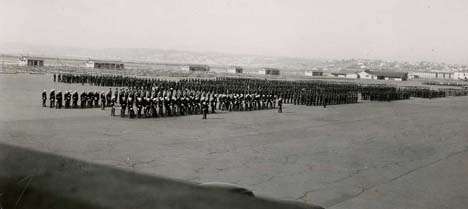
Rannikkojääkärit Trainees on Parade during Selection: Parades and Drill were not an important part of the Selection Course, but they did occur.
After completing the 6 months of Army Basic Training, it was expected that all volunteers for the Rannikkojääkärit were fit, capable of handling all army weapons and had all the basic military tactical skills. The first 4 weeks of the 8 week selection course therefore focused on achieving an increasingly higher level of physical fitness with a strong emphasis on endurance - for example, a Rannikkojääkärit candidate was more likely to spend his time marching with a heavy rucksack than doing push-ups. Marches were usually carried out with "full field equipment" (meaning 40-60kg depending on the task of the soldier) and could often be as long as 80-90km. The ability to operate in a maritime environment was also tested in this first stage. There was a very heavy emphasis on the development of military swimming skills, “drown proofing,” long distance swimming and small boat skills. Generally, conscripts who had completed the admittedly tough Army Basic Training thought they were pretty good. The Rannikkojääkärit Selection Course “gently” disabused them of this notion. It was pointed out from the first day that the Rannikkojääkärit were the elite, the best unit in the Finnish Military – and to be worthy of admittance, you had to be the absolute toughest and the best.
To this end, the Selection Course also emphasized the Finnish military's KKT unarmed combat system. Phsyical and mental aggression and the ability to deal with this was continuously developed, daily KKT sessions took place – these emphasized fear control (including methods of fear control and use of fear energy so as to master the “fight or flight” response and to eliminate inhibiting blocks to instant action in a crisis), encouraged a combat-ready mindset and “attack mindedness”, situational awareness, interactive tactics, attack mindedness, necessary ruthlessness, desensitization to inflicting injury, immunity to surprise or shock when and if injured oneself and so forth. And while the physical side of Selection was tough, most Rannikkojääkärit candidates found the mental part of the training most challenging. Not only were the physical requirements high, but candidates were required to learn and memorize a startling amount of information. Instructors went out of their way to put as much mental pressure on the soldiers as possible without actually breaking them and this was combined with high levels of sleep deprivation. The end result was that most candidates that failed selection, failed in these first four weeks. The second four weeks of Selection continued to emphasis physical endurance and maritime environment skills together with the main elements of Rannikkojääkärit training – maritime environment combat training and small unit tactical skills, weapons handling, tactical mobility and small boat operations. At the end of the 8 week Rannikkojääkärit Selection Course, candidates were subjected to a one week evolution which came to be termed “Paska Week” (‘Shit Week”). This was a one week period of continuous running, swimming, short tactical exercises, gym tests and small boat exercises with as little as 8 hours sleep over the one week period which was designed to test the candidates physical and mental endurance to the maximum.
After five days of this, the final two days of “Paska Week” involved a march of approximately 70km in length over which the Rannikkojääkärit candidates had to navigate themselves carrying 40-45kg of combat equipment. Every 5-10km the candidates were stopped to complete tasks given to them by instructors. Typical tasks were medical evacuation of "wounded" soldiers, shooting, weapons handling or map reading. At one point of the march candidates were put on a boat and transported to an unknown location from which they had to locate themselves on a map and find their way back to the route of the march. The remainder of the candidates who failed selection (usually a further 10-15%) usually failed in the first five days of Paska Week – the final two days were generally an endurance test – if you made it to the end of the two days and completed the march, you passed, although the candidates never knew this. At the end of the two day route march, candidates were told the evolution was over and they had passed selection. After a weekend recovery period, they were awarded the Rannikkojääkärit green beret with the golden sea eagle cap badge at a formal Passing Out Parade.
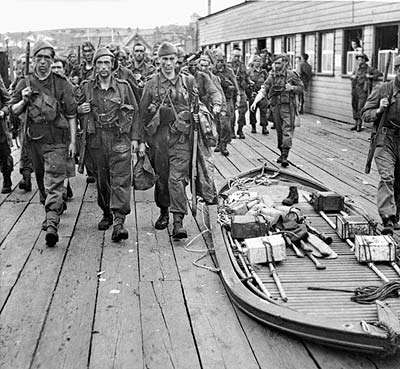
Exhausted looking Rannikkojääkärit Candidates at the end of the two-day Endurance Test – tired and sore, but still going. Note the folding boat to the right, used earlier on the exercise
Continuation Training then started. For soldiers, this consisted of a further 4 months where the emphasis was on developing and practicing marine warfare skills. Officers and NCO’s for these jääkärit were those who had completed Officer and NCO training from the previous intake. The training period for Officers and NCO’s was longer – they completed a six month Officer and NCO Training Course at the Amphibious Warfare School, which was considerably tougher and with a wide scope. This was then followed by a four month period commanding conscripts doing their Continuation Training. At all times during this period, Officers and NCO’s could fail – even in the last week of the four month Command and Leadership evolution – and the pressure was considerable. All in all, Rannikkojääkärit training was, along with Paratroop Jaeger training, the toughest given to any type of infantry in Finland. The results in the Winter War spoke for this.
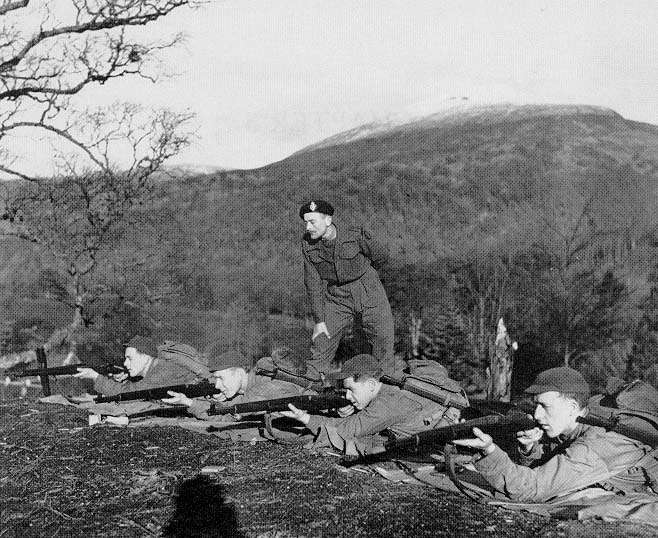
A Rannikkojääkärit Officer supervises a live-firing exercise in the field (note the Officer is wearing the Rannikkojääkärit Green Beret), Summer 1939
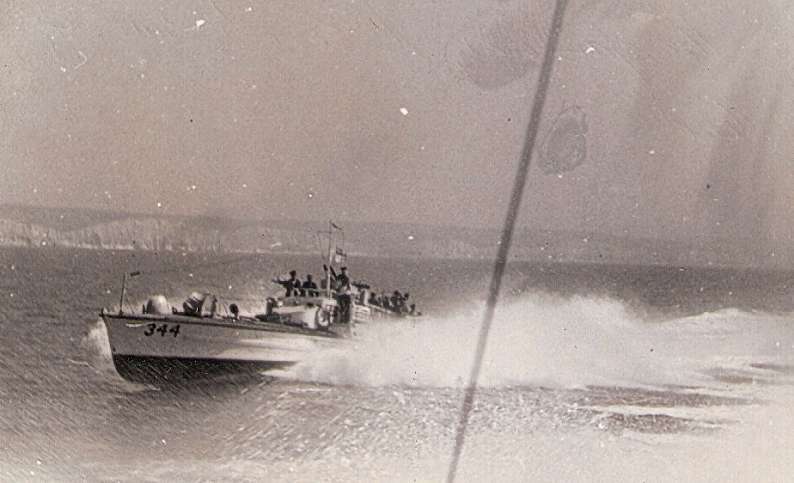
Rannikkojääkärit training came to include operations from the new Motor Torpedoe Boats and the even newer Fast Assault Boats that came into service in the late 1930’s

Rannikkojääkärit Training with Small Boats. Once volunteers passed Selection and entered Continuation Training, the emphasis was on the development of military combat skills and not on etiquette or the meeting of standards for uniforms – note the miscellaneous collection of clothing and headgear.
From 1936 on, Lotta volunteers were also accepted into the Rannikkojääkärit in support and non-combat positions. Female volunteers completed the same training as males, including KKT, but with a lower standard of physical strength and endurance set. Female volunteers were trained separately from males.

Female Rannikkojääkärit volunteers in training - 1937
Divisional Structure
(See US Marine Corps Report and Assessment of the Finnish Marine Division dated 1935 in section below).
Development of Doctrine
The major influence on the Rannikkojääkärit was the US Marine Corps. As mentioned earlier, in late 1931, Marshal Mannerheim had arranged for a number of Officers to be attached to the Marine elements of a number of countries – generally half a dozen officers to each country’s forces. These included the British Royal Marines, the US Marine Corps, the French Troupes Coloniales, the Italian San Marco Battalion, the Royal Netherlands Marine Corps and the Spanish Infantería Marina (lest you doubt, this unit enjoyed success during the Third Rif War in its innovative Alhucemas amphibious assault in 1925, when it employed coordinated air and naval gunfire to support the assault – in 1931 it was officially determined to be a "colonial force" by the Republicans and was denounced as “an instrument of imperialism”. It was sentenced to extinction by the Spanish republican government in 1931 but was still in existence in 1932 when the Finnish Officers were attached to it briefly. From all these various units, the Finns absorbed a wide range of techniques, skills and doctrine.
While many countries were reducing or eliminating their Marine forces in the aftermath of WWI, the US Marine Corps had established their reputation of ferocity and toughness in the battles on the Western Front, including Belleau Wood. Between the World Wars, the Marine Corps was headed from 1920-29 by Commandant John A. Lejeune and under his leadership, the Corps presciently studied and developed amphibious techniques that would be of great use in World War II. At the period the Finnish Officers were attached, the Commandant was Major General Ben H Fuller (1930-33) who was a strong advocate of the Marine Fleet Force concept – essentially, combined arms operations for the Marines. Fuller went out of his way to facilitate the education of the Finnish Officers and initiated an exchange program in 1933 whereby Finnish Officers were attached to the US Marine Corps while US Marine Corps Officers and experienced NCO’s were attached to the Finnish Rannikkojääkärit. The largest group of US Marine Corps Officers and NCO’s served with the Rannikkojääkärit over 1934 and 1935, greatly facilitating the initial establishment of the Rannikkojääkärit, the development of training programs and both strategic and tactical doctrine suited to the Finnish strategic and tactical environment. These officers, together with a small team of US Marine Corp pilots and aircrew who assisted with the Helldiver training, were influential in the development of the combined arms combat techniques and doctrine which were used to great effect in the Winter War and during Finland’s involvement in the Second World War.
1935 Report on the Finnish Marine Jaeger Division prepared for the US Marine Corps (Authored by US Marine Corps Major (deleted), commander of the US Marines Training Detachment on attachment in Finland)
ORGANIZATION AND TRAINING OF FINNISH MARINES
________________________________________
Origin.
In 1934, the Finnish Navy established a Marine Division and requested assistance from the US Marine Corps in establishing structure and organisation, strategic and tactical doctrine and in the establishment of training programs. The Finnish Marine Division is loosely based on the US Marine Divisional organisation, but is strongly influenced by the Finnish Army’s “Combined Arms Regimental Battle Group” structure. The Division is heavily combat-oriented and is structured with far less “tail” than a US Marine Corps Division.
As with all Finnish military units, the Marine Division is largely a Reservist Unit, with the greater part of the personnel being Reservists who have completed their training during their period of Conscript Service. Reservists generally participate in a limited number of weekend training days throughout the year, as well as a one to two week Annual Exercise which is usually carried out at the Battalion level. As of the time of writing this report, 3 Trainee Intakes have completed training and the Division is at approximately half-strength. The Finnish Commanding Officer (Marine Division) estimates that by 1938, the Division will have trained sufficient Marines to be able to operate at full Divisional strength in the event of mobilization.
Selection of Personnel.
Selection of initial Officer and NCO Cadre was made from a combination of appointments by the Commander-in-Chief of the Armed Forces and volunteers from Army Cadre. All other personnel are volunteers doing their compulsory Conscript Service and these fill almost all positions within the Division. Finnish Marine policy is that all trainees must have completed their six month Army Basic Training successfully, and must be volunteers. The first Intake of trainees commenced in 1934, from Volunteers who had just completed their six months of Army Basic Training and consisted of 2,500 men and 350 women.
(Of Note is that the Finnish Marines accept women volunteers for service in non-Frontline positions – generally, women soldiers fill all rear-area service, clerical, support and quartermaster/stores positions. Women complete the same training as male Marines including all-arms combat training – albeit with lower physical fitness standards. Of particular note is that this releases large numbers of male Marines for combat unit roles, something the Finns emphasized was important given their limited manpower. Also of note is that ALL women Marines are always armed with personal weapons and are trained in their use).
Missions.
The primary mission of the Finnish Marines is to take the tactical offensive in counter-attacking any attempted enemy attacks along the Finnish coastline and archipelagoes or in winter, across the frozen sea-ice of the Gulf of Finland. Secondary roles are Raiding attacks on the enemy and the support of Army operations. The objectives of the Finnish Marines were stablished as being:
(1) To conduct counter attacks against enemy landings in the Finnish archipelago, an environment known for its many small islands and skerries,
(2) To carry out raiding attacks from the sea on enemy held positions and
(3) To carry out full-scale attacks from the sea in support of Army operations.
(4) Anticipating that the Gulf of Finland may become completely frozen over, allowing flanking attacks by the enemy across the Ice, to prepare for and be capable of fighting major defensive actions on the Ice while at the same time being capable of taking the tactical offensive against the enemy;
Organization.
The Marine Division functions under the Advisor for Combined Operations (A.C.O.). The A.C.O. acts in an advisory capacity to, and executes the orders of, the Commander-in-Chief of the Finnish Military (currently, Marshal Mannerheim). The staff of the A.C.O. consists of officers of the Maavoimat (Army), Merivoimat (Navy), Ilmavoimat (Air Force), and the Rannikkojääkärit (Marines). The Marine Division is commanded by a Major-General who has both an operational and an administrative staff. The Division, however, does not train, nor does it function normally as a Division, but as separate Regimental Battle Groups which are based in various parts of Finland. The Marine Division is entirely serviced by the Navy.
At this time, approximately 2,500 to 3,000 trainees undergo a six month training period, with two six-month Training Courses run in each year. At the end of the six month training period, Enlisted Marines have completed their compulsory period of military service and are released, at which time they move to “Reserve” status and are required to participate in a limited number of weekend training days together with a short Annual Camp. Current plans are to continue training at this level for the next two years, by which time the Division will have a sufficient number of trained Reservists to fully man the Division in the event of mobilization. At this stage, Marine Selection will become more stringent and selective, with the objective being to train replacement personnel on an ongoing basis.
There are no Direct Entry Officers in the Marines. Every Conscript enters as an Enlisted Man and completes six months of Army Basic Training. There are no exceptions to this requirement. Volunteers for the Marines then complete a two month Selection Course, during which potential Officers and NCO’s are marked by the Training Cadre. On successful completion of Selection, these Officer and NCO candidates are requested to volunteer for Officer and NCO Trainng, which requires 18 months of service overall rather than the 12 months completed by Enlisted Men. Men cannot apply for Officer and NCO Training – they must be selected by the Training Cadre based on their performance during Selection. Following completion of training, additional courses are available to Reservist Officers and NCO’s, who are all members of the Finnish Civil Guard, the Suojeluskuntas, which now has a “Marine” component to it.
The formal organisation of the Finnish Marine Division is as follows:
The Marine Division is made up of 3 Regimental Battle Groups with a Divisional HQ and a Training Wing attached to the Divisional HQ. Divisonal HQ is largely administrative and aside from logistical support and administration, is responsible for the Training of Marines, with approximately 2,500-3,000 volunteers in a Training Intake in any one six month period. Over 1934 and 1935, some 8,000 Marines have successfully completed training and are formed up into the 3 Regimental Battle Groups (currently these are all at approximately half strength. It is anticipated by the Divisional HQ that by year-end 1937, sufficient Marines will have been trained for all 3 Regimental Combat Groups to be up to strength on mobilization. In the event of mobilization, plans call for the current training Intake to be held back as “replacements” for casualties and for the next twelve months Intake Class to be called up and trained in one Intake, possibly to form a fourth Regimental Battle Group on completion of what would be “accelerated” training.
Regimental Battle Group
o Regimental HQ
- HQ
- Security Company
- Signals Company
- Recconaissance Company
- Pioneers Company (Engineers)
o Marine Strike Battalion I (Iskupataljoona – xxxx men)
o Marine Strike Battalion II (Iskupataljoona – xxxx men)
o Marine Strike Battalion II (Iskupataljoona – xxxx men)
o Heavy Weapons Battalion
- 2 x Field Artillery Battalions (12 Field Guns each, 24 in total)
- Anti-Aircraft Company (12 AA Guns)
- Mortar Company (12 x 81mm Mortars)
o Regimental Tail
- Supplies Company
- Ammunition Supply Company
- Transport Company
- Field Kitchen Company
- Field Hospital + Ambulance Platoon
- Vehicle Repair and Fuel Supply Unit
- Field Hospital for Horses
- Field Post Office
- Clothing Depot
Note that the Regimental Battle Group, as it is termed in Finnish military nomenclature, is a fully self-contained organisation with its own integral artillery battalions together with all necessary support, including logistics. Strategic assets are controlled at Corps or Military HQ level rather than subdivided down into Divisional assets.
Marine Strike Battalion (Iskupataljoona)
o Battalion HQ
- HQ
- Security Platoon
- Signals Platoon
- Recconaissance Platoon
o Strike Company I (Iskukomppania – 124 men)
o Strike Company II (Iskukomppania – 124 men)
o Strike Company III (Iskukomppania – 124 men)
o Support Company
- Mortar Platoon (4 x 81mm Mortars)
- Pioneer Platoon (Engineers)
- Anti-tank Platoon (4 x AT Guns)
- AA Gun Platoon (4 x AA Guns)
- Heavy Machinegun Platoon
o Logistics Company
- Transport Platoon
- Ammunition Supplies Platoon
- Supplies Platoon
- Boat Platoon
- Medical Platoon
- Battalion Admin Section
Marine boat transport varies as the Marine Division has no purpose-built boats (although planning has begun to acquire these, this is not expected to be completed in the short-term future). Marines are generallycarried to their destimation on Navy boats where these are available, otherwise civilian motor launches and fishing boats are used. Generally, each launch or boat is capable of transporting 1 to 2 sections of Marines and when I use, is fitted with a Maxim machinegun in the bow for fire support. The maximum speed of these boats is modest by military standards and the pace is usually set by the slowest boat of the group. Where motor boats are not available, rowing boats are used, and canoes are often used by the Reconnaissance Platoons.
While the TOE calls for large numbers of Mortars, Anti-tank Guns, AA Guns and Machineguns, these are generally not available. The Finnish Military have various acquisition programs underway and the apparent target is to have the TOE up to strength over as five year period. Much of the current strength in equipment is however only on paper.
Marine Strike Company ((Iskukomppania – 124 men)
o Company HQ (29 men)
- Company Commander
- Command Squad (6 man Sigs/Messenger Section, 4 man Sniper Section, 9 man AT Section)
- Supplies Section (1 Sgt, 7 men)
o Strike Platoon I (Iskukomppania – 32 men)
- Platoon Command Squad (1 Officer, 1 Sgt, 1 Sig, 2 Messengers, 1 Medic, 2 man Sniper Team)
- Rifle Squad I (Corporal, 2 man LMG Team, 2 SMG Men, 3 Riflemen)
- Rifle Squad II (8 men, as above)
- Rifle Squad III (8 men, as above)
o Strike Platoon II (Iskukomppania – 32 men)
o Strike Platoon III (Iskukomppania – 32 men)
Strike Companies are generally heavy on automatic firepower, with provision in the TOE for numerous light machineguns and submachineguns. The Marines also put a heavy emphasis on the use of Snipers (6 x 2 man Sniper Teams within the Company strength of 124 men). Provision is also made for 4 x 2 man Anti-Tank Rifle Teams under the control of the Company Command Squad, although at this time it should be noted that Anti-Tank Rifles are not available). The Marines also put a great deal of emphasis on Signals and communications. Plans are apparently underway for units down to the Platoon-level to be equipped with Radios at some stage (these are apparently under development in a secret project, details of which were not divulged – at present Field Telephones and Messengers are used). There is one Medic in each Platoon Command Squad and usually at least one man in each Section has also completed Medic Training. All Marines are expected to qualify as Expert Marksman, and Sniper Training is encouraged. Also noted was that the standard Section strength of 8 men is exactly suitable for embarking in the small Dory-type boats that the Marines use in training.
Weapons.
Although the establishment (Tables of Organization) provides a definite allowance and allocation of weapons, neither the numbers of weapons nor their distribution is rigidly adhered to. In every case the distribution of weapons is made according to the tactical requirements of the particular mission to be performed. Each Regimental Battle Group has a separate store of extra weapons and thus extreme flexibility in armament is assured. A typical store contains:
Maxim Machineguns; Suomi Submachineguns; 81mm mortars and a supply of both smoke and HE shell for each; defensive (fragmentation) hand grenades; smoke pots; Flare pistols; knuckle dusters; explosives for demolitions of all types.
Normally each Platoon is allocated one Maxim machinegun and one Suomi submachinegun per section. The allocation of the 81mm mortars is left entirely to the Commander who employs them according to the requirements of the situation. As indicated above, additional weapons are available in stores and may be assigned. The important point to note is the extreme flexibility in armament and the degree of initiative permitted Platoon and Company leaders in its distribution.
Clothing and Equipment.
Clothing and equipment furnished Marines includes a variety of types thus permitting flexibility in dress and battle equipment. Normal clothing is "battle dress," a two piece woolen garment, stout boots and anklets (short leggings). In colder weather a sleeveless button-up leather jacket which reaches the hips is worn over or under battle dress. A two piece waterproofed denim dungaree-type coverall is also provided for wear over battle dress in damp or rainy weather. In addition to the ordinary hobnailed boots, a rubber soled shoe and a rope soled shoe are provided for missions that require stealthy movements over paved roads, through village streets, for cliff climbing, and so forth. A heavy ribbed wool jersey with long sleeves and turtle neck and a wool undervest and woolen hat and gloves are also available for cold weather wear. Overcoats may be worn at any time during training or operations in severe weather. A white “snowsuit” overall is worn during winter operations for concealment against snow or ice. All clothing is designed and worn with the sole purpose in view of comfort and utility under actual operating conditions. There are no specific uniform requirements for operations – again, this is at the discretion of the unit commander. No leather belts are worn either by officers or enlisted men. A fabric waist belt is provided for wear when deemed appropriate. Finnish Marines cold-weather clothing is highly effective and well-suited to the climatic extremes of the Finnish Winter. Marines are allowed to wear their own winter clothing beneath uniforms in Winter weather, with no requirement for uniformity. While the Marines look what we would term as “sloppy”, this in no way impairs their fighting effectiveness or unit and combat discipline, which is exemplary.
Basically, every officer and man is provided with standard army field equipment similar to our own but this may be augmented or discarded as needed. In addition, certain special equipment is available in Marine stores and is issued to individuals or troops as the occasion requires. Principal items are listed below:
Fighting knife; Individual cooker; Compass; Field rations; skiis and poles; individual life belt; Primus stoves; one gallon thermal food containers; gas cape; wristlets; 2 man rubber boat; plywood (sectionalized) canoe; collapsible canvas canoe; bamboo and canvas stretchers; 2" scaling ropes; 1" mesh heavy wire (6' x 24") in rolls for crossing entanglements (see under "Training"); Toggle ropes (see under "Training"); Transportation equipment for Reserve units (administrative) is generally civilian and the personal property of Reservists;
Communication equipment: Radio sets (portable voice and key type, weight 36 lbs, voice range 5 miles), Semaphore flags, Blinker guns, Flare pistols and flares.
Training.
Marine training is conducted along the following lines:
It seeks the development of a high degree of stamina and endurance under any operating conditions and in all types of climate.
It seeks to perfect all individuals in every basic military requirement as well as in special work likely to be encountered in operations viz: swimming, boatwork, wall climbing, skiing and so forth.
It aims to develop a high percentage of men with particular qualifications, viz: motorcyclists, truck drivers, small boat operators, marine engine engineers, etc.
It aims to develop self confidence, initiative and ingenuity in the individual and in the group.
It seeks to develop perfect team work in operating and combat.
All men volunteering for service in the Marines are personally interviewed by an officer.
In its training the Marine Division is prepared to accept casualties in training rather than to suffer 50% or higher battle casualties because of inexperienced personnel. All training is conducted with the utmost reality and to the end that the offensive spirit is highly developed. Wide latitude is accorded commanders in the training methods employed, and thus the development of initiative, enterprise, and ingenuity in the solution of battle problems, and the development of new techniques is encouraged. A corresponding latitude is accorded unit commanders. Only the highest standards are acceptable and if officers and men are unable to attain them, they are returned to the Army immediately. Leaves are accorded Marine personnel during prolonged training periods in order to prevent men "going stale."
An appreciation of the type of training conducted by Marines may be arrived at by brief descriptions of observed routine training executed by five different Marine Training Companies over a period of five days.
Assault Course.
All obstacle assault courses are not the same but vary in accordance with terrain and are generally constructed from whatever materials are available locally.
Swimming.
All Marines are taught to swim, and lengthy sea-swims are a common occurrence – daily during Selection and at least twice a week during what the Finns call “Continuation Training.” Sea-swims of ten miles are not uncommon.
Cliff and Rock Climbing.
Marines receive special training in cliff and rock climbing and Marines are sent from time to time to appropriate regions for practice.
Demolitions.
A general course is given to all members of the Marines in demolitions and more detailed instructions are given to a demolition group within each Company. These specially trained groups are taught demolition as affecting bridges, rail installations, machinery, oil tanks, etc. They are taught how to crater and to blow buildings to provide temporary road blocks. At xxx on December 3 1934, during the course of a night problem (attack on a village), in which three Platoons participated, the following demolitions were employed: Explsove torpedoes for gapping wire, booby traps installed in likely avenues of approach, and well camouflaged piano trip wires set to explode land mines. The explosive torpedoes were real enough but booby traps and land mines were represented by detonators. Very few booby traps were exploded as men kept their wits about them and their eyes open. Sufficient training allowance of all types of high explosives, fuzes, and detonators is made available so that this important training is continuous. TNT amd Nitro-starch are employed as explosives.
Street Fighting.
House to house street fighting is extensively practiced.
Unarmed Combat and Combat with Knives and Hand Weapons
The Finnish Military has evolved a specialized technique of hand-to-hand combat they call KKT. KKT utilizes a variety of fighting techniques together with the use of knives, machetes, entrenching tools and any other item that can be used as a weapon. The technique emphasizes an aggressive mindset and the ability to keep on fighting even if injured. Finnish Marines generally participate in lengthy KKT sessions on a daily basis, even when in the Field, and KKT techniques such as sentry removal are regularly practiced. It seems a highly effective fighting technique.
Field Combat Firings.
Both day and night field firings were observed. In one night firing exercise, a Platoon fired on low silhouette targets at a range of about 150 yards. The terrain was rolling countryside. A light rain was falling. Illumination was provided by flares fired from the flank. It was attempted to keep the flares 50 yards in front of the targets. Machine gunners posted on the flanks of each subsection fired with the subsection. Approximately 80% hits were scored out of an average 170 rounds fired per section.
Much time is devoted to tactical problems ("schemes") in which live ammunition is fired by all weapons. The strikingly effective use of smoke in assault at night was shown.
Marches.
On December 5, 1934, one Platoon of Marines executed a forced march of fourteen miles in two hours. Equipment: combat packs and rifles, uniform: battledress and steel helmets. This march took place along a macadam road through rolling countryside. The weather was chilly with light snow.
Obstacles.
On December 3, and December 5 1934, different Platoons were observed crossing barbed wire obstacles. Training and overcoming obstacles include:
1. Action against triple concertina.
2. Action against double-apron fence.
(In attacking any type of wire fastened securely to screw pickets, the pickets themselves on each side of the bay of wire to be crossed are seized by the leading men and bent to the ground, thus materially aiding in the wire-crossing.)
3. Use of Explsove Torpedoes
Wall-Scaling.
1. Walls 10 - 12 feet high.
2. Walls 20 feet high.
Stream Crossings.
Stealth and initiative in field operations.
Platoon and Section operational methods of infiltration.
Discipline and Morale.
To all appearances the discipline and morale of Marines is exceptionally high. This may be in large measure accounted for by the fact that all Marine personnel are selected volunteers who applied for this type of duty because of the prospects of more challenging training and the “image” of the Marines as more action-oriented and with less emphasis on Drill and Regulations than the Army.
In talks with officers and senior NCO’s we gained the impression that unit discipline is largely self imposed and that the application of disciplinary measures by commanders is a rare necessity. Respect for rank is observed but there is no saluting or standing to attention when enlisted men talk to Officers or NCO’s or when giving or receiving orders. No rank identification is worn in the field or at any time except on formal Parades and Officers, NCO’s and Enlisted Men dress and are equipped completely identically (to the extent that Officers carry Rifles or SMG’s – and almost all personnel are equipped with a Pistol as a “reserve” weapon in additiona to their standard Rifle or SMG). Officers and NCO’s are expected to know their men individually and to lead from the front or by example at all times. Marine Officer and NCO training emphasizes the “Follow Me” rather than the “Do this or that” approach.
An excellent spirit of fellowship prevails between officers, NCO’s and enlisted men and is evident in all training and exercises. Officers and NCO’s participate in all exercises with the men and two half days a week are set aside for sports. All are required to take part in one form or another.
Officers, NCO’s and enlisted men in training live on base or in the field, with a large amount of time spent in the field on exercises. Contrary to the expectations of most officers the large amount of time spent in the field, when combined with generous weekend leave, has had a very positive effect on morale.
Undoubtedly the fact that commanders have the prerogative of immediately returning a man to the Army for breaches of discipline or inaptitude for Marine duties has an important effect in maintaining the existing high disciplinary level.
The varied and realistic nature of the training undertaken is likewise an aid to morale. Current events talks are given weekly by all Platoon commanders using material furnished by the ABCA (Army Bureau of Current Affairs). Outside speakers, (Naval, Army and Air Force Officers, Civilians, University Professors and so on) give regular talks on the larger aspects of the the military, economics, industry etc. and try to make these relevant to the Marines military objectives These all broaden the Marines' point of view and dispel boredom.
Frequent weekends are granted from Friday P.M. to Monday A.M., and liberal leave policy obtains. The men are not allowed to go stale in training.
Conclusions.
The Finnish Marines are evolving as an effective fighting force with high disciplinary standards and morale. Combat effectiveness is adjudged to be high and some of the innovative approaches taken (unarmed combat training, use of women in non-combat positions, high ratio of “fighters” to “tail”, flexibility in weapons and dress, variety of training) could well be examined in more detail with a view to possible adoption.
The Combined Arms Regimental Battle Group concept that the Finnish military is adopting is also worthy of further examination. The rationale behind this, as explained by the Finnish Commander-in-Chief, is that the Divisional structure is too complex, too large, centralizes too many capabilities at a high level, deploys too slowly, and is too vulnerable to attacks on centralized assets. The centralization of too many critical warfighting assets at the divisional level means that the the brigade force that emerges from this structure lacks cohesion as key assets such as artillery are under divisional control and not immediately available when needed, joint command and control slows the command decision-making process, communications and intelligence is at a divisional level and intelligence in particular is slow to filter down to the fighting units and the division itself is very slow to deploy.
The Finnish Military’s Combined Arms Regimental Battle Group is an all arms Combat Group of roughly 5,000 troops with embedded command, control, communications and intelligence as well as key supporting assets such as Artillery and Supply, the division and brigade echelons are compressed into one echelon that enables: (1) Integration with other services at a lower level than the traditional division; and, (2) far greater operational independence in smaller formations. This reorganized formation provides a far more agile and responsive force mix that is based on the way the Finnish military intends to fight rather than on “garrison” formations that make administration easier. The whole ethos of the Finnish Military is, as expressed by the C-in-C, “More Teeth, Less Tail!” The Regimental Battle Group organization is intended to eliminate "unnecessary" headquarters, place the necessary combat assets under one commander, streamline the logistics tail (and man as much as possible of the “tail” with women Marines) and move the personnel savings back to the units that actually deploy and fight.
The Finnish Combined Arms Regimental Battle Group is on the one hand larger than a traditional Brigade, but on the other hand smaller and more flexible than the traditional Division. In addition, a heavy emphasis in training is placed on the development of Combined Arms fighting techniques and skills. The Battle Group trains as one unit with all assets, and with a significant amount of cross training. Task Forces can be put together from a varying number of Regimental Battle Groups suited to the mission, and this is something the Finnish Military has begun to cover in Staff Training exercises. The Divisional HQ still exists, but as a logistical support and administration unit rather than as a Command and Control layer. It remains to be seen how this concept will work out in battle but it is certainly worthy of investigation on the part of the US Marine Corps.
End of Report. ..
Note: The author of this report, on his return to the US, made a number of attempts to have the US Marine Corps further study the Finnish Rregimental Battle Group concept but was either ignored or overruled. As the world would discover in 1940 when Germany's Armored Battle-groups overran France, the full impact of the new technology in war was achieved after the German Army changed the way their armored armed forces were organized, trained, led and employed in action together with other air and ground elements – and only at this stage did the world begin to understand the new concepts – and at that, only slowly.
That this Combined Arms Battlegroup concept was first successfully employed by the Finnish Military, and with far more devastating effect than the Germans, was something that passed the rest of the world by. The sole exception was Germany, large due to the beating they took from the Finnish Military in Norway – the first defeat the Germans suffered in WW2 and again, one that the rest of the world missed due to the debacle in France. The British Army, units of which fought alongside the Finns in Norway, had the opportunity to learn, but again, in the aftermath of Dunkirk and then the turmoil in North Africa, missed this opportunity, as they would miss so many other lessons that could have been learnt from the Winter War.
Winter War.
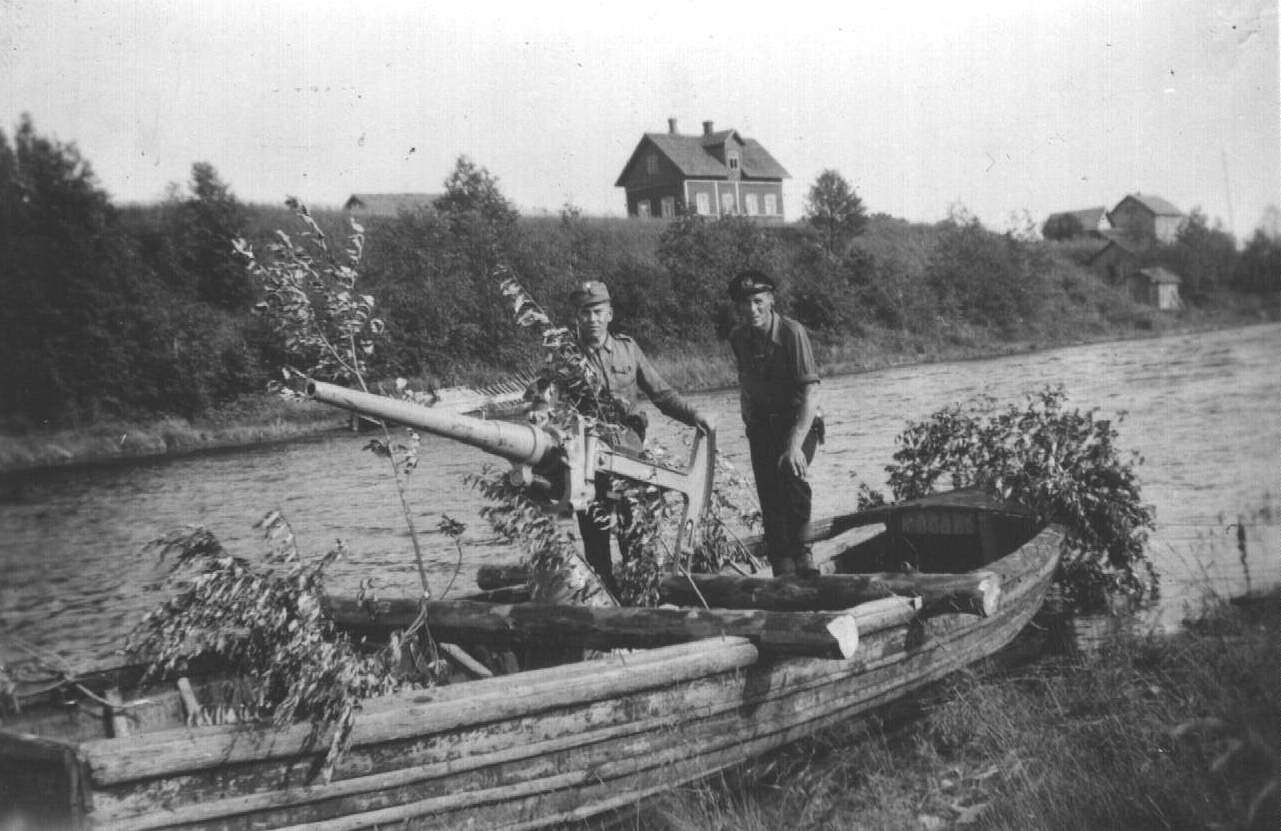
In the early days, improvisation was the name of the game....

A civilian launch being used on a Marine Reservist training weekend exercise - Summer 1936
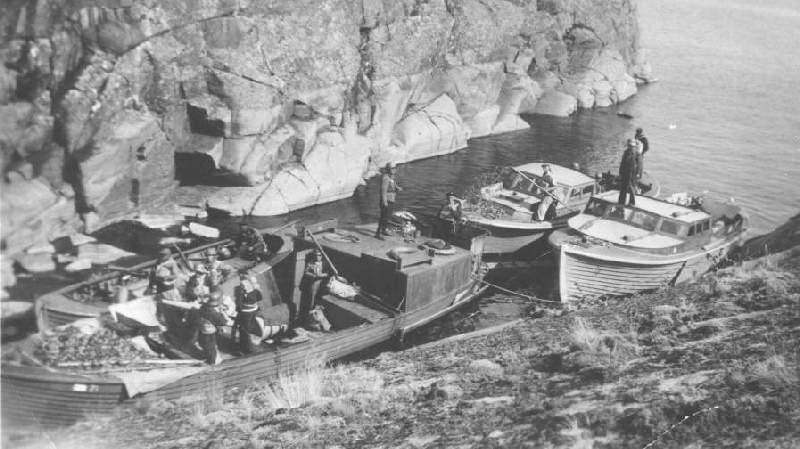
On exercise on Lake Laatoka, 1937

The Marine Jaegers new Fast Assault Boat was introduced in mid-1938 and was derived from the Motor Torpedo Boats designed and starting to come into service from the mid-1930's. Capable of carrying two sections (16 men), 2 of these fast boats could carry a Platoon at a maximum speed of 35 knots. Some 35 of these Boats were in service at the time of the Winter War. They proved useful in rushing reinforcements to islands that came under Soviet attack early in the Winter War, capable of moving the best part of half a Battalion in one movement. The Fast Assault Boat was designed for the Marine Jaegers by the american boat designer and manufacturer, Andrew Higgins, with whom the Merivoimat had developed a close relationship while finalizing the design of their Motor Torpedo Boats and Fast Minelayers. In the end, these Fast Assault Boats would prove more useful in fighting the Germans in 1944 and 1945
So, just put the blinkers on and pretend to yourself this is a filmclip of a training exercise from 1939!!! (Sorry, best I can do)
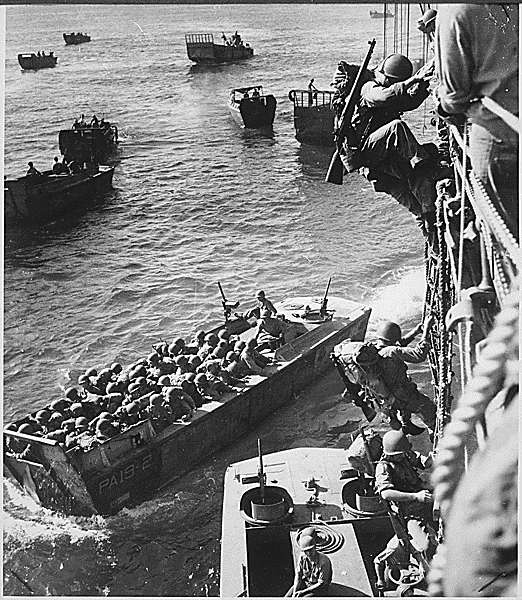
Rannikkojääkärit boarding Suomen Merivoimat Higgins-Class Assault Landing Craft in mid-1944 shortly before the amphibious assault into East Prussia which cut off the German forces still fighting in Lithuania. At this stage of the war, the Finnish entry on the Allied side had resulted in the supply to Finland of large quantities of American equipment – in marked contrast to the period of the Winter War.
Part IV - Finnish Coastal Defences of the 1930’s
While the Coastal Defence Divisions and Coastal Artillery Batteries and fortresses were focused on the defence of the coastline against any attempt at seaborne invasion, another outcome of the 1931 Military Review was the identification of the need for an offensive capability in the seas and on the islands surrounding Finland, particularly along the shore and archipelagoes of the Gulf of Finland. This capability should be not just defensive, but capable of taking the tactical initiative and attacking the enemy anywhere along the Baltic littoral, but with an emphasis on the Gulf of Finland. The decision was made that an elite Division, the Marine Jaegers (Rannikkojääkärit) would be formed to fufill this need and that this Division would be part of the Suomen Merivoimat (Navy) rather than the Army. Also anticipating potential command and control disputes, the decision was also made that the Marine Jaeger Division would have it’s own integrated Air Arm dedicated to close support and protection of the Marine Jaeger Division in combat.
The Marine Jaeger Division
Established in late 1934 by a direct order of Marshal Mannerheim’s, the Finnish Marine Jaegers (Rannikkojääkärit) were formed as the elite marine infantry arm of the Finnish Navy. Their insignia was the head of a sea-eagle in gold.The objectives of the Rannikkojääkärit were laid out as being:
(1) To conduct counter attacks against enemy landings in the Finnish archipelago, an environment known for its many small islands and skerries,
(2) To carry out raiding attacks from the sea on enemy held positions and
(3) To carry out full-scale attacks from the sea in support of Army operations.
(4) Anticipating that the Gulf of Finland may become completely frozen over, allowing flanking attacks by the enemy across the Ice, to prepare for and be capable of fighting major defensive actions on the Ice while at the same time being capable of taking the tactical offensive against the enemy;
An additional Battalion-sized unit Rannikkojääkärit formation (separate from the Marine Division itself) was to be trained as an elite unit for unconventional warfare, beach and coastline reconnaisance and reconnaissance behind enemy lines. This unit was also tasked with developing the capability to operate in and from the many lakes and swamps of Finland, and to train the Marine Division and Army units in these techniques. (A subsequent Post will examine this unit in
A small integrated Merivoimat Air Arm was formed up at the same time, with an allocated Table of Organisation of Two Fighter Squadrons, Two Dive Bomber Squadrons, One Reconnaisance Squadron and One Transport Squadron – although initially there were no aircraft or personnel. This would come later.
Selection and Training
While all Finnish males performed compulsory military service, only volunteers were accepted for the Rannikkojääkärit. The Division’s new training base was constructed at Nylands, near Ekenäs. After completion of the initial 6 months of Army Basic Training that all conscripts carrying out compulsory military service were required to complete, conscripts could voluntarily apply for service in the Rannikkojääkärit. Entry was by way of a tough 8 week selection course, with an emphasis on physical fitness, ability to operate in a maritime environment and cross-training. Interestingly, about 85% of volunteers passed the selection process – the Rannikkojääkärit Training Instructors were both tough and stubborn, and a strong emphasis was put on “encouraging” candidates who weren’t up to standard. Basically, it was a whole lot easier to get into the Rannikkojääkärit Selection Course than it was to get out of it, and over time the implacability of the Selection Course Instructors, and the pain and suffering experienced by candidates who were initially “below standard” became part of the Rannikkojääkärit “Myth.” Following the 8 week Selection Course, a further 4 months of specialized training was undertaken. Conscript volunteers were selected for NCO training during the initial 8 week Rannikkojääkärit Selection Course, while candidates for Rannikkojääkärit Officer Training were selected during the 8 week long Stage 1 of NCO training. About 10-20% of Stage 1 NCO candidates became officer candidates.

Rannikkojääkärit Trainees on Parade during Selection: Parades and Drill were not an important part of the Selection Course, but they did occur.
After completing the 6 months of Army Basic Training, it was expected that all volunteers for the Rannikkojääkärit were fit, capable of handling all army weapons and had all the basic military tactical skills. The first 4 weeks of the 8 week selection course therefore focused on achieving an increasingly higher level of physical fitness with a strong emphasis on endurance - for example, a Rannikkojääkärit candidate was more likely to spend his time marching with a heavy rucksack than doing push-ups. Marches were usually carried out with "full field equipment" (meaning 40-60kg depending on the task of the soldier) and could often be as long as 80-90km. The ability to operate in a maritime environment was also tested in this first stage. There was a very heavy emphasis on the development of military swimming skills, “drown proofing,” long distance swimming and small boat skills. Generally, conscripts who had completed the admittedly tough Army Basic Training thought they were pretty good. The Rannikkojääkärit Selection Course “gently” disabused them of this notion. It was pointed out from the first day that the Rannikkojääkärit were the elite, the best unit in the Finnish Military – and to be worthy of admittance, you had to be the absolute toughest and the best.
To this end, the Selection Course also emphasized the Finnish military's KKT unarmed combat system. Phsyical and mental aggression and the ability to deal with this was continuously developed, daily KKT sessions took place – these emphasized fear control (including methods of fear control and use of fear energy so as to master the “fight or flight” response and to eliminate inhibiting blocks to instant action in a crisis), encouraged a combat-ready mindset and “attack mindedness”, situational awareness, interactive tactics, attack mindedness, necessary ruthlessness, desensitization to inflicting injury, immunity to surprise or shock when and if injured oneself and so forth. And while the physical side of Selection was tough, most Rannikkojääkärit candidates found the mental part of the training most challenging. Not only were the physical requirements high, but candidates were required to learn and memorize a startling amount of information. Instructors went out of their way to put as much mental pressure on the soldiers as possible without actually breaking them and this was combined with high levels of sleep deprivation. The end result was that most candidates that failed selection, failed in these first four weeks. The second four weeks of Selection continued to emphasis physical endurance and maritime environment skills together with the main elements of Rannikkojääkärit training – maritime environment combat training and small unit tactical skills, weapons handling, tactical mobility and small boat operations. At the end of the 8 week Rannikkojääkärit Selection Course, candidates were subjected to a one week evolution which came to be termed “Paska Week” (‘Shit Week”). This was a one week period of continuous running, swimming, short tactical exercises, gym tests and small boat exercises with as little as 8 hours sleep over the one week period which was designed to test the candidates physical and mental endurance to the maximum.
After five days of this, the final two days of “Paska Week” involved a march of approximately 70km in length over which the Rannikkojääkärit candidates had to navigate themselves carrying 40-45kg of combat equipment. Every 5-10km the candidates were stopped to complete tasks given to them by instructors. Typical tasks were medical evacuation of "wounded" soldiers, shooting, weapons handling or map reading. At one point of the march candidates were put on a boat and transported to an unknown location from which they had to locate themselves on a map and find their way back to the route of the march. The remainder of the candidates who failed selection (usually a further 10-15%) usually failed in the first five days of Paska Week – the final two days were generally an endurance test – if you made it to the end of the two days and completed the march, you passed, although the candidates never knew this. At the end of the two day route march, candidates were told the evolution was over and they had passed selection. After a weekend recovery period, they were awarded the Rannikkojääkärit green beret with the golden sea eagle cap badge at a formal Passing Out Parade.

Exhausted looking Rannikkojääkärit Candidates at the end of the two-day Endurance Test – tired and sore, but still going. Note the folding boat to the right, used earlier on the exercise
Continuation Training then started. For soldiers, this consisted of a further 4 months where the emphasis was on developing and practicing marine warfare skills. Officers and NCO’s for these jääkärit were those who had completed Officer and NCO training from the previous intake. The training period for Officers and NCO’s was longer – they completed a six month Officer and NCO Training Course at the Amphibious Warfare School, which was considerably tougher and with a wide scope. This was then followed by a four month period commanding conscripts doing their Continuation Training. At all times during this period, Officers and NCO’s could fail – even in the last week of the four month Command and Leadership evolution – and the pressure was considerable. All in all, Rannikkojääkärit training was, along with Paratroop Jaeger training, the toughest given to any type of infantry in Finland. The results in the Winter War spoke for this.

A Rannikkojääkärit Officer supervises a live-firing exercise in the field (note the Officer is wearing the Rannikkojääkärit Green Beret), Summer 1939

Rannikkojääkärit training came to include operations from the new Motor Torpedoe Boats and the even newer Fast Assault Boats that came into service in the late 1930’s

Rannikkojääkärit Training with Small Boats. Once volunteers passed Selection and entered Continuation Training, the emphasis was on the development of military combat skills and not on etiquette or the meeting of standards for uniforms – note the miscellaneous collection of clothing and headgear.
From 1936 on, Lotta volunteers were also accepted into the Rannikkojääkärit in support and non-combat positions. Female volunteers completed the same training as males, including KKT, but with a lower standard of physical strength and endurance set. Female volunteers were trained separately from males.

Female Rannikkojääkärit volunteers in training - 1937
Divisional Structure
(See US Marine Corps Report and Assessment of the Finnish Marine Division dated 1935 in section below).
Development of Doctrine
The major influence on the Rannikkojääkärit was the US Marine Corps. As mentioned earlier, in late 1931, Marshal Mannerheim had arranged for a number of Officers to be attached to the Marine elements of a number of countries – generally half a dozen officers to each country’s forces. These included the British Royal Marines, the US Marine Corps, the French Troupes Coloniales, the Italian San Marco Battalion, the Royal Netherlands Marine Corps and the Spanish Infantería Marina (lest you doubt, this unit enjoyed success during the Third Rif War in its innovative Alhucemas amphibious assault in 1925, when it employed coordinated air and naval gunfire to support the assault – in 1931 it was officially determined to be a "colonial force" by the Republicans and was denounced as “an instrument of imperialism”. It was sentenced to extinction by the Spanish republican government in 1931 but was still in existence in 1932 when the Finnish Officers were attached to it briefly. From all these various units, the Finns absorbed a wide range of techniques, skills and doctrine.
While many countries were reducing or eliminating their Marine forces in the aftermath of WWI, the US Marine Corps had established their reputation of ferocity and toughness in the battles on the Western Front, including Belleau Wood. Between the World Wars, the Marine Corps was headed from 1920-29 by Commandant John A. Lejeune and under his leadership, the Corps presciently studied and developed amphibious techniques that would be of great use in World War II. At the period the Finnish Officers were attached, the Commandant was Major General Ben H Fuller (1930-33) who was a strong advocate of the Marine Fleet Force concept – essentially, combined arms operations for the Marines. Fuller went out of his way to facilitate the education of the Finnish Officers and initiated an exchange program in 1933 whereby Finnish Officers were attached to the US Marine Corps while US Marine Corps Officers and experienced NCO’s were attached to the Finnish Rannikkojääkärit. The largest group of US Marine Corps Officers and NCO’s served with the Rannikkojääkärit over 1934 and 1935, greatly facilitating the initial establishment of the Rannikkojääkärit, the development of training programs and both strategic and tactical doctrine suited to the Finnish strategic and tactical environment. These officers, together with a small team of US Marine Corp pilots and aircrew who assisted with the Helldiver training, were influential in the development of the combined arms combat techniques and doctrine which were used to great effect in the Winter War and during Finland’s involvement in the Second World War.
1935 Report on the Finnish Marine Jaeger Division prepared for the US Marine Corps (Authored by US Marine Corps Major (deleted), commander of the US Marines Training Detachment on attachment in Finland)
ORGANIZATION AND TRAINING OF FINNISH MARINES
________________________________________
Origin.
In 1934, the Finnish Navy established a Marine Division and requested assistance from the US Marine Corps in establishing structure and organisation, strategic and tactical doctrine and in the establishment of training programs. The Finnish Marine Division is loosely based on the US Marine Divisional organisation, but is strongly influenced by the Finnish Army’s “Combined Arms Regimental Battle Group” structure. The Division is heavily combat-oriented and is structured with far less “tail” than a US Marine Corps Division.
As with all Finnish military units, the Marine Division is largely a Reservist Unit, with the greater part of the personnel being Reservists who have completed their training during their period of Conscript Service. Reservists generally participate in a limited number of weekend training days throughout the year, as well as a one to two week Annual Exercise which is usually carried out at the Battalion level. As of the time of writing this report, 3 Trainee Intakes have completed training and the Division is at approximately half-strength. The Finnish Commanding Officer (Marine Division) estimates that by 1938, the Division will have trained sufficient Marines to be able to operate at full Divisional strength in the event of mobilization.
Selection of Personnel.
Selection of initial Officer and NCO Cadre was made from a combination of appointments by the Commander-in-Chief of the Armed Forces and volunteers from Army Cadre. All other personnel are volunteers doing their compulsory Conscript Service and these fill almost all positions within the Division. Finnish Marine policy is that all trainees must have completed their six month Army Basic Training successfully, and must be volunteers. The first Intake of trainees commenced in 1934, from Volunteers who had just completed their six months of Army Basic Training and consisted of 2,500 men and 350 women.
(Of Note is that the Finnish Marines accept women volunteers for service in non-Frontline positions – generally, women soldiers fill all rear-area service, clerical, support and quartermaster/stores positions. Women complete the same training as male Marines including all-arms combat training – albeit with lower physical fitness standards. Of particular note is that this releases large numbers of male Marines for combat unit roles, something the Finns emphasized was important given their limited manpower. Also of note is that ALL women Marines are always armed with personal weapons and are trained in their use).
Missions.
The primary mission of the Finnish Marines is to take the tactical offensive in counter-attacking any attempted enemy attacks along the Finnish coastline and archipelagoes or in winter, across the frozen sea-ice of the Gulf of Finland. Secondary roles are Raiding attacks on the enemy and the support of Army operations. The objectives of the Finnish Marines were stablished as being:
(1) To conduct counter attacks against enemy landings in the Finnish archipelago, an environment known for its many small islands and skerries,
(2) To carry out raiding attacks from the sea on enemy held positions and
(3) To carry out full-scale attacks from the sea in support of Army operations.
(4) Anticipating that the Gulf of Finland may become completely frozen over, allowing flanking attacks by the enemy across the Ice, to prepare for and be capable of fighting major defensive actions on the Ice while at the same time being capable of taking the tactical offensive against the enemy;
Organization.
The Marine Division functions under the Advisor for Combined Operations (A.C.O.). The A.C.O. acts in an advisory capacity to, and executes the orders of, the Commander-in-Chief of the Finnish Military (currently, Marshal Mannerheim). The staff of the A.C.O. consists of officers of the Maavoimat (Army), Merivoimat (Navy), Ilmavoimat (Air Force), and the Rannikkojääkärit (Marines). The Marine Division is commanded by a Major-General who has both an operational and an administrative staff. The Division, however, does not train, nor does it function normally as a Division, but as separate Regimental Battle Groups which are based in various parts of Finland. The Marine Division is entirely serviced by the Navy.
At this time, approximately 2,500 to 3,000 trainees undergo a six month training period, with two six-month Training Courses run in each year. At the end of the six month training period, Enlisted Marines have completed their compulsory period of military service and are released, at which time they move to “Reserve” status and are required to participate in a limited number of weekend training days together with a short Annual Camp. Current plans are to continue training at this level for the next two years, by which time the Division will have a sufficient number of trained Reservists to fully man the Division in the event of mobilization. At this stage, Marine Selection will become more stringent and selective, with the objective being to train replacement personnel on an ongoing basis.
There are no Direct Entry Officers in the Marines. Every Conscript enters as an Enlisted Man and completes six months of Army Basic Training. There are no exceptions to this requirement. Volunteers for the Marines then complete a two month Selection Course, during which potential Officers and NCO’s are marked by the Training Cadre. On successful completion of Selection, these Officer and NCO candidates are requested to volunteer for Officer and NCO Trainng, which requires 18 months of service overall rather than the 12 months completed by Enlisted Men. Men cannot apply for Officer and NCO Training – they must be selected by the Training Cadre based on their performance during Selection. Following completion of training, additional courses are available to Reservist Officers and NCO’s, who are all members of the Finnish Civil Guard, the Suojeluskuntas, which now has a “Marine” component to it.
The formal organisation of the Finnish Marine Division is as follows:
The Marine Division is made up of 3 Regimental Battle Groups with a Divisional HQ and a Training Wing attached to the Divisional HQ. Divisonal HQ is largely administrative and aside from logistical support and administration, is responsible for the Training of Marines, with approximately 2,500-3,000 volunteers in a Training Intake in any one six month period. Over 1934 and 1935, some 8,000 Marines have successfully completed training and are formed up into the 3 Regimental Battle Groups (currently these are all at approximately half strength. It is anticipated by the Divisional HQ that by year-end 1937, sufficient Marines will have been trained for all 3 Regimental Combat Groups to be up to strength on mobilization. In the event of mobilization, plans call for the current training Intake to be held back as “replacements” for casualties and for the next twelve months Intake Class to be called up and trained in one Intake, possibly to form a fourth Regimental Battle Group on completion of what would be “accelerated” training.
Regimental Battle Group
o Regimental HQ
- HQ
- Security Company
- Signals Company
- Recconaissance Company
- Pioneers Company (Engineers)
o Marine Strike Battalion I (Iskupataljoona – xxxx men)
o Marine Strike Battalion II (Iskupataljoona – xxxx men)
o Marine Strike Battalion II (Iskupataljoona – xxxx men)
o Heavy Weapons Battalion
- 2 x Field Artillery Battalions (12 Field Guns each, 24 in total)
- Anti-Aircraft Company (12 AA Guns)
- Mortar Company (12 x 81mm Mortars)
o Regimental Tail
- Supplies Company
- Ammunition Supply Company
- Transport Company
- Field Kitchen Company
- Field Hospital + Ambulance Platoon
- Vehicle Repair and Fuel Supply Unit
- Field Hospital for Horses
- Field Post Office
- Clothing Depot
Note that the Regimental Battle Group, as it is termed in Finnish military nomenclature, is a fully self-contained organisation with its own integral artillery battalions together with all necessary support, including logistics. Strategic assets are controlled at Corps or Military HQ level rather than subdivided down into Divisional assets.
Marine Strike Battalion (Iskupataljoona)
o Battalion HQ
- HQ
- Security Platoon
- Signals Platoon
- Recconaissance Platoon
o Strike Company I (Iskukomppania – 124 men)
o Strike Company II (Iskukomppania – 124 men)
o Strike Company III (Iskukomppania – 124 men)
o Support Company
- Mortar Platoon (4 x 81mm Mortars)
- Pioneer Platoon (Engineers)
- Anti-tank Platoon (4 x AT Guns)
- AA Gun Platoon (4 x AA Guns)
- Heavy Machinegun Platoon
o Logistics Company
- Transport Platoon
- Ammunition Supplies Platoon
- Supplies Platoon
- Boat Platoon
- Medical Platoon
- Battalion Admin Section
Marine boat transport varies as the Marine Division has no purpose-built boats (although planning has begun to acquire these, this is not expected to be completed in the short-term future). Marines are generallycarried to their destimation on Navy boats where these are available, otherwise civilian motor launches and fishing boats are used. Generally, each launch or boat is capable of transporting 1 to 2 sections of Marines and when I use, is fitted with a Maxim machinegun in the bow for fire support. The maximum speed of these boats is modest by military standards and the pace is usually set by the slowest boat of the group. Where motor boats are not available, rowing boats are used, and canoes are often used by the Reconnaissance Platoons.
While the TOE calls for large numbers of Mortars, Anti-tank Guns, AA Guns and Machineguns, these are generally not available. The Finnish Military have various acquisition programs underway and the apparent target is to have the TOE up to strength over as five year period. Much of the current strength in equipment is however only on paper.
Marine Strike Company ((Iskukomppania – 124 men)
o Company HQ (29 men)
- Company Commander
- Command Squad (6 man Sigs/Messenger Section, 4 man Sniper Section, 9 man AT Section)
- Supplies Section (1 Sgt, 7 men)
o Strike Platoon I (Iskukomppania – 32 men)
- Platoon Command Squad (1 Officer, 1 Sgt, 1 Sig, 2 Messengers, 1 Medic, 2 man Sniper Team)
- Rifle Squad I (Corporal, 2 man LMG Team, 2 SMG Men, 3 Riflemen)
- Rifle Squad II (8 men, as above)
- Rifle Squad III (8 men, as above)
o Strike Platoon II (Iskukomppania – 32 men)
o Strike Platoon III (Iskukomppania – 32 men)
Strike Companies are generally heavy on automatic firepower, with provision in the TOE for numerous light machineguns and submachineguns. The Marines also put a heavy emphasis on the use of Snipers (6 x 2 man Sniper Teams within the Company strength of 124 men). Provision is also made for 4 x 2 man Anti-Tank Rifle Teams under the control of the Company Command Squad, although at this time it should be noted that Anti-Tank Rifles are not available). The Marines also put a great deal of emphasis on Signals and communications. Plans are apparently underway for units down to the Platoon-level to be equipped with Radios at some stage (these are apparently under development in a secret project, details of which were not divulged – at present Field Telephones and Messengers are used). There is one Medic in each Platoon Command Squad and usually at least one man in each Section has also completed Medic Training. All Marines are expected to qualify as Expert Marksman, and Sniper Training is encouraged. Also noted was that the standard Section strength of 8 men is exactly suitable for embarking in the small Dory-type boats that the Marines use in training.
Weapons.
Although the establishment (Tables of Organization) provides a definite allowance and allocation of weapons, neither the numbers of weapons nor their distribution is rigidly adhered to. In every case the distribution of weapons is made according to the tactical requirements of the particular mission to be performed. Each Regimental Battle Group has a separate store of extra weapons and thus extreme flexibility in armament is assured. A typical store contains:
Maxim Machineguns; Suomi Submachineguns; 81mm mortars and a supply of both smoke and HE shell for each; defensive (fragmentation) hand grenades; smoke pots; Flare pistols; knuckle dusters; explosives for demolitions of all types.
Normally each Platoon is allocated one Maxim machinegun and one Suomi submachinegun per section. The allocation of the 81mm mortars is left entirely to the Commander who employs them according to the requirements of the situation. As indicated above, additional weapons are available in stores and may be assigned. The important point to note is the extreme flexibility in armament and the degree of initiative permitted Platoon and Company leaders in its distribution.
Clothing and Equipment.
Clothing and equipment furnished Marines includes a variety of types thus permitting flexibility in dress and battle equipment. Normal clothing is "battle dress," a two piece woolen garment, stout boots and anklets (short leggings). In colder weather a sleeveless button-up leather jacket which reaches the hips is worn over or under battle dress. A two piece waterproofed denim dungaree-type coverall is also provided for wear over battle dress in damp or rainy weather. In addition to the ordinary hobnailed boots, a rubber soled shoe and a rope soled shoe are provided for missions that require stealthy movements over paved roads, through village streets, for cliff climbing, and so forth. A heavy ribbed wool jersey with long sleeves and turtle neck and a wool undervest and woolen hat and gloves are also available for cold weather wear. Overcoats may be worn at any time during training or operations in severe weather. A white “snowsuit” overall is worn during winter operations for concealment against snow or ice. All clothing is designed and worn with the sole purpose in view of comfort and utility under actual operating conditions. There are no specific uniform requirements for operations – again, this is at the discretion of the unit commander. No leather belts are worn either by officers or enlisted men. A fabric waist belt is provided for wear when deemed appropriate. Finnish Marines cold-weather clothing is highly effective and well-suited to the climatic extremes of the Finnish Winter. Marines are allowed to wear their own winter clothing beneath uniforms in Winter weather, with no requirement for uniformity. While the Marines look what we would term as “sloppy”, this in no way impairs their fighting effectiveness or unit and combat discipline, which is exemplary.
Basically, every officer and man is provided with standard army field equipment similar to our own but this may be augmented or discarded as needed. In addition, certain special equipment is available in Marine stores and is issued to individuals or troops as the occasion requires. Principal items are listed below:
Fighting knife; Individual cooker; Compass; Field rations; skiis and poles; individual life belt; Primus stoves; one gallon thermal food containers; gas cape; wristlets; 2 man rubber boat; plywood (sectionalized) canoe; collapsible canvas canoe; bamboo and canvas stretchers; 2" scaling ropes; 1" mesh heavy wire (6' x 24") in rolls for crossing entanglements (see under "Training"); Toggle ropes (see under "Training"); Transportation equipment for Reserve units (administrative) is generally civilian and the personal property of Reservists;
Communication equipment: Radio sets (portable voice and key type, weight 36 lbs, voice range 5 miles), Semaphore flags, Blinker guns, Flare pistols and flares.
Training.
Marine training is conducted along the following lines:
It seeks the development of a high degree of stamina and endurance under any operating conditions and in all types of climate.
It seeks to perfect all individuals in every basic military requirement as well as in special work likely to be encountered in operations viz: swimming, boatwork, wall climbing, skiing and so forth.
It aims to develop a high percentage of men with particular qualifications, viz: motorcyclists, truck drivers, small boat operators, marine engine engineers, etc.
It aims to develop self confidence, initiative and ingenuity in the individual and in the group.
It seeks to develop perfect team work in operating and combat.
All men volunteering for service in the Marines are personally interviewed by an officer.
In its training the Marine Division is prepared to accept casualties in training rather than to suffer 50% or higher battle casualties because of inexperienced personnel. All training is conducted with the utmost reality and to the end that the offensive spirit is highly developed. Wide latitude is accorded commanders in the training methods employed, and thus the development of initiative, enterprise, and ingenuity in the solution of battle problems, and the development of new techniques is encouraged. A corresponding latitude is accorded unit commanders. Only the highest standards are acceptable and if officers and men are unable to attain them, they are returned to the Army immediately. Leaves are accorded Marine personnel during prolonged training periods in order to prevent men "going stale."
An appreciation of the type of training conducted by Marines may be arrived at by brief descriptions of observed routine training executed by five different Marine Training Companies over a period of five days.
Assault Course.
All obstacle assault courses are not the same but vary in accordance with terrain and are generally constructed from whatever materials are available locally.
Swimming.
All Marines are taught to swim, and lengthy sea-swims are a common occurrence – daily during Selection and at least twice a week during what the Finns call “Continuation Training.” Sea-swims of ten miles are not uncommon.
Cliff and Rock Climbing.
Marines receive special training in cliff and rock climbing and Marines are sent from time to time to appropriate regions for practice.
Demolitions.
A general course is given to all members of the Marines in demolitions and more detailed instructions are given to a demolition group within each Company. These specially trained groups are taught demolition as affecting bridges, rail installations, machinery, oil tanks, etc. They are taught how to crater and to blow buildings to provide temporary road blocks. At xxx on December 3 1934, during the course of a night problem (attack on a village), in which three Platoons participated, the following demolitions were employed: Explsove torpedoes for gapping wire, booby traps installed in likely avenues of approach, and well camouflaged piano trip wires set to explode land mines. The explosive torpedoes were real enough but booby traps and land mines were represented by detonators. Very few booby traps were exploded as men kept their wits about them and their eyes open. Sufficient training allowance of all types of high explosives, fuzes, and detonators is made available so that this important training is continuous. TNT amd Nitro-starch are employed as explosives.
Street Fighting.
House to house street fighting is extensively practiced.
Unarmed Combat and Combat with Knives and Hand Weapons
The Finnish Military has evolved a specialized technique of hand-to-hand combat they call KKT. KKT utilizes a variety of fighting techniques together with the use of knives, machetes, entrenching tools and any other item that can be used as a weapon. The technique emphasizes an aggressive mindset and the ability to keep on fighting even if injured. Finnish Marines generally participate in lengthy KKT sessions on a daily basis, even when in the Field, and KKT techniques such as sentry removal are regularly practiced. It seems a highly effective fighting technique.
Field Combat Firings.
Both day and night field firings were observed. In one night firing exercise, a Platoon fired on low silhouette targets at a range of about 150 yards. The terrain was rolling countryside. A light rain was falling. Illumination was provided by flares fired from the flank. It was attempted to keep the flares 50 yards in front of the targets. Machine gunners posted on the flanks of each subsection fired with the subsection. Approximately 80% hits were scored out of an average 170 rounds fired per section.
Much time is devoted to tactical problems ("schemes") in which live ammunition is fired by all weapons. The strikingly effective use of smoke in assault at night was shown.
Marches.
On December 5, 1934, one Platoon of Marines executed a forced march of fourteen miles in two hours. Equipment: combat packs and rifles, uniform: battledress and steel helmets. This march took place along a macadam road through rolling countryside. The weather was chilly with light snow.
Obstacles.
On December 3, and December 5 1934, different Platoons were observed crossing barbed wire obstacles. Training and overcoming obstacles include:
1. Action against triple concertina.
2. Action against double-apron fence.
(In attacking any type of wire fastened securely to screw pickets, the pickets themselves on each side of the bay of wire to be crossed are seized by the leading men and bent to the ground, thus materially aiding in the wire-crossing.)
3. Use of Explsove Torpedoes
Wall-Scaling.
1. Walls 10 - 12 feet high.
2. Walls 20 feet high.
Stream Crossings.
Stealth and initiative in field operations.
Platoon and Section operational methods of infiltration.
Discipline and Morale.
To all appearances the discipline and morale of Marines is exceptionally high. This may be in large measure accounted for by the fact that all Marine personnel are selected volunteers who applied for this type of duty because of the prospects of more challenging training and the “image” of the Marines as more action-oriented and with less emphasis on Drill and Regulations than the Army.
In talks with officers and senior NCO’s we gained the impression that unit discipline is largely self imposed and that the application of disciplinary measures by commanders is a rare necessity. Respect for rank is observed but there is no saluting or standing to attention when enlisted men talk to Officers or NCO’s or when giving or receiving orders. No rank identification is worn in the field or at any time except on formal Parades and Officers, NCO’s and Enlisted Men dress and are equipped completely identically (to the extent that Officers carry Rifles or SMG’s – and almost all personnel are equipped with a Pistol as a “reserve” weapon in additiona to their standard Rifle or SMG). Officers and NCO’s are expected to know their men individually and to lead from the front or by example at all times. Marine Officer and NCO training emphasizes the “Follow Me” rather than the “Do this or that” approach.
An excellent spirit of fellowship prevails between officers, NCO’s and enlisted men and is evident in all training and exercises. Officers and NCO’s participate in all exercises with the men and two half days a week are set aside for sports. All are required to take part in one form or another.
Officers, NCO’s and enlisted men in training live on base or in the field, with a large amount of time spent in the field on exercises. Contrary to the expectations of most officers the large amount of time spent in the field, when combined with generous weekend leave, has had a very positive effect on morale.
Undoubtedly the fact that commanders have the prerogative of immediately returning a man to the Army for breaches of discipline or inaptitude for Marine duties has an important effect in maintaining the existing high disciplinary level.
The varied and realistic nature of the training undertaken is likewise an aid to morale. Current events talks are given weekly by all Platoon commanders using material furnished by the ABCA (Army Bureau of Current Affairs). Outside speakers, (Naval, Army and Air Force Officers, Civilians, University Professors and so on) give regular talks on the larger aspects of the the military, economics, industry etc. and try to make these relevant to the Marines military objectives These all broaden the Marines' point of view and dispel boredom.
Frequent weekends are granted from Friday P.M. to Monday A.M., and liberal leave policy obtains. The men are not allowed to go stale in training.
Conclusions.
The Finnish Marines are evolving as an effective fighting force with high disciplinary standards and morale. Combat effectiveness is adjudged to be high and some of the innovative approaches taken (unarmed combat training, use of women in non-combat positions, high ratio of “fighters” to “tail”, flexibility in weapons and dress, variety of training) could well be examined in more detail with a view to possible adoption.
The Combined Arms Regimental Battle Group concept that the Finnish military is adopting is also worthy of further examination. The rationale behind this, as explained by the Finnish Commander-in-Chief, is that the Divisional structure is too complex, too large, centralizes too many capabilities at a high level, deploys too slowly, and is too vulnerable to attacks on centralized assets. The centralization of too many critical warfighting assets at the divisional level means that the the brigade force that emerges from this structure lacks cohesion as key assets such as artillery are under divisional control and not immediately available when needed, joint command and control slows the command decision-making process, communications and intelligence is at a divisional level and intelligence in particular is slow to filter down to the fighting units and the division itself is very slow to deploy.
The Finnish Military’s Combined Arms Regimental Battle Group is an all arms Combat Group of roughly 5,000 troops with embedded command, control, communications and intelligence as well as key supporting assets such as Artillery and Supply, the division and brigade echelons are compressed into one echelon that enables: (1) Integration with other services at a lower level than the traditional division; and, (2) far greater operational independence in smaller formations. This reorganized formation provides a far more agile and responsive force mix that is based on the way the Finnish military intends to fight rather than on “garrison” formations that make administration easier. The whole ethos of the Finnish Military is, as expressed by the C-in-C, “More Teeth, Less Tail!” The Regimental Battle Group organization is intended to eliminate "unnecessary" headquarters, place the necessary combat assets under one commander, streamline the logistics tail (and man as much as possible of the “tail” with women Marines) and move the personnel savings back to the units that actually deploy and fight.
The Finnish Combined Arms Regimental Battle Group is on the one hand larger than a traditional Brigade, but on the other hand smaller and more flexible than the traditional Division. In addition, a heavy emphasis in training is placed on the development of Combined Arms fighting techniques and skills. The Battle Group trains as one unit with all assets, and with a significant amount of cross training. Task Forces can be put together from a varying number of Regimental Battle Groups suited to the mission, and this is something the Finnish Military has begun to cover in Staff Training exercises. The Divisional HQ still exists, but as a logistical support and administration unit rather than as a Command and Control layer. It remains to be seen how this concept will work out in battle but it is certainly worthy of investigation on the part of the US Marine Corps.
End of Report. ..
Note: The author of this report, on his return to the US, made a number of attempts to have the US Marine Corps further study the Finnish Rregimental Battle Group concept but was either ignored or overruled. As the world would discover in 1940 when Germany's Armored Battle-groups overran France, the full impact of the new technology in war was achieved after the German Army changed the way their armored armed forces were organized, trained, led and employed in action together with other air and ground elements – and only at this stage did the world begin to understand the new concepts – and at that, only slowly.
That this Combined Arms Battlegroup concept was first successfully employed by the Finnish Military, and with far more devastating effect than the Germans, was something that passed the rest of the world by. The sole exception was Germany, large due to the beating they took from the Finnish Military in Norway – the first defeat the Germans suffered in WW2 and again, one that the rest of the world missed due to the debacle in France. The British Army, units of which fought alongside the Finns in Norway, had the opportunity to learn, but again, in the aftermath of Dunkirk and then the turmoil in North Africa, missed this opportunity, as they would miss so many other lessons that could have been learnt from the Winter War.
Winter War.

In the early days, improvisation was the name of the game....

A civilian launch being used on a Marine Reservist training weekend exercise - Summer 1936

On exercise on Lake Laatoka, 1937

The Marine Jaegers new Fast Assault Boat was introduced in mid-1938 and was derived from the Motor Torpedo Boats designed and starting to come into service from the mid-1930's. Capable of carrying two sections (16 men), 2 of these fast boats could carry a Platoon at a maximum speed of 35 knots. Some 35 of these Boats were in service at the time of the Winter War. They proved useful in rushing reinforcements to islands that came under Soviet attack early in the Winter War, capable of moving the best part of half a Battalion in one movement. The Fast Assault Boat was designed for the Marine Jaegers by the american boat designer and manufacturer, Andrew Higgins, with whom the Merivoimat had developed a close relationship while finalizing the design of their Motor Torpedo Boats and Fast Minelayers. In the end, these Fast Assault Boats would prove more useful in fighting the Germans in 1944 and 1945
So, just put the blinkers on and pretend to yourself this is a filmclip of a training exercise from 1939!!! (Sorry, best I can do)

Rannikkojääkärit boarding Suomen Merivoimat Higgins-Class Assault Landing Craft in mid-1944 shortly before the amphibious assault into East Prussia which cut off the German forces still fighting in Lithuania. At this stage of the war, the Finnish entry on the Allied side had resulted in the supply to Finland of large quantities of American equipment – in marked contrast to the period of the Winter War.
ex Ngāti Tumatauenga ("Tribe of the Maori War God") aka the New Zealand Army
Finnish Coastal Defences - Part II
The Fortress of Krepost Sveaborg
Before starting on the coastal defences of the Gulf of Finland, this Post (and the next after this) will provide a brief historical background to the Fortress of Krepost Sveaborg (Helsinki). The reasoning behind this is to give a good picture of the thoroughness with which these coastal defence positions were constructed - Finland inherited these defences from the Russians, and without the huge WWI construction effort financed by the old Tsarist Russian Empire, there's no way Finland could ever have afforded to build anything of this magnitude from scratch. It was an enormous effort both financially and in manpower that continued right through WW1, and after independance, Finland was the beneficiary.
And Credit where Credit is due…..
Before I start on thus next Post, I’d also like to credit and acknowledge the following websites from which I pulled, compiled and worked up all the information included so far on Finnish Coastal Artillery. Everything included here on the fortifications and weapons is accurate historical information – the maps, photos and information. A lot of people put a lot of time and effort into gathering all this information and posting it on the Web – all I’ve done is gather it together and edit it a bit so that it makes sense to me (and hopefully to you). That was the easy work compared to what the guys that gathered the information and took the photos originally did. Kudos to them. And I hope to visit a few of these sites myself one day……..
http://www.novision.fi/viapori/eavaus.htm - brilliant site on Krepost Sveaborg
http://forteca.w.activ.pl/finlandia_e.html - good summary on Finnish coastal defences
http://www.rt-kilta.net/english.html
http://www.nortfort.ru/coastal/foto_kvs1_e.html - haven't used this one so far but I will be going forward - great photos and commentary
Later on in these posts on the Coastal Defences, where I tweak things a little, I’ll clearly state what I’ve tweaked so as to allow for a clear differentiation between the real history and my ATL. Personally, I find the real historical information on all these Coastal Artillery sites fascinating. Anyhow, that said, on to the Credits and Links…..
The Landward Fortifications of Krepost Sveaborg in Pictures
Redoubts
At the beginning of WWI, fortification systems were generally still based on forts (or redoubts). Accommodation, batteries and defensive trenches with machine gun positions were all in the same large structure. When the building of the fortress of Tallinn began in 1913, there was going to be ten major forts with smaller redoubts located between them. When work on the permanent fortifications started in Helsinki in 1915 the master plan had been modernized. The land front fortification system was decentralized: different defensive positions were placed apart, machine gun positions and small shelters on the frontline and batteries and larger shelters and storage areas at the rear. This dispersed targets for the enemy's artillery and reduced the potential damage. In the old-fashioned fortress system, a couple of hits could inflict fatal damage.
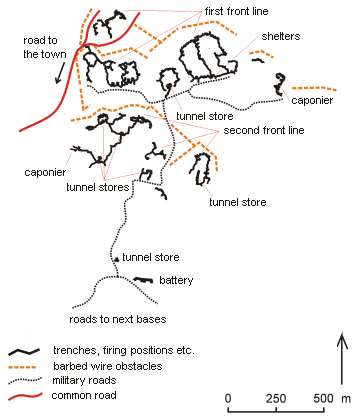
A typical decentralized fortress area on the land front of Krepost Sveaborg. Redoubt number IV in the Kivikko and Kontula areas.
Defensive positions were generally located on hillsides. In front of the firing line were barbed wire obstacles. They surrounded the whole fortification line (and the whole city) in a nearly unbroken belt. There were two or more obstacles consecutively in some places. Machine gun positions were built on the slopes behind the obstacles. They usually fired along the obstacle in front of the next defense position. There were also smaller positions for sharp shooters and for firing observation posts. In the front line there were trenches with firing platforms and small ammunition recesses. There were also small ‘artillery-fire-proof’ concrete shelters. In the rear were larger shelters and dugouts for accommodation. They were connected to the front line with trenches.
During the war, more attention was paid to building stronger firing positions and shelters. The last blockhouses which were built towards the end of the war were strong shelters with a concrete roof that was several meters thick. In the rear of the defensive positions were tunnel stores that had been excavated deep into the solid rock. Their storage area varied considerably in size – from 20 up to 200 square meters. The artillery formed the basis of the mainland front. In 1917 there were about 55 batteries on the mainland front (it is impossible to identify the exact amount) with some 200 guns. With reserves and the field artillery the total was about 440 guns in all.
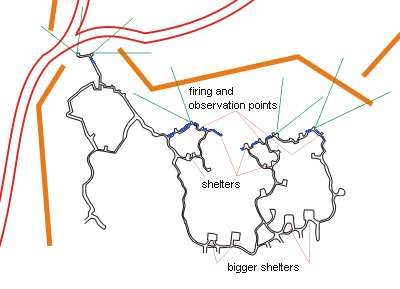
The defending position number IV:7 and a road to Helsinki. Machine gun firing sectors - green lines. Barbed wire obstacles - orange. Trenches with firing platforms - blue.
Land Fortifications in 1914
The most common type of defensive position during the temporary field defense era was a stone wall which was covered using sand or soil. The bank was approximately 1.5 - 2 meters high. In some places you can still find a short part of a firing platform. Most of the banks were built on the top of the high hills. The redoubt is a construction where a single bank or group of banks make up a closed ring on the top of the hill. Inside the bank are small traverses every ten meters. Traverses were used for splinter protection. Sometimes there are also small banks covering the rear of the shooting positions. Machine gun positions are simply small pits in the banks. Sometimes they were strengthened by using stones. Wooden construction work has disappeared. Shelters and dugouts are also almost totally decomposed. Some banks have remained in quite good condition, but some sand banks which were built on the tops of the cliffs have suffered extensively from erosion. The building of temporary field fortifications was finished at the end of 1914. At the same time work on new defense lines was started further from the city.
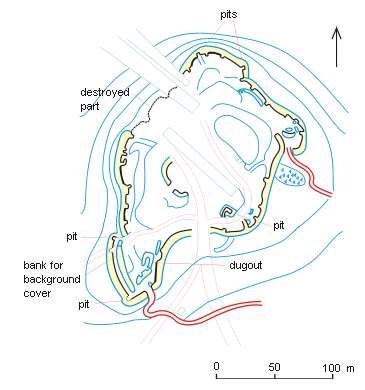
Redoubt in Herttoniemi (object 1914:62): A jumping hill and sawdust tracks have been built through the middle of the position, resulting in some of the banks being destroyed
The Construction of the Fortress of Helsinki
Construction Workers
The building site of the fortress was one of the biggest construction sites ever in Finland. The building of the fortifications was supervised by Russian engineering officers, but most of the workers were Finnish employees who were paid for working. There were not enough local workers, after war industry started and more employees were coerced into working on the site from the Finnish countryside. Besides that, over 3000 prisoners from the Far East (for example from China) were brought to Finland. They worked for only a short period of time and mostly as lumberjacks. Prisoners had very poor clothing for the cold weather conditions in Finland and soon most of them were sent away. Despite that these odd strangers left a great number of stories in Finland. Nowadays for example, many people think that the Chinese built every fortification in Helsinki.
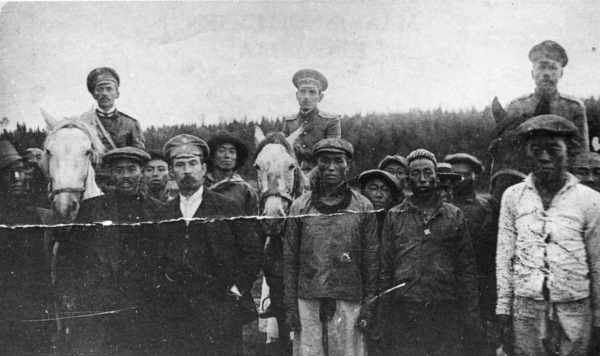
Exotic Oriental workers in the fortress area. Prisoners from the far east and their Russian guards. There are some pictures in the archives of Chinese prisoners but very few pictures of the approximately 100,000 Finnish fortification workers. (Photo: Espoo City Museum)
It is impossible to give the exact number of fortification workers in the Helsinki area. During the first world war there were in all 100,000 men involved in the fortification work in Finland. After the building of the fortifications ended in 1917 there was a big jump in unemployment which caused dissatisfaction and scarcity, and which partly influenced the breaking out of the civil war.
http://img197.imageshack.us/img197/2786/tynnyri.jpg
Cement has hardened in barrels. The Wooden Barrels have rotted away. You can still find old barrel-shape concrete blocks at unfinished fortress areas scattered around Helsinki. Photo: Kurkimäki,
Soldiers and Fighting in and around the Helsinki Fortress Area
The strength of the peace time garrison of Krepost Sveaborg was 7400 men. After the mobilization in the summer 1914, it would had to been about 12,500 men but garrison troops were soon sent to fight at the front and substitute troops came from elsewhere, for example from the fortresses of Kronstadt and Viipuri as well as from other parts of Russia. The garrison strength grew gradually and was at its maximum in August 1917 with more than 15,000 men in the Helsinki area. The first Russian revolution broke out in March 1917. Some officers were killed in violent incidemts in Helsinki and some officers were replaced when the army democratized. The discipline of the troops decreased. However fear of a German offensive in Finland increased and fortification work was continued. After the second revolution of November 1917 the demobilization of the Russian forces started in earnest. Finland declared independence on 6 December 1917 and soon after that the Finnish Civil War broke out (in January 1918).
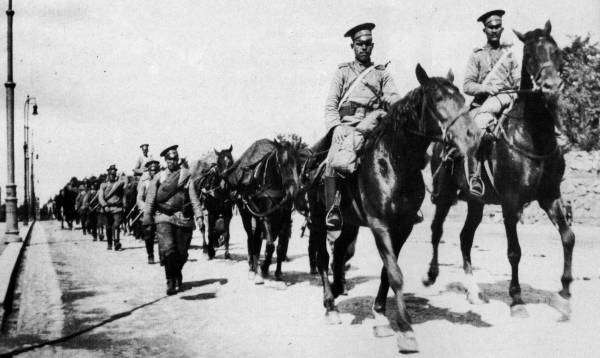
Russian troops in Helsinki 1914. (Photo: Ivan Timirjasev, Helsinki City Museum)
The Germans had landed on the Estonian coast in October 1917. The sea and land fortress of Tallinn surrendered 27 February 1918. Russia made a separate peace with the Central powers on 3 March 1918 and German troops landed at Hanko in April 1918. The Germans reached an agreement with the Russian forces which still were in Finland. The Russians agreed to remain neutral andto leave the country as soon as possible. Despite of that some Russian solders took part in the civil war fighting with the Red Guard. The Russians promised also to make all guns unusable and leave all forts undamaged to Germans.
The Red Guards
The workers militia, the Red Guard controlled Helsinki after 26 January 1918. The Russian Red Army had intended to transfer the whole fortress of Helsinki to the Finnish Red Guard but the transfer was left unfinished when the Germans attacked Helsinki. The Finnish Red Guard solders had poor equipment and even worse training.
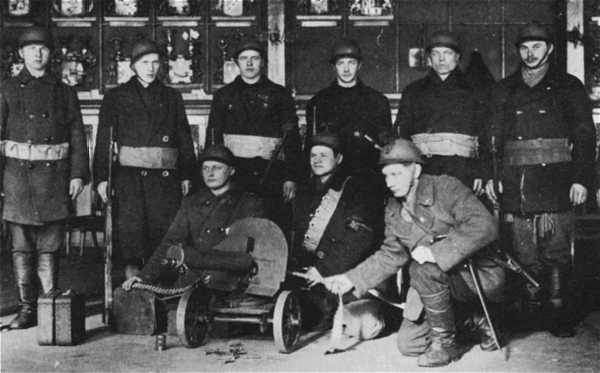
This Red Guard detachment has uncommonly good equipment. The steel helmets they are wearing were made especially for Russian fortress troops. The machine gun is the Maxim 7.62 mm, model 1910 - also used in Krepost Sveaborg. (1918)
When the German troops arrived in front of the western fortifications on 11 April 1918, every Red Guard front in Finland had collapsed and the Finnish White Army was advancing from the north. In Helsinki there were just 1,500 Red Guards in the trenches. If there was any artillery in working order, the Red Guard had no soldiers trained to use it.
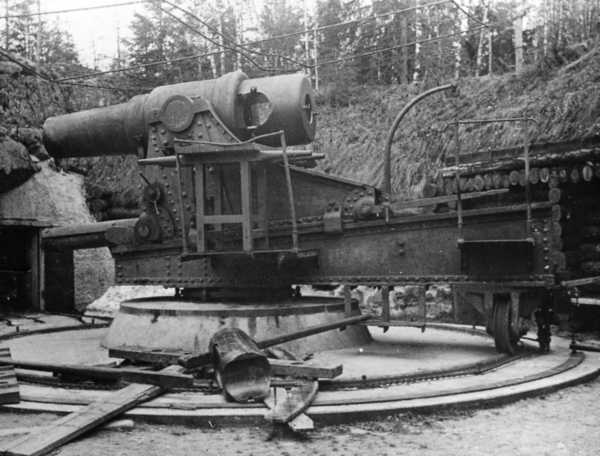
A 280 mm (11") coastal mortar without breechblock. Battery number 104 in Leppävaara, 1918. (Photo: Espoo City Museum)
The Germans
The strength of the German Baltic division was around 9,000 men. The Division landed in Hanko on 3 April 1918. The Reds withdraw to the east as the Germans attacked Helsinki from three directions: from the west through the Leppävaara and Mäkkylä fortifications, from the north through the fortress area of Malmi and from the sea to take the Katajanokka naval base. Fighting broke out on the 11 April 1918 at redoubt number XXIX in Leppävaara but did not last long. The Red Guard soon withdrew to the next defense line and after that to the old field fortification line, which had been constructed in 1914 in the Ilmala area. The German assault stopped at this line for approximately one day. On the afternoon of 12 April the Reds withdraw again and the fighting front moved into the streets of Helsinki city. Helsinki was surrendered on 13 April 1918. The German troops lost 24 men and the Finnish White Army lost 17 men in the occupation of the town. 300 Reds were killed and 6,200 men and women were taken prisoner.

German troops taking the last defense line in the Ilmala district. On the top of the hill is redoubt number 1914:27 and the meteorological station. (1918)
Krepost Sveaborg after WWI
After the Finnish Civil War of 1918, the landward fortifications of the fortress lost their importance. Armaments were transferred to the Finnish Army. Some was sold as scrap. The sea front batteries with their weapons and equipment were transferred to the newly formed Finnish Coastal Artillery. The fortified islands kept their strategic importance (something which has continued almost to the present, with some of the Artillery Batteries in used even the late 1970s).
The landward fortification generally disappeared into forest. Local inhabitants took away most of the wooden material for their own building sites or for firewood. Most of the concrete shelters and fire positions were destroyed when the steel balks were blown out for scrap metal. Shelter entries were also blocked up because tramps lived in these. Wooden-reinforced shelters collapsed over the years as the wooden material decayed. Tunnel stores were used during WW2 as ammunition magazines and factories. Some of the tunnel stores are still in use.

An old tunnel store still in use (1998)
Many parts of the fortress were destroyed as new suburban areas and roads were built. Despite this everywhere in Helsinki district can be found the remains of trenches, shelters and firing positions. However, there are now only a few still-complete redoubts where it is easy to see how the artillery batteries, shelters and tunnels, defense positions and obstacles were located in relation to each other, and their existence is endangered. The sea front fortifications are in a better condition. Most of the ortifications are located in military areas where there is no entry. Some of the ortifications have almost the same outward appearance as 80 years ago except for the guns, which were removed during WW2.

An entrance to the tunnel store in Itä-Pakila (1999)
Nowadays the old fortresses are protected by law. Their historical importance has been realized and some of the fortifications have had the litter and vegetation cleared. However, the land fortifications are located in three different cities: Helsinki, Espoo and Vantaa, and each city has its own restoration programs and publications, which doesn’t make it easy to get an idea of the old fortress in its entirity.
The renovation program being carried out by the city of Helsinki emphasizes ecological values in the clearing and renovation work. There is no purpose in renovating objects totally to their original condition. Also different periods (like the scrap metal blow-ups) belong in the fortresses history. Some objects of course could be renovated totally but the idea is to clear the fortification out just enough that people can understand the structure.

Local inhabitants clear fortifications regularly in Länsimäki, (1999)
A botanical view is also important. The vegetation in the fortress area is often unique. Army, and especially horse feed, has brought rare plants to the area. The blasting work has also released some nutrients from the solid rock and there is original vegetation along the trenches. The renovation work is done in co-operation with the Natural Science Museum and the Botanic museum.
Photographs of the Landward Fortifications
The Trenches
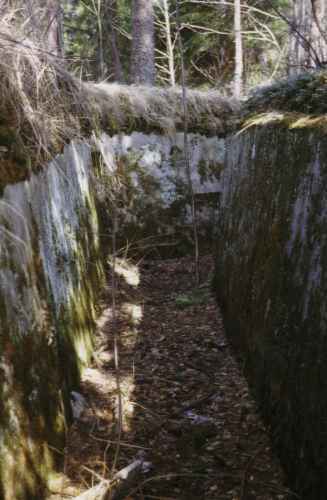
A communications trench between rear area shelters and the frontline. Länsimäki. (1983)
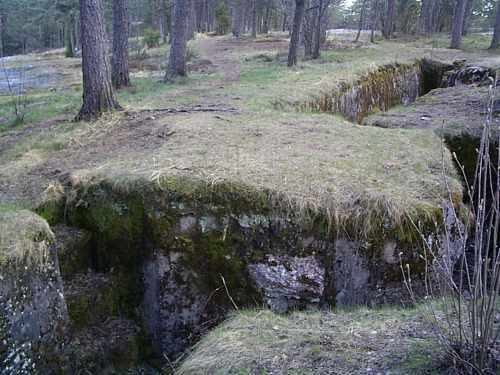
Stairs made it easier to climb from the trenches. Länsimäki. (1999)
Firing Positions and Observation Posts
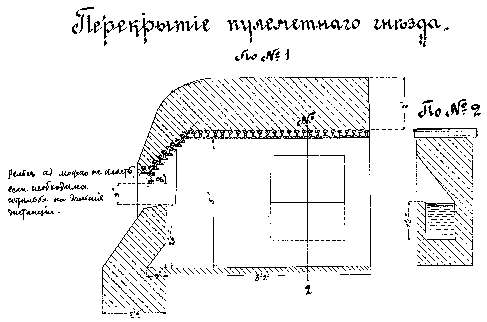
A cross-section of a machine gun position. At Right: a cross-section of an ammunition niche. Note hollow for machine gun stand under the embrasure. (Detail from Russian construction drawing, National Board of Antiquities, archives of the Department of Monuments and Sites)

A machine gun position without the roof dug into a steep hillside. Pihlajamäki. (1982)
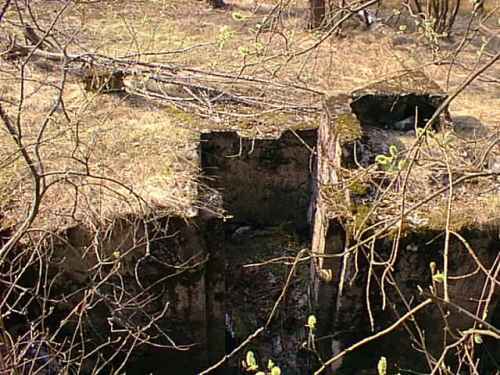
A small observation post - perhaps also intended for use as a rifle firing position. The roof was destroyed when the steel balks were blown out for scrap metal after the war. Maununneva. (1998)
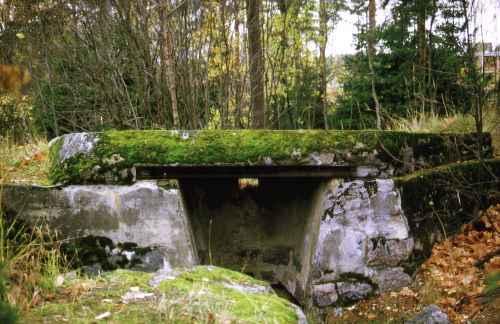
A small covered observation or firing post. Mäkkylä. (1984)
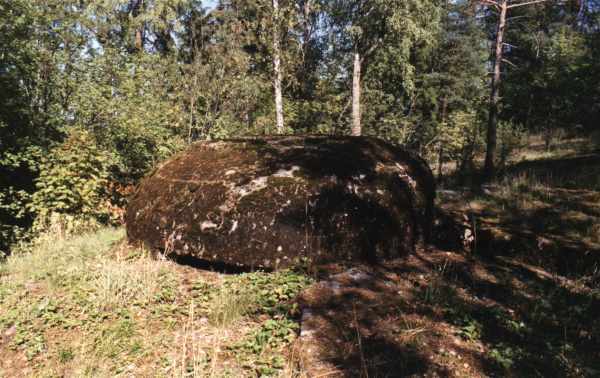
A cupola-shape rifle position with three embrasures. Ruukinranta. (1999)
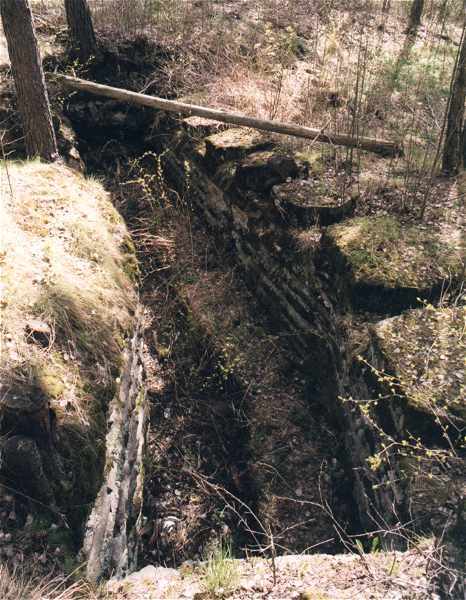
Firing position for eight riflemen. The roof is collapsed or unfinished. Mäkkylä. (2000)
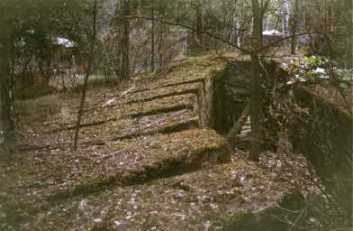
Espoon Ruukinrannan Myllykalliolla (Espoo's Mill Beach cliff): an open trench with built in fire-protection gaps and embrasures for riflemen.. Ironworks shore up the trench structure.
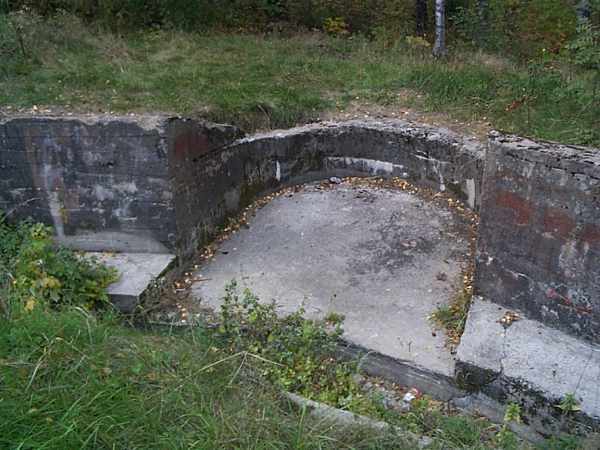
An open U-shaped position for a search light. Paloheinä. (1999
Barbed Wire Obstacles

Diagran of a barbed wire obstacle in a low moat protected by a bank.
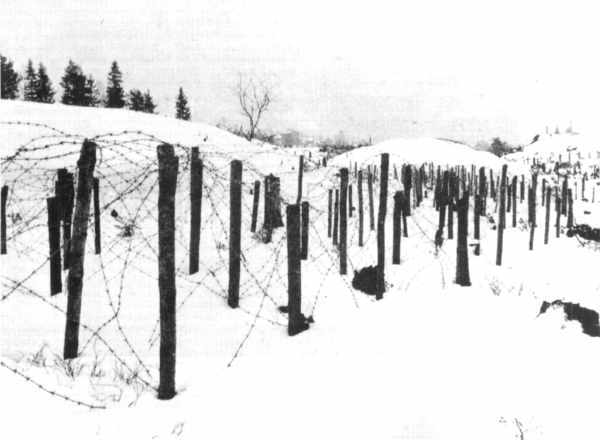
A barbed wire obstacle during WWI. Leppävaara. (Photo: Ivan Timirjasev, Helsinki City Museum)
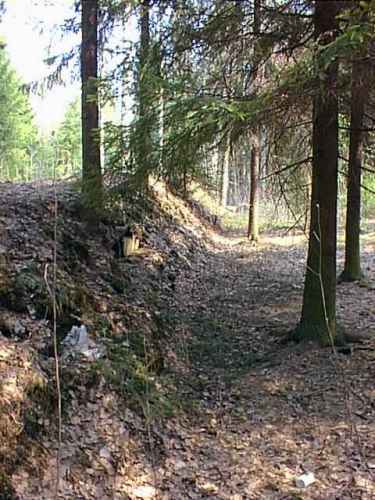
A bank for the barbed wire obstacle. Pohjois-Haaga. (1998)
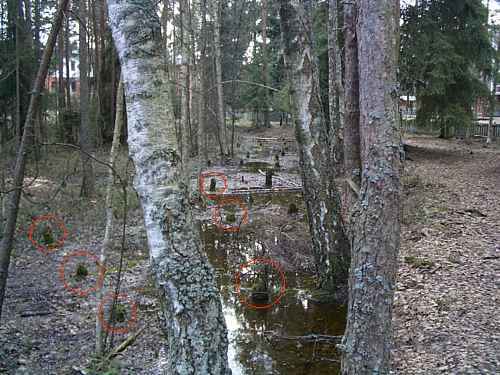
Foots of the poles in an old barbed wire obstacle. Some poles are circled to make it easy to find them in the picture. Länsimäki. (1999)
Shelters / Bunkers

A Bunker in Maununneva. (1999)
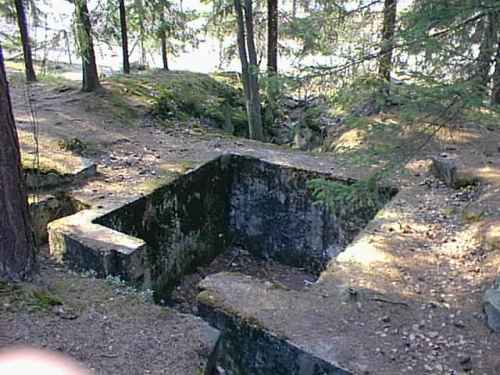
A small unfinished Bunker in the frontline. Maununneva. (1998)
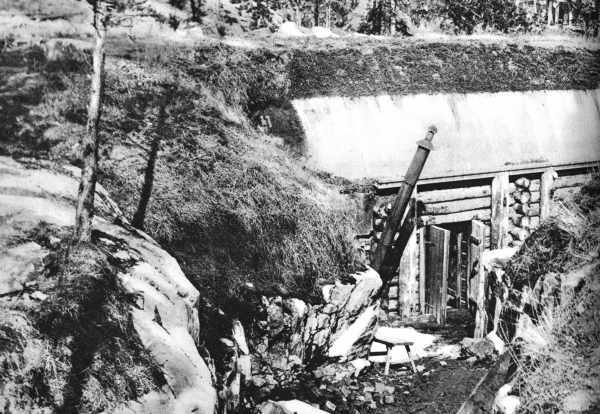
A Bunker with wooden walls and concrete roof. Leppävaara 1918. (Picture from the book: Suomen Vapaussota Kuvissa - II osa, Otava 1934).

A Bunker with a concrete roof. Wooden walls have vanished. Leppävaara. (1983)
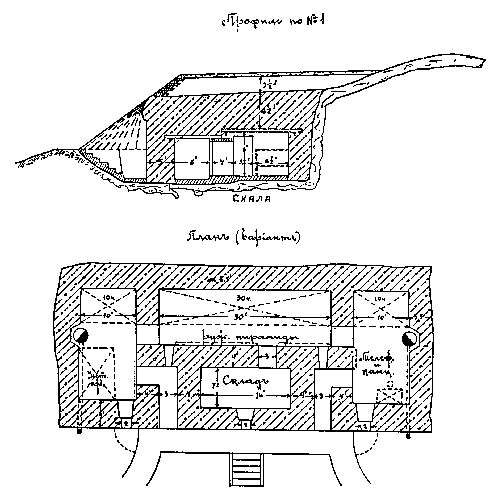
A shelter for 50 men. Left: bunks for 10 men and for the non-commissioned officer. Middle: bunks for 30 men and rack for rifles. Right: bunks for 10 men, the office and the telephone. Between entrances is a store. (Detail from Russian construction drawing from year 1916, National Board of Antiquities, archives of the Department of Monuments and Sites)
Tunnel-Type Shelters / Bunkers
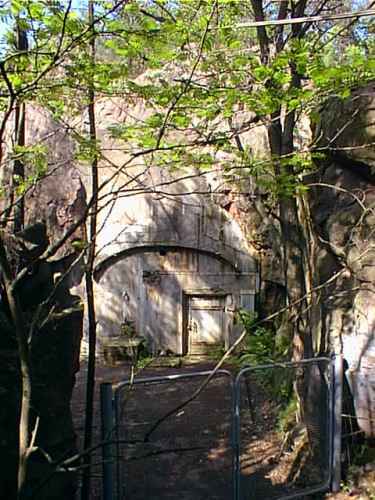
Tunnel-type shelters were blown in the solid rock. They were located in the rear of redoubts. Koskela. (1999)

The roof is usually several meters thick. Viikin Latokartano. (1999)
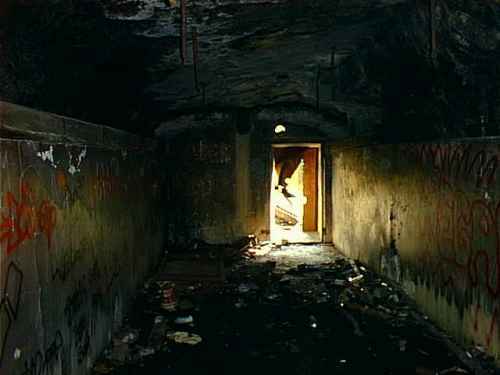
The Inside of a tunnel-type Bunker – generally concrete walls and floor. The corrugated steel plate inner roof has been removed. Pirkkola. (1998)
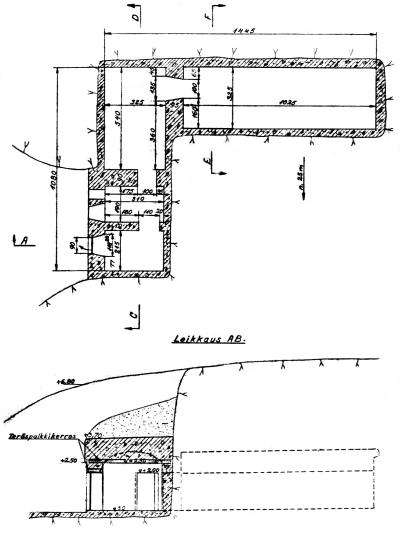
All land front tunnel-type stores and bunkers were listed before the second world war for use by war industiesy. Some of them were used during the second world war as ammunition magazines and factories. Detail from drawing made in 1937. Mäkkylä. (Military archive)
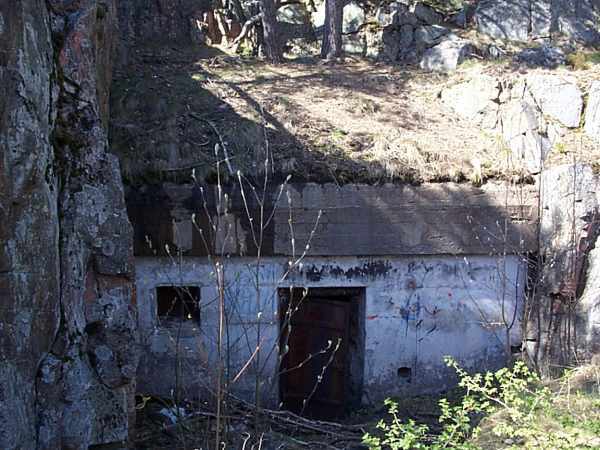
The same tunnel-shelter as in the drawning above. Mäkkylä. (2000)
Artillery Batteries
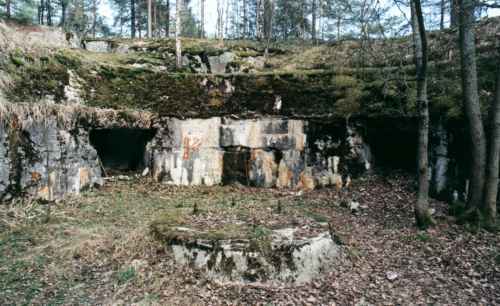
A battery position for four mortars in Myllypuro. In the picture – an emplacement for a 280 mm (11") mortar. Front: a base for the gun; behind: two recesses for ammunition. (1999)

280 mm (11") mortar in it's emplacement in Leppävaara, battery 104, spring 1918. Note the net for camouflage over the emplacement. (Picture taken from the book: Suomen Vapaussota Kuvissa - II osa, Otava 1934)

152 mm (6") Canet cannon on the land front of Helsinki, 1918. Bunkers were between the gun emplacements and under the embankment. (Photo: Military museum)
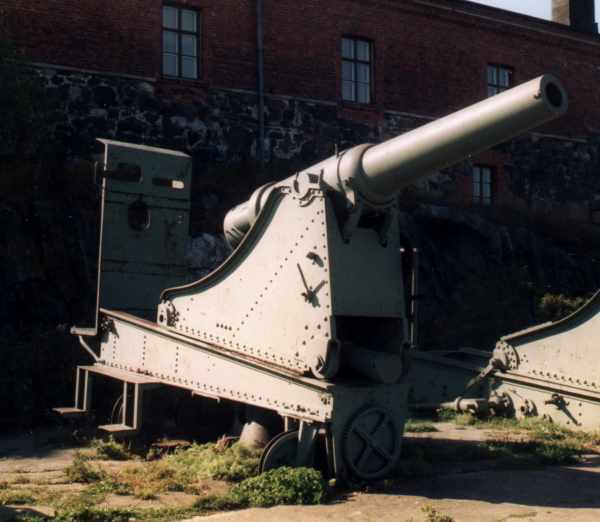
The 152 mm 190 puds coastal cannon was the most common artillery piece in the fortress of Helsinki. During the first world war most of these cannon were moved from the sea front to the land front. Picture from the Sveaborg Museum Fortress on the island of Kustaanmiekka. (1997)
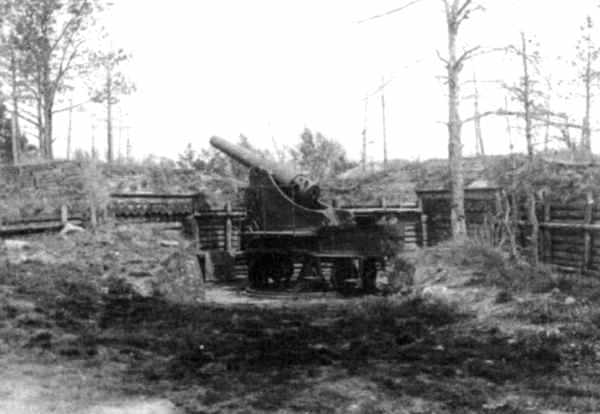
152 mm (6") 190 puds cannon on the land front in spring 1918 (Photo: Military Museum)
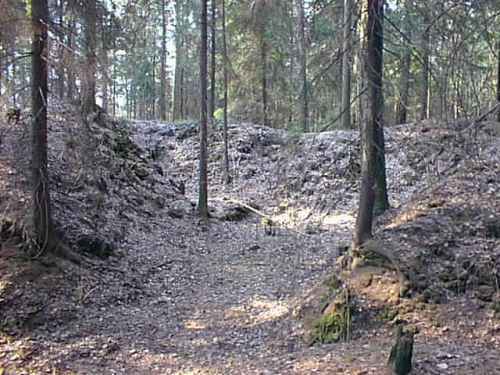
Emplacement for a similar type of cannon as above. Wooden construction has disappeared. Maununneva. (1998)
Communications and Accommodation
The First World War led to the build of two major roads into Helsinki. The Turku road from the west came through the lines of Hall and Mäkkylä. From the east came the current Jakomäki road which ran through the Malmi cemetery site and bridged the Vantaa River Estuary. All the points where the roads passed through the defense lines, of course, were strongly fortified starting from 1914, with movable barbed wire barriers to block the roads where they actually passed through the defence lines.
Helsinki was built over a wide area and to ease troop movements and supply, the old roads were repaired and improved and completely new roads were also built. Road surfaces were covered with stones or with crushed stone and were built to resist the spring thaw. In some places large rock cuts and embankments were cut, but the routes normally followed the terrain. In addition to roads, bridges were built for example over the Vantaa.
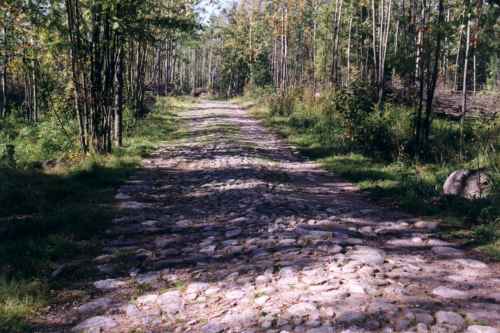
During the war a large military road network was built to support the land front. Roads were strong and constructed for use in winter and spring conditions. The Surface was stone or macadam (tar seal). In the picture: Renovated military road in the Kivikko area. (1998)
The roads remained after the war, gradually increasing in use and many were later covered in asphalt. Although the roads were built 90 years ago, they have survived surprisingly well until today. Heavy vehicle traffic, however, has damaged some. Some destroyed roads have now been restored and there are some now in original condition.
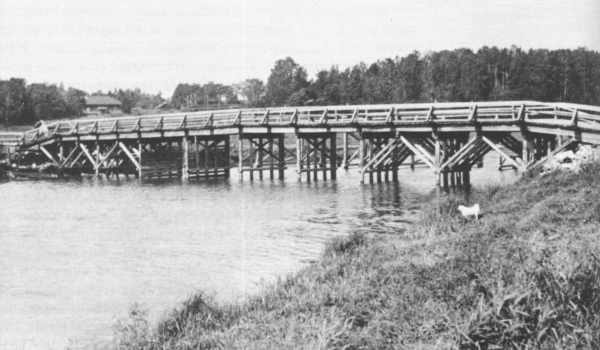
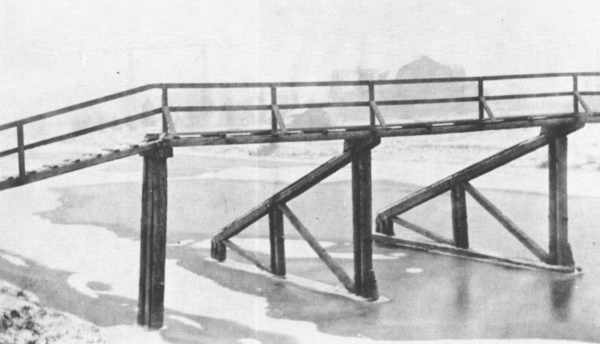
The Russian army built a bridge over the Vantaa river, Oulunkylä. front of 15 m towards the upper reaches were narrower than the stock bridge, which protected the actual bridge in the spring of ice damage. (Photo: Svensk Förening i Åggelby)
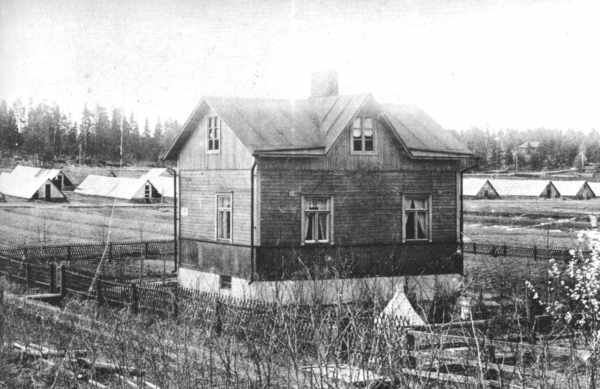
A Russian military camp behind the house 1916. (Photo: Svensk Förening i Åggelby)
The construction of the Helsinki land and sea fortress made Helsinki and the surrounding municipalities a huge building site as well as a military camp. Fortification work placed a large burden on local residents, as the fortress workers and Russian soldiers were accommodated in the farms of the ares as well as in other residential buildings. In addition, the military authorities constructed temporary houses and cheap buildings such as barns for the builders use. Barracks, horse stables and other service buildings were built on the fortress grounds and forest sites. Plans made near the end of the war were for a series of 200-hut camps with a kitchen and dining room for 500 men, food storage, seven horse stables, a barn for baggage and a 20-seater latrine, but the Revolution put a halt to this work. Tents were used for temporary summer accommodation as well as simple part-underground barracks. The latter were used year-round. The Russian Army built in such a way that a 0.5 - 1 meter deep pit was dug to the size of the building and covered with a pitched roof made of thatch and peat. The roof top included gaos for light. The entrance was at the end. The structure was winterized by including a fireplace. The temporary character of the buildings reflected in the fact that they had already partially collapsed by 1918.
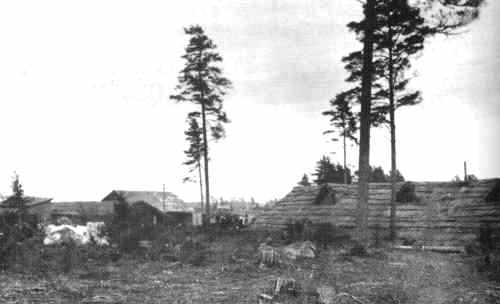
View one of three: exterior of Russian temporary barracks
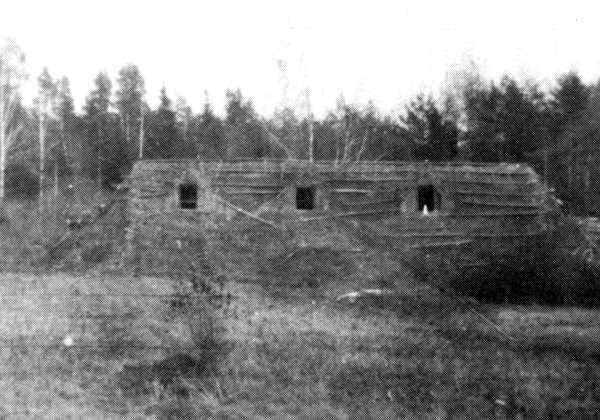
View two of three: exterior of Russian temporary barracks
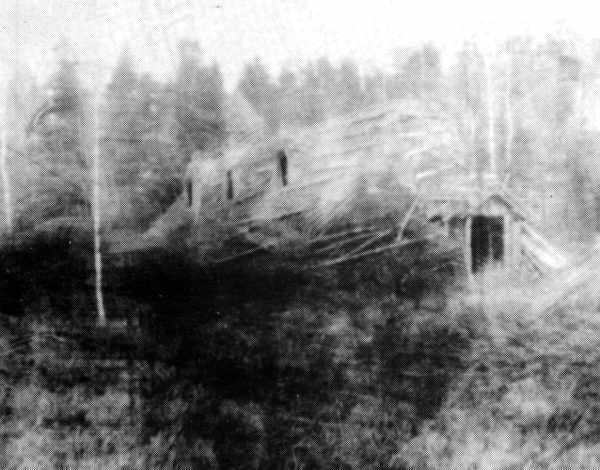
View three of three: exterior of Russian temporary barracks
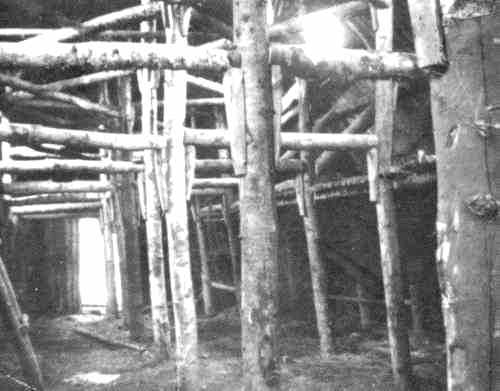
Internal supports – note the roof light openings (Image: Espoo City Museum).
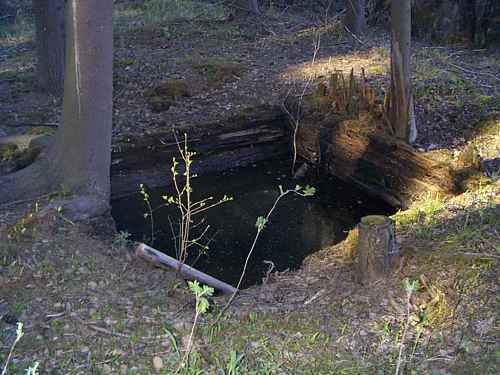
Old wells are found near accommodation areas. Most of these wells are propped up with wooden balks. Vuosaari. (1999)
Field Railway Lines
Two train tracks ran into Helsinki, the Pasila railway hub was fortified in 1914 and guard sports were placed at stations. During the war, the Russians carried out extensive forestry work. Timber for the narrow-gauge railways tracks was brought in on field lines. One of the field railway lines went in the Malmi Mosa and then Seutulan direction. Another narrow-gauge railway ran through the station Munkkiniemi Pitäjänmäen Konala and Häme Village. Another one went further afield from the Espoo railway station to the north. After the war the lines were torn up, but old railway line routes and embankments still stand out on the terrain.
Telephone Connections
The Russian army used its own telephone network in the city alongside the civilian network. The main telephone exchange was located near the Pasila station. The network had five exchanges: Elfvik (Tapiola), Tali, Lepola, Viikki Latokartano and Herttoniemi. Tallow and Lepola exchanges have been located in large-sized protective rooms. The Pasila main exchange was connected to the city exchange, and the civilian network. There was also a telegraph station and a radio station was located at Santahamina which aintained contact with the Baltic Fleet ships.
And next, photos and brief descriptions of the Sea Fortresses of Krepost Sveaborg…..
Before starting on the coastal defences of the Gulf of Finland, this Post (and the next after this) will provide a brief historical background to the Fortress of Krepost Sveaborg (Helsinki). The reasoning behind this is to give a good picture of the thoroughness with which these coastal defence positions were constructed - Finland inherited these defences from the Russians, and without the huge WWI construction effort financed by the old Tsarist Russian Empire, there's no way Finland could ever have afforded to build anything of this magnitude from scratch. It was an enormous effort both financially and in manpower that continued right through WW1, and after independance, Finland was the beneficiary.
And Credit where Credit is due…..
Before I start on thus next Post, I’d also like to credit and acknowledge the following websites from which I pulled, compiled and worked up all the information included so far on Finnish Coastal Artillery. Everything included here on the fortifications and weapons is accurate historical information – the maps, photos and information. A lot of people put a lot of time and effort into gathering all this information and posting it on the Web – all I’ve done is gather it together and edit it a bit so that it makes sense to me (and hopefully to you). That was the easy work compared to what the guys that gathered the information and took the photos originally did. Kudos to them. And I hope to visit a few of these sites myself one day……..
http://www.novision.fi/viapori/eavaus.htm - brilliant site on Krepost Sveaborg
http://forteca.w.activ.pl/finlandia_e.html - good summary on Finnish coastal defences
http://www.rt-kilta.net/english.html
http://www.nortfort.ru/coastal/foto_kvs1_e.html - haven't used this one so far but I will be going forward - great photos and commentary
Later on in these posts on the Coastal Defences, where I tweak things a little, I’ll clearly state what I’ve tweaked so as to allow for a clear differentiation between the real history and my ATL. Personally, I find the real historical information on all these Coastal Artillery sites fascinating. Anyhow, that said, on to the Credits and Links…..
The Landward Fortifications of Krepost Sveaborg in Pictures
Redoubts
At the beginning of WWI, fortification systems were generally still based on forts (or redoubts). Accommodation, batteries and defensive trenches with machine gun positions were all in the same large structure. When the building of the fortress of Tallinn began in 1913, there was going to be ten major forts with smaller redoubts located between them. When work on the permanent fortifications started in Helsinki in 1915 the master plan had been modernized. The land front fortification system was decentralized: different defensive positions were placed apart, machine gun positions and small shelters on the frontline and batteries and larger shelters and storage areas at the rear. This dispersed targets for the enemy's artillery and reduced the potential damage. In the old-fashioned fortress system, a couple of hits could inflict fatal damage.

A typical decentralized fortress area on the land front of Krepost Sveaborg. Redoubt number IV in the Kivikko and Kontula areas.
Defensive positions were generally located on hillsides. In front of the firing line were barbed wire obstacles. They surrounded the whole fortification line (and the whole city) in a nearly unbroken belt. There were two or more obstacles consecutively in some places. Machine gun positions were built on the slopes behind the obstacles. They usually fired along the obstacle in front of the next defense position. There were also smaller positions for sharp shooters and for firing observation posts. In the front line there were trenches with firing platforms and small ammunition recesses. There were also small ‘artillery-fire-proof’ concrete shelters. In the rear were larger shelters and dugouts for accommodation. They were connected to the front line with trenches.
During the war, more attention was paid to building stronger firing positions and shelters. The last blockhouses which were built towards the end of the war were strong shelters with a concrete roof that was several meters thick. In the rear of the defensive positions were tunnel stores that had been excavated deep into the solid rock. Their storage area varied considerably in size – from 20 up to 200 square meters. The artillery formed the basis of the mainland front. In 1917 there were about 55 batteries on the mainland front (it is impossible to identify the exact amount) with some 200 guns. With reserves and the field artillery the total was about 440 guns in all.

The defending position number IV:7 and a road to Helsinki. Machine gun firing sectors - green lines. Barbed wire obstacles - orange. Trenches with firing platforms - blue.
Land Fortifications in 1914
The most common type of defensive position during the temporary field defense era was a stone wall which was covered using sand or soil. The bank was approximately 1.5 - 2 meters high. In some places you can still find a short part of a firing platform. Most of the banks were built on the top of the high hills. The redoubt is a construction where a single bank or group of banks make up a closed ring on the top of the hill. Inside the bank are small traverses every ten meters. Traverses were used for splinter protection. Sometimes there are also small banks covering the rear of the shooting positions. Machine gun positions are simply small pits in the banks. Sometimes they were strengthened by using stones. Wooden construction work has disappeared. Shelters and dugouts are also almost totally decomposed. Some banks have remained in quite good condition, but some sand banks which were built on the tops of the cliffs have suffered extensively from erosion. The building of temporary field fortifications was finished at the end of 1914. At the same time work on new defense lines was started further from the city.

Redoubt in Herttoniemi (object 1914:62): A jumping hill and sawdust tracks have been built through the middle of the position, resulting in some of the banks being destroyed
The Construction of the Fortress of Helsinki
Construction Workers
The building site of the fortress was one of the biggest construction sites ever in Finland. The building of the fortifications was supervised by Russian engineering officers, but most of the workers were Finnish employees who were paid for working. There were not enough local workers, after war industry started and more employees were coerced into working on the site from the Finnish countryside. Besides that, over 3000 prisoners from the Far East (for example from China) were brought to Finland. They worked for only a short period of time and mostly as lumberjacks. Prisoners had very poor clothing for the cold weather conditions in Finland and soon most of them were sent away. Despite that these odd strangers left a great number of stories in Finland. Nowadays for example, many people think that the Chinese built every fortification in Helsinki.

Exotic Oriental workers in the fortress area. Prisoners from the far east and their Russian guards. There are some pictures in the archives of Chinese prisoners but very few pictures of the approximately 100,000 Finnish fortification workers. (Photo: Espoo City Museum)
It is impossible to give the exact number of fortification workers in the Helsinki area. During the first world war there were in all 100,000 men involved in the fortification work in Finland. After the building of the fortifications ended in 1917 there was a big jump in unemployment which caused dissatisfaction and scarcity, and which partly influenced the breaking out of the civil war.
http://img197.imageshack.us/img197/2786/tynnyri.jpg
Cement has hardened in barrels. The Wooden Barrels have rotted away. You can still find old barrel-shape concrete blocks at unfinished fortress areas scattered around Helsinki. Photo: Kurkimäki,
Soldiers and Fighting in and around the Helsinki Fortress Area
The strength of the peace time garrison of Krepost Sveaborg was 7400 men. After the mobilization in the summer 1914, it would had to been about 12,500 men but garrison troops were soon sent to fight at the front and substitute troops came from elsewhere, for example from the fortresses of Kronstadt and Viipuri as well as from other parts of Russia. The garrison strength grew gradually and was at its maximum in August 1917 with more than 15,000 men in the Helsinki area. The first Russian revolution broke out in March 1917. Some officers were killed in violent incidemts in Helsinki and some officers were replaced when the army democratized. The discipline of the troops decreased. However fear of a German offensive in Finland increased and fortification work was continued. After the second revolution of November 1917 the demobilization of the Russian forces started in earnest. Finland declared independence on 6 December 1917 and soon after that the Finnish Civil War broke out (in January 1918).

Russian troops in Helsinki 1914. (Photo: Ivan Timirjasev, Helsinki City Museum)
The Germans had landed on the Estonian coast in October 1917. The sea and land fortress of Tallinn surrendered 27 February 1918. Russia made a separate peace with the Central powers on 3 March 1918 and German troops landed at Hanko in April 1918. The Germans reached an agreement with the Russian forces which still were in Finland. The Russians agreed to remain neutral andto leave the country as soon as possible. Despite of that some Russian solders took part in the civil war fighting with the Red Guard. The Russians promised also to make all guns unusable and leave all forts undamaged to Germans.
The Red Guards
The workers militia, the Red Guard controlled Helsinki after 26 January 1918. The Russian Red Army had intended to transfer the whole fortress of Helsinki to the Finnish Red Guard but the transfer was left unfinished when the Germans attacked Helsinki. The Finnish Red Guard solders had poor equipment and even worse training.

This Red Guard detachment has uncommonly good equipment. The steel helmets they are wearing were made especially for Russian fortress troops. The machine gun is the Maxim 7.62 mm, model 1910 - also used in Krepost Sveaborg. (1918)
When the German troops arrived in front of the western fortifications on 11 April 1918, every Red Guard front in Finland had collapsed and the Finnish White Army was advancing from the north. In Helsinki there were just 1,500 Red Guards in the trenches. If there was any artillery in working order, the Red Guard had no soldiers trained to use it.

A 280 mm (11") coastal mortar without breechblock. Battery number 104 in Leppävaara, 1918. (Photo: Espoo City Museum)
The Germans
The strength of the German Baltic division was around 9,000 men. The Division landed in Hanko on 3 April 1918. The Reds withdraw to the east as the Germans attacked Helsinki from three directions: from the west through the Leppävaara and Mäkkylä fortifications, from the north through the fortress area of Malmi and from the sea to take the Katajanokka naval base. Fighting broke out on the 11 April 1918 at redoubt number XXIX in Leppävaara but did not last long. The Red Guard soon withdrew to the next defense line and after that to the old field fortification line, which had been constructed in 1914 in the Ilmala area. The German assault stopped at this line for approximately one day. On the afternoon of 12 April the Reds withdraw again and the fighting front moved into the streets of Helsinki city. Helsinki was surrendered on 13 April 1918. The German troops lost 24 men and the Finnish White Army lost 17 men in the occupation of the town. 300 Reds were killed and 6,200 men and women were taken prisoner.

German troops taking the last defense line in the Ilmala district. On the top of the hill is redoubt number 1914:27 and the meteorological station. (1918)
Krepost Sveaborg after WWI
After the Finnish Civil War of 1918, the landward fortifications of the fortress lost their importance. Armaments were transferred to the Finnish Army. Some was sold as scrap. The sea front batteries with their weapons and equipment were transferred to the newly formed Finnish Coastal Artillery. The fortified islands kept their strategic importance (something which has continued almost to the present, with some of the Artillery Batteries in used even the late 1970s).
The landward fortification generally disappeared into forest. Local inhabitants took away most of the wooden material for their own building sites or for firewood. Most of the concrete shelters and fire positions were destroyed when the steel balks were blown out for scrap metal. Shelter entries were also blocked up because tramps lived in these. Wooden-reinforced shelters collapsed over the years as the wooden material decayed. Tunnel stores were used during WW2 as ammunition magazines and factories. Some of the tunnel stores are still in use.

An old tunnel store still in use (1998)
Many parts of the fortress were destroyed as new suburban areas and roads were built. Despite this everywhere in Helsinki district can be found the remains of trenches, shelters and firing positions. However, there are now only a few still-complete redoubts where it is easy to see how the artillery batteries, shelters and tunnels, defense positions and obstacles were located in relation to each other, and their existence is endangered. The sea front fortifications are in a better condition. Most of the ortifications are located in military areas where there is no entry. Some of the ortifications have almost the same outward appearance as 80 years ago except for the guns, which were removed during WW2.

An entrance to the tunnel store in Itä-Pakila (1999)
Nowadays the old fortresses are protected by law. Their historical importance has been realized and some of the fortifications have had the litter and vegetation cleared. However, the land fortifications are located in three different cities: Helsinki, Espoo and Vantaa, and each city has its own restoration programs and publications, which doesn’t make it easy to get an idea of the old fortress in its entirity.
The renovation program being carried out by the city of Helsinki emphasizes ecological values in the clearing and renovation work. There is no purpose in renovating objects totally to their original condition. Also different periods (like the scrap metal blow-ups) belong in the fortresses history. Some objects of course could be renovated totally but the idea is to clear the fortification out just enough that people can understand the structure.

Local inhabitants clear fortifications regularly in Länsimäki, (1999)
A botanical view is also important. The vegetation in the fortress area is often unique. Army, and especially horse feed, has brought rare plants to the area. The blasting work has also released some nutrients from the solid rock and there is original vegetation along the trenches. The renovation work is done in co-operation with the Natural Science Museum and the Botanic museum.
Photographs of the Landward Fortifications
The Trenches

A communications trench between rear area shelters and the frontline. Länsimäki. (1983)

Stairs made it easier to climb from the trenches. Länsimäki. (1999)
Firing Positions and Observation Posts

A cross-section of a machine gun position. At Right: a cross-section of an ammunition niche. Note hollow for machine gun stand under the embrasure. (Detail from Russian construction drawing, National Board of Antiquities, archives of the Department of Monuments and Sites)

A machine gun position without the roof dug into a steep hillside. Pihlajamäki. (1982)

A small observation post - perhaps also intended for use as a rifle firing position. The roof was destroyed when the steel balks were blown out for scrap metal after the war. Maununneva. (1998)

A small covered observation or firing post. Mäkkylä. (1984)

A cupola-shape rifle position with three embrasures. Ruukinranta. (1999)

Firing position for eight riflemen. The roof is collapsed or unfinished. Mäkkylä. (2000)

Espoon Ruukinrannan Myllykalliolla (Espoo's Mill Beach cliff): an open trench with built in fire-protection gaps and embrasures for riflemen.. Ironworks shore up the trench structure.

An open U-shaped position for a search light. Paloheinä. (1999
Barbed Wire Obstacles

Diagran of a barbed wire obstacle in a low moat protected by a bank.

A barbed wire obstacle during WWI. Leppävaara. (Photo: Ivan Timirjasev, Helsinki City Museum)

A bank for the barbed wire obstacle. Pohjois-Haaga. (1998)

Foots of the poles in an old barbed wire obstacle. Some poles are circled to make it easy to find them in the picture. Länsimäki. (1999)
Shelters / Bunkers

A Bunker in Maununneva. (1999)

A small unfinished Bunker in the frontline. Maununneva. (1998)

A Bunker with wooden walls and concrete roof. Leppävaara 1918. (Picture from the book: Suomen Vapaussota Kuvissa - II osa, Otava 1934).

A Bunker with a concrete roof. Wooden walls have vanished. Leppävaara. (1983)

A shelter for 50 men. Left: bunks for 10 men and for the non-commissioned officer. Middle: bunks for 30 men and rack for rifles. Right: bunks for 10 men, the office and the telephone. Between entrances is a store. (Detail from Russian construction drawing from year 1916, National Board of Antiquities, archives of the Department of Monuments and Sites)
Tunnel-Type Shelters / Bunkers

Tunnel-type shelters were blown in the solid rock. They were located in the rear of redoubts. Koskela. (1999)

The roof is usually several meters thick. Viikin Latokartano. (1999)

The Inside of a tunnel-type Bunker – generally concrete walls and floor. The corrugated steel plate inner roof has been removed. Pirkkola. (1998)

All land front tunnel-type stores and bunkers were listed before the second world war for use by war industiesy. Some of them were used during the second world war as ammunition magazines and factories. Detail from drawing made in 1937. Mäkkylä. (Military archive)

The same tunnel-shelter as in the drawning above. Mäkkylä. (2000)
Artillery Batteries

A battery position for four mortars in Myllypuro. In the picture – an emplacement for a 280 mm (11") mortar. Front: a base for the gun; behind: two recesses for ammunition. (1999)

280 mm (11") mortar in it's emplacement in Leppävaara, battery 104, spring 1918. Note the net for camouflage over the emplacement. (Picture taken from the book: Suomen Vapaussota Kuvissa - II osa, Otava 1934)

152 mm (6") Canet cannon on the land front of Helsinki, 1918. Bunkers were between the gun emplacements and under the embankment. (Photo: Military museum)

The 152 mm 190 puds coastal cannon was the most common artillery piece in the fortress of Helsinki. During the first world war most of these cannon were moved from the sea front to the land front. Picture from the Sveaborg Museum Fortress on the island of Kustaanmiekka. (1997)

152 mm (6") 190 puds cannon on the land front in spring 1918 (Photo: Military Museum)

Emplacement for a similar type of cannon as above. Wooden construction has disappeared. Maununneva. (1998)
Communications and Accommodation
The First World War led to the build of two major roads into Helsinki. The Turku road from the west came through the lines of Hall and Mäkkylä. From the east came the current Jakomäki road which ran through the Malmi cemetery site and bridged the Vantaa River Estuary. All the points where the roads passed through the defense lines, of course, were strongly fortified starting from 1914, with movable barbed wire barriers to block the roads where they actually passed through the defence lines.
Helsinki was built over a wide area and to ease troop movements and supply, the old roads were repaired and improved and completely new roads were also built. Road surfaces were covered with stones or with crushed stone and were built to resist the spring thaw. In some places large rock cuts and embankments were cut, but the routes normally followed the terrain. In addition to roads, bridges were built for example over the Vantaa.

During the war a large military road network was built to support the land front. Roads were strong and constructed for use in winter and spring conditions. The Surface was stone or macadam (tar seal). In the picture: Renovated military road in the Kivikko area. (1998)
The roads remained after the war, gradually increasing in use and many were later covered in asphalt. Although the roads were built 90 years ago, they have survived surprisingly well until today. Heavy vehicle traffic, however, has damaged some. Some destroyed roads have now been restored and there are some now in original condition.


The Russian army built a bridge over the Vantaa river, Oulunkylä. front of 15 m towards the upper reaches were narrower than the stock bridge, which protected the actual bridge in the spring of ice damage. (Photo: Svensk Förening i Åggelby)

A Russian military camp behind the house 1916. (Photo: Svensk Förening i Åggelby)
The construction of the Helsinki land and sea fortress made Helsinki and the surrounding municipalities a huge building site as well as a military camp. Fortification work placed a large burden on local residents, as the fortress workers and Russian soldiers were accommodated in the farms of the ares as well as in other residential buildings. In addition, the military authorities constructed temporary houses and cheap buildings such as barns for the builders use. Barracks, horse stables and other service buildings were built on the fortress grounds and forest sites. Plans made near the end of the war were for a series of 200-hut camps with a kitchen and dining room for 500 men, food storage, seven horse stables, a barn for baggage and a 20-seater latrine, but the Revolution put a halt to this work. Tents were used for temporary summer accommodation as well as simple part-underground barracks. The latter were used year-round. The Russian Army built in such a way that a 0.5 - 1 meter deep pit was dug to the size of the building and covered with a pitched roof made of thatch and peat. The roof top included gaos for light. The entrance was at the end. The structure was winterized by including a fireplace. The temporary character of the buildings reflected in the fact that they had already partially collapsed by 1918.

View one of three: exterior of Russian temporary barracks

View two of three: exterior of Russian temporary barracks

View three of three: exterior of Russian temporary barracks

Internal supports – note the roof light openings (Image: Espoo City Museum).

Old wells are found near accommodation areas. Most of these wells are propped up with wooden balks. Vuosaari. (1999)
Field Railway Lines
Two train tracks ran into Helsinki, the Pasila railway hub was fortified in 1914 and guard sports were placed at stations. During the war, the Russians carried out extensive forestry work. Timber for the narrow-gauge railways tracks was brought in on field lines. One of the field railway lines went in the Malmi Mosa and then Seutulan direction. Another narrow-gauge railway ran through the station Munkkiniemi Pitäjänmäen Konala and Häme Village. Another one went further afield from the Espoo railway station to the north. After the war the lines were torn up, but old railway line routes and embankments still stand out on the terrain.
Telephone Connections
The Russian army used its own telephone network in the city alongside the civilian network. The main telephone exchange was located near the Pasila station. The network had five exchanges: Elfvik (Tapiola), Tali, Lepola, Viikki Latokartano and Herttoniemi. Tallow and Lepola exchanges have been located in large-sized protective rooms. The Pasila main exchange was connected to the city exchange, and the civilian network. There was also a telegraph station and a radio station was located at Santahamina which aintained contact with the Baltic Fleet ships.
And next, photos and brief descriptions of the Sea Fortresses of Krepost Sveaborg…..
ex Ngāti Tumatauenga ("Tribe of the Maori War God") aka the New Zealand Army
Another diversion - Finnish Civil Aviation
The Growth of Finnish Civil Aviation and the Finnish Aviation Industry through the 1920’s and 1930’s
This is probably as good a point as any to step sideways for a moment and take a look at the growth of Finnish Civil Aviation and the development of the Finnish Aviation Industry through the 1920’s and 1930’s – particularly as there are ramifications for the defence of Finland in some of the decisions that were made from 1931 on. From 1924 on, Finnish Civil Aviation had been developing, with two airlines (Aero Oy – the predecessor to todays Finnair) and Veljekset Karhumäki (run by the Karhumäki Brothers and operating in parallel and in competition with Aero Oy). In addition, a small number of private individuals bought and flew aircraft with some running flying schools and Flying and Gliding clubs were founded in a small number of cities. The 1920’s also saw the foundation of the Suomen Ilmapuolustusliitto or SIPL (Air Defence League), initially a kind of Air Civil Guard. We’ll cover each of these organizations in turn, starting with Aero Oy, then Veljekset Karhumäki followed by the Suomen Ilmapuolustusliitto and finally, defence initiatives of the last half of the 1930’s and how they affected each of these organisations.
Aero Oy
Aero Oy, the first real Finnish civil airline, was founded in November 1923 by Consul Bruno Lucander and a small circle of financiers, including Gustav Snellman and Fritiof Ahman. Lieutenant-Colonel Arne Somersalo served initially as the company's technical adviser. The company's capital was 500,000 Finnish marks, which was increased on 12 December by a further one million marks. Lucander had become involved in aviation in 1918 as the general manager of Finland Spedition, a managerial group that ran the Finnish operations of the Estonian airline Aeronaut. At that time, the Finnish aviation industry was dominated by German interests, including the aircraft manufacturer Junkers, a company experienced with aircraft designs that were capable of enduring the extreme physical demands of northern European weather. The Junkers F.13 had been flown by Aeronaut, and its ability to operate under the demanding conditions of northern Europe had made a deep impression on Lucander. He therefore in mid-1923 concluded an agreement with Junkers Flugzeugwerke AG to provide one F.13 aircraft and technical support in exchange for a 50% ownership in the new airline. The charter establishing the company was signed in Helsinki on September 12, 1923, and the company was entered into the trade register on December 11, 1923. Aero took delivery of its first aircraft, a German-registered Junkers F 13 D-335, on 14 March 1924. Three days later, a Junkers factory pilot, Heinrich Putz, flew the aircraft to Helsinki.
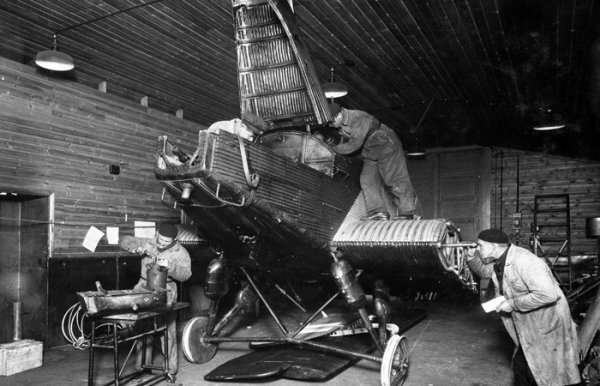
Junker F.13 Maintenance in the early days of Aero Oy
In the summer of 1924, Aero recruited its first Finnish pilot, Gunnar Lihr, bringing the total number of employees to seven. As the company employed only a few staff, it was not uncommon to see the CEO selling tickets or carrying passengers bags to the aircraft. While it might have been natural to operate domestic flights first, as it turned out the first regular air-route was the Helsinki-Tallinn route – this was already been flown by the Estonian Airline, Aeronaut and this had given impetus to the establishment of Aero Oy.
The late 1920s were characterised by events not directly related to scheduled operations. In 1927 the company's managing director and a group of journalists embarked on Aero's first round-Finland flight. Lasting more than a month, the flight tour went as far north as Rovaniemi on the Arctic Circle. Aero's board of management had previously discussed the company's domestic traffic plans, and the aim of the tour was to stimulate interest among decision-makers. Aero was already hopeful at this stage of transferring flights to airstrips on land. The towns and cities were however reluctant to build such airstrips. But there was progress on the seaplane side, when the opening of the Turku-Ruissalo air harbour in May 1927 enabled flight traffic to start between Turku and Stockholm.
In June 1928, an Aero Junkers F 13 piloted by Gunnar Lihr took part in the search for the explorer Umberto Nobile's airship, Italia, which had crashed on Spitzbergen. Lihr succeeded in rescuing one of the expedition team, a feat which brought considerable publicity in the world's press for both Lihr and Aero. Two years later, Aero received more international press coverage when an Aero Oy Junkers F 13 located the Norwegian vessel, Bratvaag, which was carrying the remains of the crew of the ill-fated 1897 Andree Expedition from Spitzbergen.
During its first summer, Aero built a seaplane ramp and small terminal building at Katajanokka, Helsinki from which they operated. The company's aircraft were fitted with water floats in the summer and skis in the winter. The first flight was flown on March 20, 1924 from Helsinki to Tallinn, Estonia, with Junkers F.13 aircraft equipped with floats (the F.13 was a single-engined six-seater – two crew and four passengers) – the pilot was Gunnar Lihr and the flight carried 162 kilos of mail. In the same year the Company purchased a second F.13 and from June 2 1924 began to operate the Helsinki-Stockholm route during the summer months in competition with the newly founded Swedish company A.B. Aerotransport. With rail connections from Tallin and Stockholm, travelers were afforded quick passage to Copenhagen, Konigsberg, and Berlin. While the route system remained small, Aero launched a campaign to promote air travel. In 1925 alone, in addition to regular routes Aero Oy operated 833 sight-seeing tours.

Air Map – Helsinki - Tallinn
Financially, as with all small airlines in the infancy of civil aviation in the 1920’s, Aero Oy struggled with some 534 passengers carried in the first year of operations (1924). Aside from income, the principal obstacle to the development of Finnish civil air traffic was the absence of land-aerodromes. This meant an interruption of traffic in spring and autumn when ice drifts prevent the landing of seaplanes and when, on the other hand, the ice was not thick enough to allow ski-equipped aeroplanes to land. The additional weight of the floats on the early seaplanes also reduced the paying weight that could be carried – meaning sometimes that demands for seats could not be met. However, Aero Oy succeeded in establishing and maintaining a remarkable high percentage of payload and both passenger and mail traffic steadily increased. While 534 passengrs had been carried in 1924, in 1934 the corresponding number was 6,550, in 1935 7,098 and in 1936 8,702. Financially, Aero O/Y first received a subsidy from the Government in 1926 and from that year on continued to receive an annual subsidy. Due to the comparative poverty of Finland through the 1920’s, this was smaller than that given to any other air traffic company in Europe. From 1932 on, Aero Oy began to receive larger subsidies, both direct and indirect.
In 1925, Junkers amalgamated its Nord Europa Union and Trans Europa Union air transport subsidiaries into a single company consisting of 16 airlines in nine countries. This new company, Europa Union, was then combined with another German airline interest, Aero Lloyd, to form Deutsche Lufthansa. Aero Oy remained outside this consortium, but received less support from Junkers, which gave priority to the new German air consortium. Aero turned to the Finnish government for financial assistance to acquire new aircraft and with a state-guaranteed loan, in June 1926 the airline took delivery of its first Junkers G 24, a three-engine, nine-passenger seaplane (2 crew + 9 passengers), which was piloted by ex-Ilmavoimat pilot Wäinö Bremer. The G-24 was a three-engined, all-metal, low-wing monoplane design – the single G-24 purchased by Aero Oy was equipped with floats, but not skis, and so could be used in summer only. It remained in service until 1935.

Aero Oy Junkers G24, photo taken at Stockhol (Lindarangen, early 1930’s) – original photo from Finnair
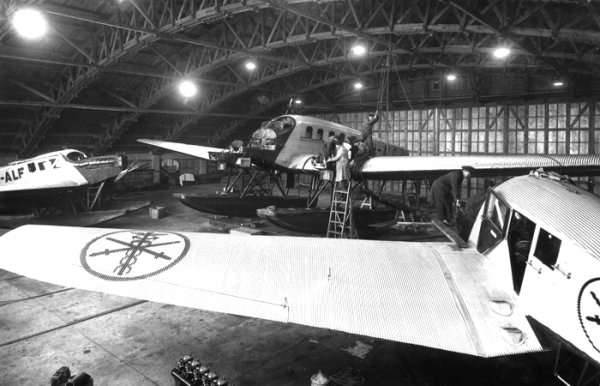
November 1st, 1932: A major overhaul of the Aero Oy Junkers G-24 in progress in a workshop adjacent to Aero Oy’s Kellosaari Hangar. Helsinki got its land airport in 1936 when Malmi Airport was opened and at the same time Aero Oy built a modern hangar for maintenance activities
Aero was reluctant to switch to land-based aircraft. In a country with more than 60,000 lakes, the trouble and expense of building runways remained prohibitive as long as Aero continued to operate floatplanes. Additionally, Aero could establish new destinations virtually anywhere there was a lake. While airports were still in the planning stage, Aero Oy was further expanding and as a gradual transition from floatplanes to the planned airports was envisaged, this was taken into account when new aircraft were purchased.
With the August 1929 death of Lucander, the company lost its managing director, who during his brief term of office had made his mark in airline history. Aero appointed Gunnar Stänhle, who was trained as an engineer, as general manager. Lucander's death also had indirect consequences, because now the Junkers company was Aero's biggest shareholder. Finnish investors completed a buyout of the German company's interest and Aero ended its financial relationship with Junkers, becoming an entirely Finnish owned company. In 1930 Aero began to establish a closer relationship with other Scandinavian airlines. The company ran night airmail services in cooperation with Swedish, Danish, and later, Dutch airline companies. Junkers, however, remained the company's major aircraft supplier in the early 1930’s, providing five 14-passenger Ju 52s (the first had been acquired in June 1932 when Aero Oy acquired the first of what would be a small fleet of three-engined Junker Ju 52 airliners, designed for use as either a floatplane or with wheels and capable of carrying 15 passengers plus a crew of 3 (Pilot, Flight Mechanic and Radio Operator). The first Ju 52 fully met expectations and another 4 joined the Aero Oy fleet within a short timeframe).
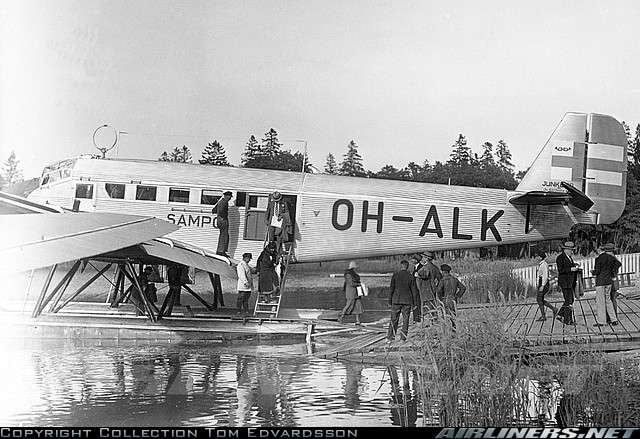
Aero Oy Junkers Ju-52 floatplan “Sampo”. Photo taken at Stockholm, Lindarangen, in the early 1930’s
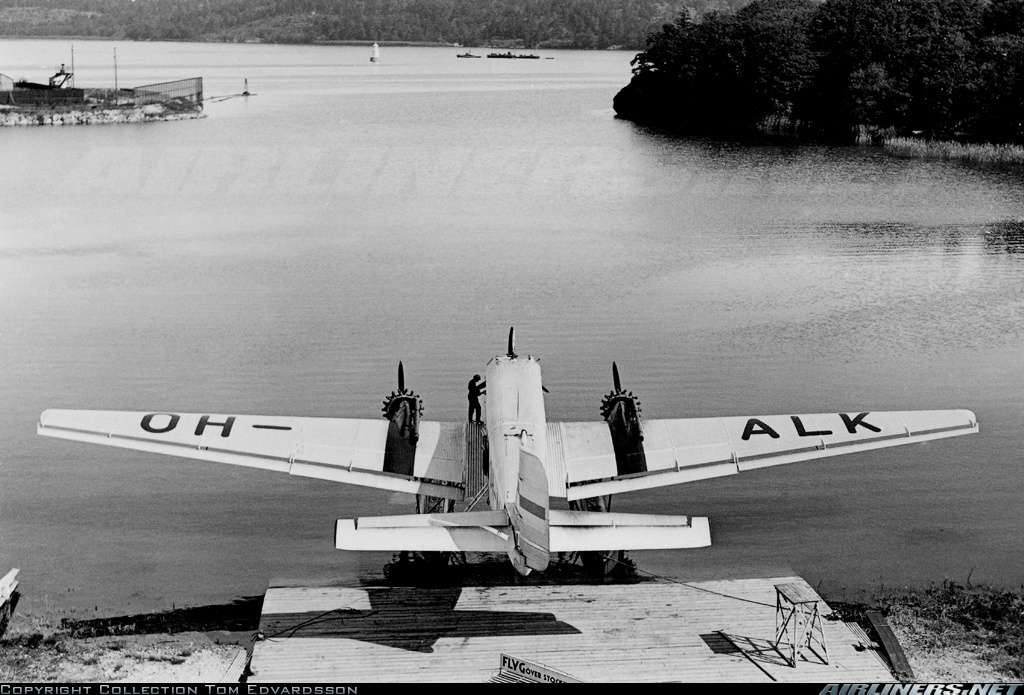
Aero Oy Junkers Ju-52 floatplan “Sampo”. Photo taken at Stockholm, Lindarangen, in the early 1930’s

Aero Oy Junkers Ju-52 Floatplane “Kaleva”: Photo taken at Katajannokka, Helsinki, 1936
Airport construction within Finland proceeded through the mid-1930s, with the government making the necessary funds available as the country’s finances improved. There was a growing awareness of the necessity for having a good airport infrastructure, with all the airfields being dual-use civilian and military. Turku field was completed in September 1935 and the Stockholm field in 1936 and pressure grew to establish a landing strip at Helsinki. The location for the Helsinki Airport was decided on as Tattarisuo and the field was opened to traffic in December 1936. With the establishment of these airfields, it was now possible to maintain an uninterrupted connection with other European countries and air traffic consequently grew further. Aero converted its aircraft to wheel landing gear and operated its last seaplane service on December 15, 1936
In 1937 Aero took delivery of its first non-Junkers aircraft, two twin-engine DH 89A Dragon Rapides. These planes were operated on domestic routes within Finland. From 1 May 1937, Aero began to operate routes between Helsinki-Tampere and and Helsinki-Viipuri using the English twin-engined Dragon Rapide aircraft with a 2 man crew and carrying 7 passengers (the Ju-52’s were reserved for international routes). The next summer, airports were rapidly built in Northern Finland and these domestic routes were extended as the “Arctic Air Express” service on the route Helsinki-Tampere-Vaasa-Oulo-Kemi-Petsamo, enabling travelers to fly from Helsinki to the Arctic Coast in one day. During the bathing season a special service was run between Stockholm and Mariehamn on the Åland Islands which proved a great success.
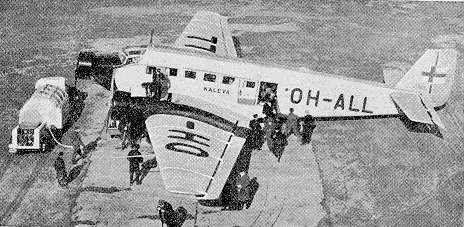
The Helsinki-Stockholm air-liner arrives at the Helsinki aerodrome
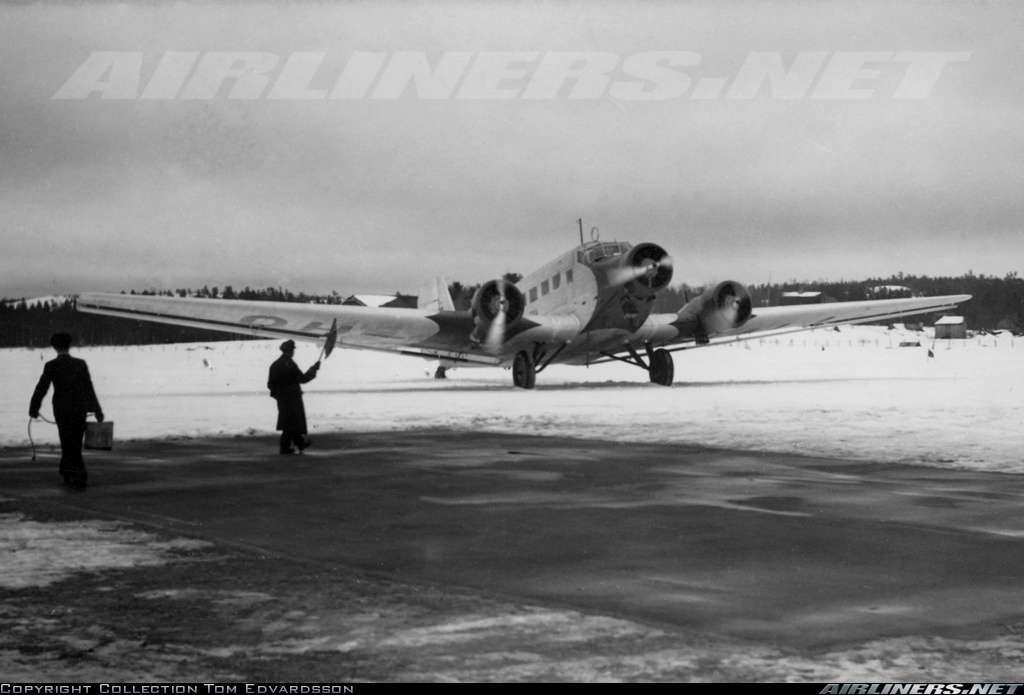
Aero Oy Junkers Ju-52, Malmi Airport, Helsinki, late 1930’s
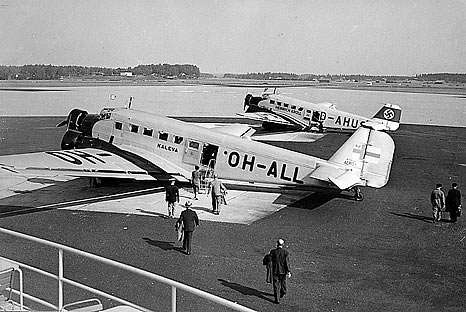
Aero Oy Junkers Ju-52 OH-All “Kaleva” and Lufthansa Junkers Ju-52 (D-AHUS “ Heinrich Kroll”) aircraft at Malmi Airport, Helsinki, late 1930’s
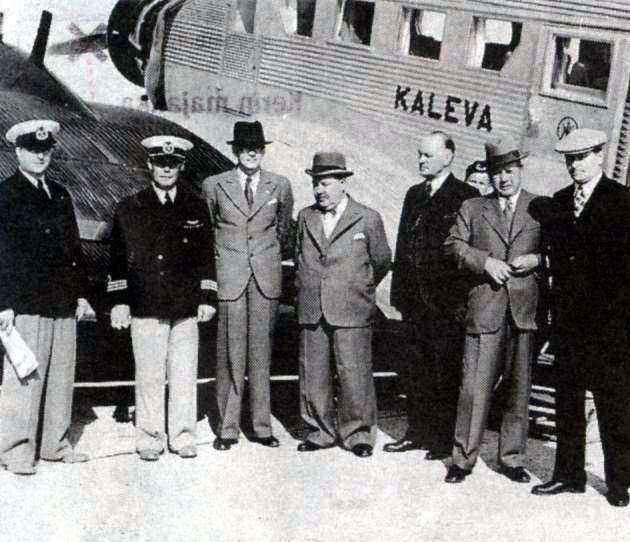
Crew and Passengers for “Kaleva” sometime in the late 1930’s
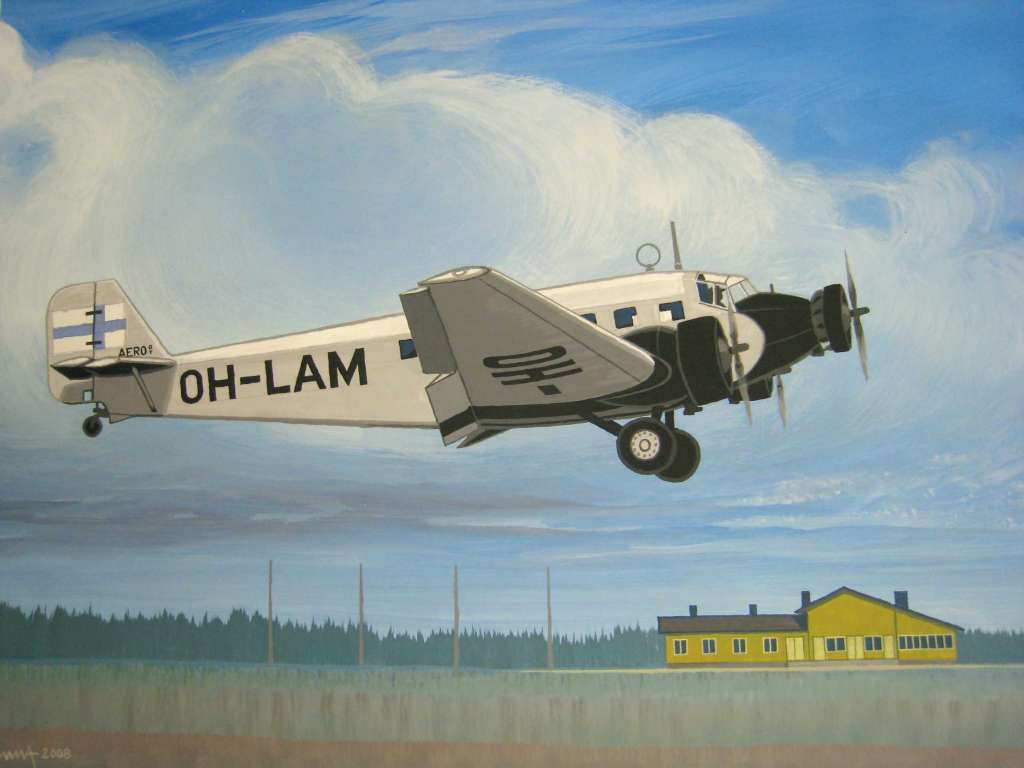
Aero Oy Junkers Ju-52
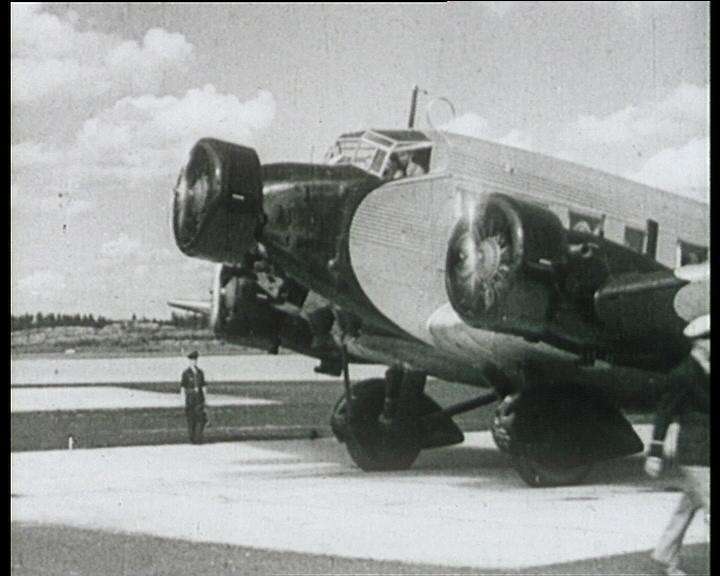
Aero Oy Junkers Ju-52
The late 1930s saw a number of changes to Aero's international network. In 1937 Aero Oy extended the Stockholm-Helsinki-Tallinn route to Berlin via Riga (Latvia) and Kaunas (Lithuania). Further services were opened to Warsaw and to Copenhagen in 1938. With increased international traffic, an additional five Junkers Ju-52’s were purchased in 1938 and in anticipation of the 1940 Helsinki Olympics, in early 1938 Aero ordered four German Focke-Wulf Fw 200B (Condor) aircraft, to be delivered in early 1939. The Focke-Wulf Condor was a four-engine low-wing aircraft, fitted with a retractable undercarriage. It had 26 seats and a cruising speed of 325 kph (220mph) with a range of 3,000 kms (1,860 miles). The Condor's long-range potential made it suitable for international flights - The Condor was the first heavier-than-air craft to fly nonstop between Berlin and New York City, making the journey on 10 August 1938 in 24 hours and 56 minutes. The return trip on 13 August 1938 took 19 hours and 47 minutes.
All four Condors were delivered on schedule in early 1939 and Aero Oy inaugarated two new routes - Helsinki-London-New York and Helsinki-Paris-Rome. With the purchase of the aircraft financed by a state guaranteed loan, these routes initially proved commercially viable.

The Danish Airlines' Focke-Wulf Fw 200 airliner OY-DAM Dania at the opening of the Norwegian airport Fornebu near Oslo, 1 June 1939. “Dania” was flown to Helsinki by its crew following the invasion of Denmark by the Germans and was taken into service by the Ilmavoimat.
Veljekset Karhumäki
The Karhumäki Brothers were sons of a farmer and “the other” pioneers of Finnish civilian aviation. They started flying in Keljo, Jyväskylä in 1924 when Niilo and Valto together with Eemil Kankaanpää and Toivo Huovinen started building the Karhu (“Bear”) 1 aircraft. In the 1920’s the brothers built four aircraft: The Karhus 1, 2, and 3, and Tiira (“Tern”).
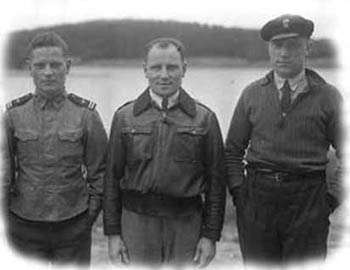
The Brothers Karhumäki
Karhumäki’s business included building, assembling and repairing aircraft in their own factory, training civilian pilots and operating sightseeing and passenger flights. In 1929 the brothers took up aerial photography, which would go on to become an important part of their business. In 1934 a photograph laboratory was built in the new factory building and a photograph technician was hired. In the summer of 1934 the brothers flew 100 hours of aerial photographing flights.
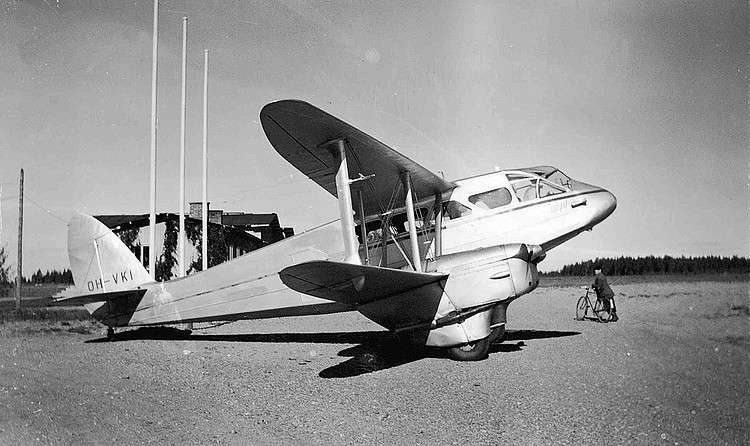
Veljekset Karhumäki de Havillad DH.89 Dragon Rapide Passenger Aircraft
From 1932 on, the Finnish Government made a conscious effort to build up civil aviation within Finland. In parallel with Aero Oy, the Karhumäki Brothers were issued a number of government contracts for regular mail delivery flights and some domestic passenger routes were subsidized. As with Aero Oy, the government provided state-guaranteed loans for the purchase of aircraft and Veljekset Karhumäki took advantage of these to purchase six DH.89 Dragon Rapide aircraft in 1936, which were then utilized to service Government mail contracts. Recognising the potential of aerial mapmaking, in 1935 the Suomen Maavoimat issued a five year contract to the Karhumäki Brothers for aerial photography of frontier areas and subsidized the purchase of advanced cameras for the company on the understanding that these would be used for aerial reconnsaisance in the event of any war. The DH.89’s were also uses for this work.
Veljekset Karhumäki were also responsible for the introduction into Finland of the Noorduyn Norseman. Designed and manufactured in Canada for use in similar conditions to those in Finland, the Norseman was a “Bush Plane” designed around a few basic criteria. It should be an aircraft with which an operator utilizing existing talents, equipment and facilities could make money, it should be a high-wing monoplane to facilitate loading and unloading of passengers and cargo at seaplane docks and airports and, finally, it should be an all-around superior aircraft to those currently in use. From the outset, Noorduyn (who had previously worked as an aircraft designer for Fokker) designed the transport to have interchangeable wheel, ski or twin-float landing gear.
Unlike most aircraft designs, the Norseman was first fitted with floats, then skis and, finally, fixed landing gear. The final design layout looked much like Noorduyn's earlier Fokker designs, it was a high-wing braced monoplane with an all-welded steel tubing fuselage structure and wood stringers applied to it for the attachment of a fabric skin. The Norseman's wing had an all wood construction and was fabric covered, except for the flaps and ailerons, which were made of welded steel tubing. It had a divided type landing gear fitted to fuselage stubs, the legs were secured with two bolts each to allow the alternate arrangement of floats or skis. The tail wheel strut could be fitted with a wheel or tail skid.
The first Norseman was sold in Canada in January 1936 and sales there were slow but steady as the aircraft proved itself a rugged and reliable workhorse. With a new government contract to provide services to remote communities, Veljekset Karhumäki were in the market for such an aircraft and after reading the specifications, in July 1937, they took delivery of the first Norsemen in Scandanavia. This was a Mk IV model, powered by a Pratt & Whitney Wasp S3H-1 with seating for up to 10, a range of 810 nautical miles, a maximum speed of 140 mph. Impressed with its performance, Veljekset Karhumäki bought another four of the aircraft in 1938. One was loaned to the Ilmavoimat for flight testing, and so impressed were the Ilmavoimat with the Norseman’s performance that in late 1938 they ordered twenty five. These were shipped and delivered in early 1939, entering service with the Ilmavoimat in mid-1939 (most of the Norseman survived WW2, with three being sold to the Swedish Air Force in 1949).

Ex-Ilmavoimat Noordyn Norseman – used throughout the Winter War and for the duration of WW2, three survivors were sold to the Swedish Airforce in 1949 – the last survivor is in the Flygvapenmuseum (The Official Museum of the Swedish Air Force).
Veljekset Karhumäki were the beneficiary of further Ilmavoimat purchases over the period 1937-39. While Aero Oy was buying Junkers Ju-52’s from Germany with state guaranteed loans, the Ilmavoimat was looking for alternative options to support the newly formed Para Jaeger unit – which was at first Battalion strength, then Regimental, then in early 1939 expanded to a full Division with three Regimental Battle Groups. Transport aircraft were needed to support these units, and the Ilmavoimat’s preference was for the Douglas DC3, which they regarded after an earlier purchase of a small number of DC-2’s and trials of the DC3 as superior to the Junkers Ju-52. In early 1937, the Suomen Ilmavoimat purchased 20 Douglas DC3 passenger aircraft and “leased” some of these to Veljekset Karhumäki and some to Aero Oy for use as passenger aircraft while also retaining a small number for use by the Ilmavoimat. The DC3’s were listed as part of the Ilmavoimat Reserve, with the civilian Karhumäki Airways crew listed as Ilmavoimat Reservists. The Suomen Ilmavoimat then chartered the DC3’s back from Karhumäki Airways when needed to use as Paratroop training aircraft.
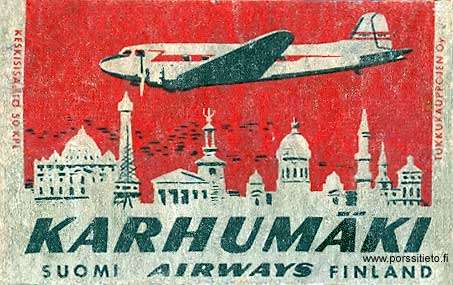
Veljekset Karhumäki DC3
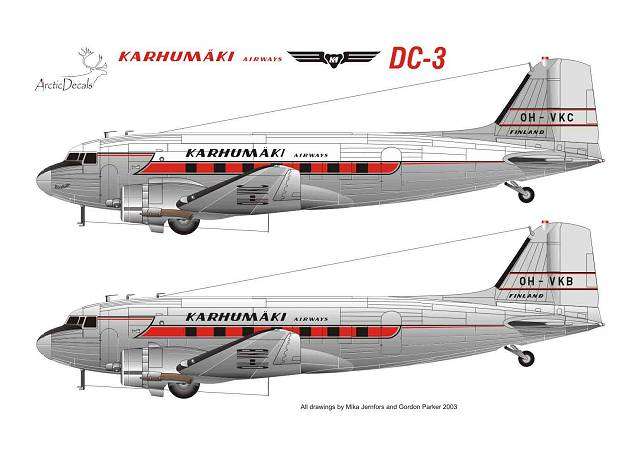
Veljekset Karhumäki DC3 Profile and Colour Scheme
Both the Junkers Ju52 and the Douglas DC-3 were evaluated and a decision was made to purchase the DC3 – with a major influencing factor being the substantial loan made available by the US Government in early 1937 which financed the purchase of the aircraft. Twenty Douglas DC3’s were ordered in the first quarter of 1937. They were built at the Douglas manufacturing plant at Santa Monica, California, Long Beach, California and shipped to Finland, arriving in Turku in late 1937, where they were freighted to the State Aircraft Factory for assembly and test flights, entering service with Aero Oy and Veljekset Karhumäki in the first quarter of 1938, forming a Squadron of the Air Force Reserve. The DC3’s were utlised as passenger aircraft. In war, they were to be mobilised by the Ilmavoimat and would be allocated to a Reserve Squadron whose personnel were all FinnAir aircrew and groundcrew.

Douglas DC-3 aircraft with 21 passenger seats were als0 added to Aero Oy’s fleet.
In late 1939 with war looming, the Ilmavoimat would go on to purchase further DC3’s using a part of the thirty million US Dollar loan made available by the US Government.
This is probably as good a point as any to step sideways for a moment and take a look at the growth of Finnish Civil Aviation and the development of the Finnish Aviation Industry through the 1920’s and 1930’s – particularly as there are ramifications for the defence of Finland in some of the decisions that were made from 1931 on. From 1924 on, Finnish Civil Aviation had been developing, with two airlines (Aero Oy – the predecessor to todays Finnair) and Veljekset Karhumäki (run by the Karhumäki Brothers and operating in parallel and in competition with Aero Oy). In addition, a small number of private individuals bought and flew aircraft with some running flying schools and Flying and Gliding clubs were founded in a small number of cities. The 1920’s also saw the foundation of the Suomen Ilmapuolustusliitto or SIPL (Air Defence League), initially a kind of Air Civil Guard. We’ll cover each of these organizations in turn, starting with Aero Oy, then Veljekset Karhumäki followed by the Suomen Ilmapuolustusliitto and finally, defence initiatives of the last half of the 1930’s and how they affected each of these organisations.
Aero Oy
Aero Oy, the first real Finnish civil airline, was founded in November 1923 by Consul Bruno Lucander and a small circle of financiers, including Gustav Snellman and Fritiof Ahman. Lieutenant-Colonel Arne Somersalo served initially as the company's technical adviser. The company's capital was 500,000 Finnish marks, which was increased on 12 December by a further one million marks. Lucander had become involved in aviation in 1918 as the general manager of Finland Spedition, a managerial group that ran the Finnish operations of the Estonian airline Aeronaut. At that time, the Finnish aviation industry was dominated by German interests, including the aircraft manufacturer Junkers, a company experienced with aircraft designs that were capable of enduring the extreme physical demands of northern European weather. The Junkers F.13 had been flown by Aeronaut, and its ability to operate under the demanding conditions of northern Europe had made a deep impression on Lucander. He therefore in mid-1923 concluded an agreement with Junkers Flugzeugwerke AG to provide one F.13 aircraft and technical support in exchange for a 50% ownership in the new airline. The charter establishing the company was signed in Helsinki on September 12, 1923, and the company was entered into the trade register on December 11, 1923. Aero took delivery of its first aircraft, a German-registered Junkers F 13 D-335, on 14 March 1924. Three days later, a Junkers factory pilot, Heinrich Putz, flew the aircraft to Helsinki.

Junker F.13 Maintenance in the early days of Aero Oy
In the summer of 1924, Aero recruited its first Finnish pilot, Gunnar Lihr, bringing the total number of employees to seven. As the company employed only a few staff, it was not uncommon to see the CEO selling tickets or carrying passengers bags to the aircraft. While it might have been natural to operate domestic flights first, as it turned out the first regular air-route was the Helsinki-Tallinn route – this was already been flown by the Estonian Airline, Aeronaut and this had given impetus to the establishment of Aero Oy.
The late 1920s were characterised by events not directly related to scheduled operations. In 1927 the company's managing director and a group of journalists embarked on Aero's first round-Finland flight. Lasting more than a month, the flight tour went as far north as Rovaniemi on the Arctic Circle. Aero's board of management had previously discussed the company's domestic traffic plans, and the aim of the tour was to stimulate interest among decision-makers. Aero was already hopeful at this stage of transferring flights to airstrips on land. The towns and cities were however reluctant to build such airstrips. But there was progress on the seaplane side, when the opening of the Turku-Ruissalo air harbour in May 1927 enabled flight traffic to start between Turku and Stockholm.
In June 1928, an Aero Junkers F 13 piloted by Gunnar Lihr took part in the search for the explorer Umberto Nobile's airship, Italia, which had crashed on Spitzbergen. Lihr succeeded in rescuing one of the expedition team, a feat which brought considerable publicity in the world's press for both Lihr and Aero. Two years later, Aero received more international press coverage when an Aero Oy Junkers F 13 located the Norwegian vessel, Bratvaag, which was carrying the remains of the crew of the ill-fated 1897 Andree Expedition from Spitzbergen.
During its first summer, Aero built a seaplane ramp and small terminal building at Katajanokka, Helsinki from which they operated. The company's aircraft were fitted with water floats in the summer and skis in the winter. The first flight was flown on March 20, 1924 from Helsinki to Tallinn, Estonia, with Junkers F.13 aircraft equipped with floats (the F.13 was a single-engined six-seater – two crew and four passengers) – the pilot was Gunnar Lihr and the flight carried 162 kilos of mail. In the same year the Company purchased a second F.13 and from June 2 1924 began to operate the Helsinki-Stockholm route during the summer months in competition with the newly founded Swedish company A.B. Aerotransport. With rail connections from Tallin and Stockholm, travelers were afforded quick passage to Copenhagen, Konigsberg, and Berlin. While the route system remained small, Aero launched a campaign to promote air travel. In 1925 alone, in addition to regular routes Aero Oy operated 833 sight-seeing tours.

Air Map – Helsinki - Tallinn
Financially, as with all small airlines in the infancy of civil aviation in the 1920’s, Aero Oy struggled with some 534 passengers carried in the first year of operations (1924). Aside from income, the principal obstacle to the development of Finnish civil air traffic was the absence of land-aerodromes. This meant an interruption of traffic in spring and autumn when ice drifts prevent the landing of seaplanes and when, on the other hand, the ice was not thick enough to allow ski-equipped aeroplanes to land. The additional weight of the floats on the early seaplanes also reduced the paying weight that could be carried – meaning sometimes that demands for seats could not be met. However, Aero Oy succeeded in establishing and maintaining a remarkable high percentage of payload and both passenger and mail traffic steadily increased. While 534 passengrs had been carried in 1924, in 1934 the corresponding number was 6,550, in 1935 7,098 and in 1936 8,702. Financially, Aero O/Y first received a subsidy from the Government in 1926 and from that year on continued to receive an annual subsidy. Due to the comparative poverty of Finland through the 1920’s, this was smaller than that given to any other air traffic company in Europe. From 1932 on, Aero Oy began to receive larger subsidies, both direct and indirect.
In 1925, Junkers amalgamated its Nord Europa Union and Trans Europa Union air transport subsidiaries into a single company consisting of 16 airlines in nine countries. This new company, Europa Union, was then combined with another German airline interest, Aero Lloyd, to form Deutsche Lufthansa. Aero Oy remained outside this consortium, but received less support from Junkers, which gave priority to the new German air consortium. Aero turned to the Finnish government for financial assistance to acquire new aircraft and with a state-guaranteed loan, in June 1926 the airline took delivery of its first Junkers G 24, a three-engine, nine-passenger seaplane (2 crew + 9 passengers), which was piloted by ex-Ilmavoimat pilot Wäinö Bremer. The G-24 was a three-engined, all-metal, low-wing monoplane design – the single G-24 purchased by Aero Oy was equipped with floats, but not skis, and so could be used in summer only. It remained in service until 1935.

Aero Oy Junkers G24, photo taken at Stockhol (Lindarangen, early 1930’s) – original photo from Finnair

November 1st, 1932: A major overhaul of the Aero Oy Junkers G-24 in progress in a workshop adjacent to Aero Oy’s Kellosaari Hangar. Helsinki got its land airport in 1936 when Malmi Airport was opened and at the same time Aero Oy built a modern hangar for maintenance activities
Aero was reluctant to switch to land-based aircraft. In a country with more than 60,000 lakes, the trouble and expense of building runways remained prohibitive as long as Aero continued to operate floatplanes. Additionally, Aero could establish new destinations virtually anywhere there was a lake. While airports were still in the planning stage, Aero Oy was further expanding and as a gradual transition from floatplanes to the planned airports was envisaged, this was taken into account when new aircraft were purchased.
With the August 1929 death of Lucander, the company lost its managing director, who during his brief term of office had made his mark in airline history. Aero appointed Gunnar Stänhle, who was trained as an engineer, as general manager. Lucander's death also had indirect consequences, because now the Junkers company was Aero's biggest shareholder. Finnish investors completed a buyout of the German company's interest and Aero ended its financial relationship with Junkers, becoming an entirely Finnish owned company. In 1930 Aero began to establish a closer relationship with other Scandinavian airlines. The company ran night airmail services in cooperation with Swedish, Danish, and later, Dutch airline companies. Junkers, however, remained the company's major aircraft supplier in the early 1930’s, providing five 14-passenger Ju 52s (the first had been acquired in June 1932 when Aero Oy acquired the first of what would be a small fleet of three-engined Junker Ju 52 airliners, designed for use as either a floatplane or with wheels and capable of carrying 15 passengers plus a crew of 3 (Pilot, Flight Mechanic and Radio Operator). The first Ju 52 fully met expectations and another 4 joined the Aero Oy fleet within a short timeframe).

Aero Oy Junkers Ju-52 floatplan “Sampo”. Photo taken at Stockholm, Lindarangen, in the early 1930’s

Aero Oy Junkers Ju-52 floatplan “Sampo”. Photo taken at Stockholm, Lindarangen, in the early 1930’s

Aero Oy Junkers Ju-52 Floatplane “Kaleva”: Photo taken at Katajannokka, Helsinki, 1936
Airport construction within Finland proceeded through the mid-1930s, with the government making the necessary funds available as the country’s finances improved. There was a growing awareness of the necessity for having a good airport infrastructure, with all the airfields being dual-use civilian and military. Turku field was completed in September 1935 and the Stockholm field in 1936 and pressure grew to establish a landing strip at Helsinki. The location for the Helsinki Airport was decided on as Tattarisuo and the field was opened to traffic in December 1936. With the establishment of these airfields, it was now possible to maintain an uninterrupted connection with other European countries and air traffic consequently grew further. Aero converted its aircraft to wheel landing gear and operated its last seaplane service on December 15, 1936
In 1937 Aero took delivery of its first non-Junkers aircraft, two twin-engine DH 89A Dragon Rapides. These planes were operated on domestic routes within Finland. From 1 May 1937, Aero began to operate routes between Helsinki-Tampere and and Helsinki-Viipuri using the English twin-engined Dragon Rapide aircraft with a 2 man crew and carrying 7 passengers (the Ju-52’s were reserved for international routes). The next summer, airports were rapidly built in Northern Finland and these domestic routes were extended as the “Arctic Air Express” service on the route Helsinki-Tampere-Vaasa-Oulo-Kemi-Petsamo, enabling travelers to fly from Helsinki to the Arctic Coast in one day. During the bathing season a special service was run between Stockholm and Mariehamn on the Åland Islands which proved a great success.

The Helsinki-Stockholm air-liner arrives at the Helsinki aerodrome

Aero Oy Junkers Ju-52, Malmi Airport, Helsinki, late 1930’s

Aero Oy Junkers Ju-52 OH-All “Kaleva” and Lufthansa Junkers Ju-52 (D-AHUS “ Heinrich Kroll”) aircraft at Malmi Airport, Helsinki, late 1930’s

Crew and Passengers for “Kaleva” sometime in the late 1930’s

Aero Oy Junkers Ju-52

Aero Oy Junkers Ju-52
The late 1930s saw a number of changes to Aero's international network. In 1937 Aero Oy extended the Stockholm-Helsinki-Tallinn route to Berlin via Riga (Latvia) and Kaunas (Lithuania). Further services were opened to Warsaw and to Copenhagen in 1938. With increased international traffic, an additional five Junkers Ju-52’s were purchased in 1938 and in anticipation of the 1940 Helsinki Olympics, in early 1938 Aero ordered four German Focke-Wulf Fw 200B (Condor) aircraft, to be delivered in early 1939. The Focke-Wulf Condor was a four-engine low-wing aircraft, fitted with a retractable undercarriage. It had 26 seats and a cruising speed of 325 kph (220mph) with a range of 3,000 kms (1,860 miles). The Condor's long-range potential made it suitable for international flights - The Condor was the first heavier-than-air craft to fly nonstop between Berlin and New York City, making the journey on 10 August 1938 in 24 hours and 56 minutes. The return trip on 13 August 1938 took 19 hours and 47 minutes.
All four Condors were delivered on schedule in early 1939 and Aero Oy inaugarated two new routes - Helsinki-London-New York and Helsinki-Paris-Rome. With the purchase of the aircraft financed by a state guaranteed loan, these routes initially proved commercially viable.

The Danish Airlines' Focke-Wulf Fw 200 airliner OY-DAM Dania at the opening of the Norwegian airport Fornebu near Oslo, 1 June 1939. “Dania” was flown to Helsinki by its crew following the invasion of Denmark by the Germans and was taken into service by the Ilmavoimat.
Veljekset Karhumäki
The Karhumäki Brothers were sons of a farmer and “the other” pioneers of Finnish civilian aviation. They started flying in Keljo, Jyväskylä in 1924 when Niilo and Valto together with Eemil Kankaanpää and Toivo Huovinen started building the Karhu (“Bear”) 1 aircraft. In the 1920’s the brothers built four aircraft: The Karhus 1, 2, and 3, and Tiira (“Tern”).

The Brothers Karhumäki
Karhumäki’s business included building, assembling and repairing aircraft in their own factory, training civilian pilots and operating sightseeing and passenger flights. In 1929 the brothers took up aerial photography, which would go on to become an important part of their business. In 1934 a photograph laboratory was built in the new factory building and a photograph technician was hired. In the summer of 1934 the brothers flew 100 hours of aerial photographing flights.

Veljekset Karhumäki de Havillad DH.89 Dragon Rapide Passenger Aircraft
From 1932 on, the Finnish Government made a conscious effort to build up civil aviation within Finland. In parallel with Aero Oy, the Karhumäki Brothers were issued a number of government contracts for regular mail delivery flights and some domestic passenger routes were subsidized. As with Aero Oy, the government provided state-guaranteed loans for the purchase of aircraft and Veljekset Karhumäki took advantage of these to purchase six DH.89 Dragon Rapide aircraft in 1936, which were then utilized to service Government mail contracts. Recognising the potential of aerial mapmaking, in 1935 the Suomen Maavoimat issued a five year contract to the Karhumäki Brothers for aerial photography of frontier areas and subsidized the purchase of advanced cameras for the company on the understanding that these would be used for aerial reconnsaisance in the event of any war. The DH.89’s were also uses for this work.
Veljekset Karhumäki were also responsible for the introduction into Finland of the Noorduyn Norseman. Designed and manufactured in Canada for use in similar conditions to those in Finland, the Norseman was a “Bush Plane” designed around a few basic criteria. It should be an aircraft with which an operator utilizing existing talents, equipment and facilities could make money, it should be a high-wing monoplane to facilitate loading and unloading of passengers and cargo at seaplane docks and airports and, finally, it should be an all-around superior aircraft to those currently in use. From the outset, Noorduyn (who had previously worked as an aircraft designer for Fokker) designed the transport to have interchangeable wheel, ski or twin-float landing gear.
Unlike most aircraft designs, the Norseman was first fitted with floats, then skis and, finally, fixed landing gear. The final design layout looked much like Noorduyn's earlier Fokker designs, it was a high-wing braced monoplane with an all-welded steel tubing fuselage structure and wood stringers applied to it for the attachment of a fabric skin. The Norseman's wing had an all wood construction and was fabric covered, except for the flaps and ailerons, which were made of welded steel tubing. It had a divided type landing gear fitted to fuselage stubs, the legs were secured with two bolts each to allow the alternate arrangement of floats or skis. The tail wheel strut could be fitted with a wheel or tail skid.
The first Norseman was sold in Canada in January 1936 and sales there were slow but steady as the aircraft proved itself a rugged and reliable workhorse. With a new government contract to provide services to remote communities, Veljekset Karhumäki were in the market for such an aircraft and after reading the specifications, in July 1937, they took delivery of the first Norsemen in Scandanavia. This was a Mk IV model, powered by a Pratt & Whitney Wasp S3H-1 with seating for up to 10, a range of 810 nautical miles, a maximum speed of 140 mph. Impressed with its performance, Veljekset Karhumäki bought another four of the aircraft in 1938. One was loaned to the Ilmavoimat for flight testing, and so impressed were the Ilmavoimat with the Norseman’s performance that in late 1938 they ordered twenty five. These were shipped and delivered in early 1939, entering service with the Ilmavoimat in mid-1939 (most of the Norseman survived WW2, with three being sold to the Swedish Air Force in 1949).

Ex-Ilmavoimat Noordyn Norseman – used throughout the Winter War and for the duration of WW2, three survivors were sold to the Swedish Airforce in 1949 – the last survivor is in the Flygvapenmuseum (The Official Museum of the Swedish Air Force).
Veljekset Karhumäki were the beneficiary of further Ilmavoimat purchases over the period 1937-39. While Aero Oy was buying Junkers Ju-52’s from Germany with state guaranteed loans, the Ilmavoimat was looking for alternative options to support the newly formed Para Jaeger unit – which was at first Battalion strength, then Regimental, then in early 1939 expanded to a full Division with three Regimental Battle Groups. Transport aircraft were needed to support these units, and the Ilmavoimat’s preference was for the Douglas DC3, which they regarded after an earlier purchase of a small number of DC-2’s and trials of the DC3 as superior to the Junkers Ju-52. In early 1937, the Suomen Ilmavoimat purchased 20 Douglas DC3 passenger aircraft and “leased” some of these to Veljekset Karhumäki and some to Aero Oy for use as passenger aircraft while also retaining a small number for use by the Ilmavoimat. The DC3’s were listed as part of the Ilmavoimat Reserve, with the civilian Karhumäki Airways crew listed as Ilmavoimat Reservists. The Suomen Ilmavoimat then chartered the DC3’s back from Karhumäki Airways when needed to use as Paratroop training aircraft.

Veljekset Karhumäki DC3

Veljekset Karhumäki DC3 Profile and Colour Scheme
Both the Junkers Ju52 and the Douglas DC-3 were evaluated and a decision was made to purchase the DC3 – with a major influencing factor being the substantial loan made available by the US Government in early 1937 which financed the purchase of the aircraft. Twenty Douglas DC3’s were ordered in the first quarter of 1937. They were built at the Douglas manufacturing plant at Santa Monica, California, Long Beach, California and shipped to Finland, arriving in Turku in late 1937, where they were freighted to the State Aircraft Factory for assembly and test flights, entering service with Aero Oy and Veljekset Karhumäki in the first quarter of 1938, forming a Squadron of the Air Force Reserve. The DC3’s were utlised as passenger aircraft. In war, they were to be mobilised by the Ilmavoimat and would be allocated to a Reserve Squadron whose personnel were all FinnAir aircrew and groundcrew.

Douglas DC-3 aircraft with 21 passenger seats were als0 added to Aero Oy’s fleet.
In late 1939 with war looming, the Ilmavoimat would go on to purchase further DC3’s using a part of the thirty million US Dollar loan made available by the US Government.
ex Ngāti Tumatauenga ("Tribe of the Maori War God") aka the New Zealand Army
Re: What If - Finland had been prepared for the Winter War?
The Early Years of Finlands Air Travel and the construction of Civil Airports
“And then, suddenly, we’re in the midst of radiant sunshine above the fog. And everything calms in the mind: the immense blue of the sky, the blaze of the sun, the endless landscape of clouds underneath make a boundless peace seep into the mind.” …..Mika Waltari, 1937
In the 1920’s, air travel was still in its infancy and passenger air traffic was scarce. The modest route network consisted of both land airports and air harbors. The Nordic countries with their coastlines and lakes were especially suited for seaplane traffic. As a consequence, a perfunctory attitude towards building expensive land airports prevailed in Finland – the land of a thousand lakes with its long coastline was perfect for seaplane traffic, flown already in 1924 by the domestic airline Aero Oy. By the early 1930’s, however, land airports for passenger traffic had already established themselves in continental Europe to a degree that was making air harbors for seaplanes and floatplanes obsolete as elements of the expanding route network. From the point of view of the rest of Europe, Finland resembled an island. Thus it was imperative to keep up with development, and in the early 1930’s the planning of land airports commenced in the major cities of Finland. By the end of the decade, regular traffic was already served by several airports such as Artukainen Field in Turku, Malmi Airport in Helsinki, Oritkari Field in Oulu and the airfields of Vyborg, Imatra, Vaasa and Kemi.
The first-generation passenger airports in Finland were mostly austere and simple, and their modest wooden terminals and hangars did not aim for architectural merit. The international airports, Artukainen in Turku and Malmi in Helsinki, were an exception. Artukainen Field was the first land airport for passenger traffic in Finland. It was ceremoniously inaugurated by President P.E. Svinhufvud in September 1935. The steward’s residence of old Artukainen Manor had been modernized in the functionalist style to serve as the terminal. Artukainen Field was an important gateway for international traffic and an intermediate point on the route from Helsinki to the brand new Bromma Airport in Stockholm, Sweden. The route was opened in late 1936 when the runways of Helsinki-Malmi Airport had been completed. Artukainen Field also served regular domestic traffic to the new land airports in Helsinki and Vaasa.
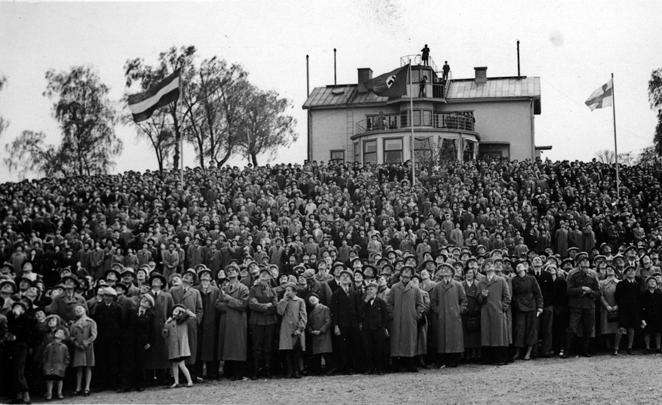
The opening ceremony of Artukainen Field in Turku on 8 September 1935. Photo: G. Ståhle collection
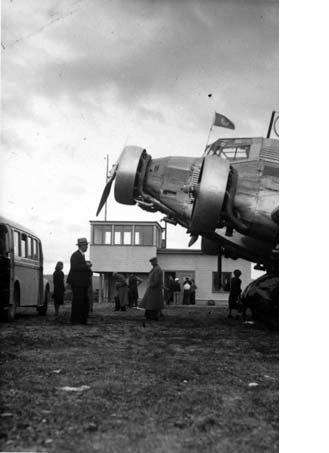
Smaller Airports had a rather more primitive infrsstructure – The Terminus of the “Lapland Express” - Yläluostari Field (Petsamo)
The Construction of Malmi Airport
Prior to the contrsuction of Malmi Airport, the area of Tattarisuo was a swamp. But elsewhere throughout the world Governments encouraged the building of land airports near the most significant cities. In spite of Finlands thousands of lakes, the era of floatplanes was coming to an end in Finland. Many were still nostalgic and harbored rosy dreams: "Maybe after all... fields should be saved for agriculture". The relatively young Finnish state was looking for a location for its capital's airport. The City Council of Helsinki decided to try and take the easy way out, in 1932 offering the worthless seafront of northern Vanhakaupunki as a location for the new land airport. Thus, the city would get rid of a piece of wasteland and the State would build and pay for the airport needed by Helsinki. Those in charge of the matter did not fall for this and turned the offer down. The next location was found in 1933 far from the city center, on the fields of Tuomarinkylä. The area was prime-quality farmland, and the farmers shed copious tears over the matter. An alternative was sought after, and then someone came up with Tattarisuo by Malmi. In May 1935, the City of Helsinki and the State signed an agreement to build the airport. The City allocated a 55-hectare area in Tattarisuo to the State’s needs for a period of 99 years (The agreement is valid until the year 2034).
The loudest critic of the airport-to-be was the most famous Finnish aviator and expert, Captain Väinö Bremer, who reminded everyone of the dangers and troubles the treacherous swamp would bring along. Nobody believed him. On a worthless swamp (from the City's point of view) the State built an airport with four 800-meter runways, and a 104-meter-long hangar which in the drawing board phase was the biggest in Europe at that time. In addition, an administrative building with a passenger lounge, a restaurant, a meterological station and a control tower, a Customs office and other necessary facilities were to be erected. The airport was equipped with the most modern lighting and communications systems which represented the peak of know-how and technology of the time.

The roof of the hanger being built in 1937
The Difficult Beginning
The swamp didn't surrender to the constructors easily. With the machinery and tools of that time the task had seemed impossible. Horses and carriages were felt to be best suited for the job, and temporary tracks criss-crossed the swaying swamp. A man and a shovel rose n priority as the bottomless swamp came up with all kinds of surprises. The subsurface drainage and sewerage system of the area proved to be the key prerequisite to the whole project. The massive buildings of Malmi Airport were erected not only to serve their purpose but also as monuments of sleek 1930’s functionalist architecture. The airport terminal building was designed by Dag Englund, a well-known young Finnish architect and the airport as a whole was an impressive avant-garde achievement that won international recognition. Malmi Airport was the first airfield in Finland to be designed from scratch, buildings and all, as an international passenger airport. Its 2.400-ft concrete-paved runways, built on difficult ground, as well as the instrument approach systems and other equipment represented the most modern way of airport-building in those days. Traffic began in December 1936, when only the runways had been completed, to save the capital from being left out of the route network as all passenger aircraft were quickly converted from floats to wheels for operation from the land airports in Turku and Stockholm. At that time the terminal and the hangar were still under construction.
The functionalist buildings of Malmi Airport were designed by Dag Englund, Onni Ermala and Vera Rosendahl of the office architect group of the Board of Public Buildings. The shining white, round terminal building with its wings and continuous view balcony was sited in the optimal location towards the runways. The semicircular restaurant offered an excellent view of both the air traffic and the bustle of the departures and arrivals lounge. The stylish 300-ft hangar was, upon its completion in 1937, the second largest in Europe and could accommodate six large Junkers Ju-52 airliners. The hangar was also fully equipped for the maintenance and repairs of aircraft, engines and propellers.
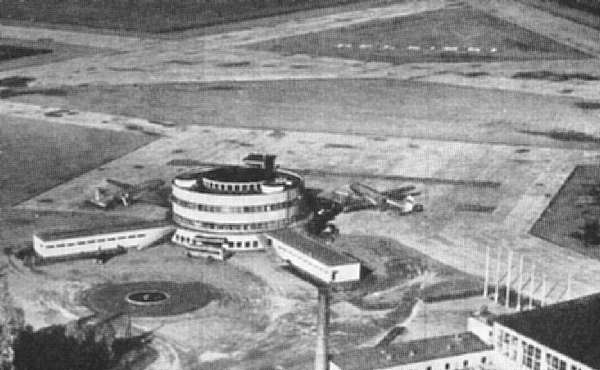
Malmi Airport Terminal Building Post-WW2 but structurally unchanged from it’s pre-War opening
But in the end all obstacles were surmounted and the airport construction was completed. Modest air traffic began on the 16th of December 1936, and in the turn of the year 1936-1937 the air route between Malmi-Turku-Stockholm was opened. The Swedish AB Aerotransport operated the flights and a bit later Aero Oy's aircraft joined in when the Junkers 52/3m aircraft had been stripped of floats and re-equipped with landing gear. In the year 1937 some 15,000 passengers departed from and arrived at Malmi. Compared to the numbers of passengers at present-day Helsinki-Vantaa Airport, this figure seems amusingly small, but so were the aircraft. The Junkers 52, known as "Junnu", could take on 14 passengers and a crew of three. In 1937, the number of passenger seats was increased to sixteen. In the middle of the same year, 14 scheduled flights a day landed at and departed from Malmi to the most important cities in Europe, even to Jerusalem with a connection via Warsaw (The longest air route in Europe, flown by LOT, reached from Helsinki to Jerusalem with the 2,800-mile journey taking a day and a half). A flight to London took 11 hours, to Berlin seven hours, and one could get to Stockholm in just a couple of hours. Among foreign airlines, the Polish LOT and the Swedish ABA were represented, as was Lufthansa.
A Reminder from Tattarisuo Swamp
On Thursday, 29 July 1937 at 5 o'clock in the afternoon the pride of Germany, the giant of the skies, the Junkers G-38 “Generalfeldmarschall von Hindenburg” landed at Malmi Airport. Among others, the Councillers of the City Council of Helsinki had hurried straight from their meeting to witness this wonder. In front of the administrative building stood a huge corrugated-steel four-engined Junkers with four-blade propellers. It had brought the Latvian team to participate in the World Shooting Championship Contest being held in Helsinki. The aircraft had been built as early as 1931, when diesel engines were still believed in as aircraft power plants. It had four 750-horsepower engines, a cabin with two decks and room for 34 passengers, a crew of seven (including on board mechanics who were able to service the engines in flight due to the G.38's blended wing design which provided access to all four power plants) and a fully furnished dining room. The G.38, during its early life, was the largest land plane in the world, the passenger accommodation was sumptuous by today's standards and was meant to rival that found on the competing Zeppelin service offered by DELAG. The plane was unique in that passengers were seated in the wings, which were 1.7 m (5 ft 7 in) thick at the root. There were also two seats in the extreme nose. The leading edge of each wing was fitted with sloping windscreens giving these passengers a forward-facing view usually available only to pilots. There were three 11 seater cabins, plus smoking cabins and wash rooms. The aircraft was also equipped with modern Telefunken radios and radio navigation equipment.
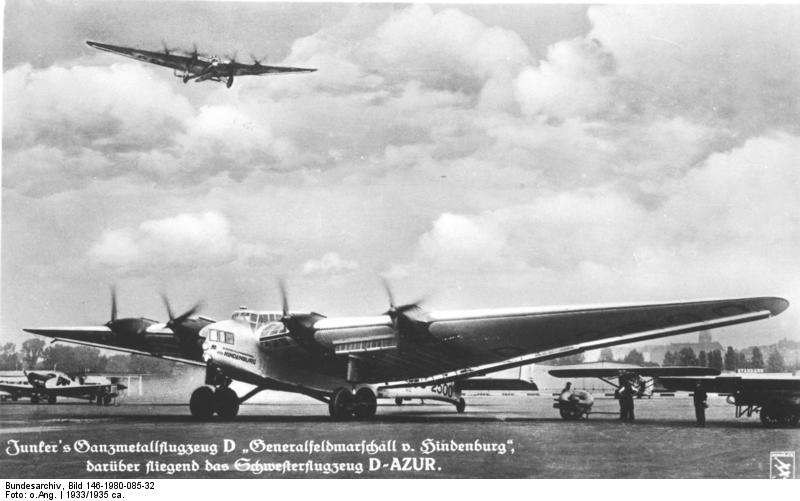
Junkers G-38 - I
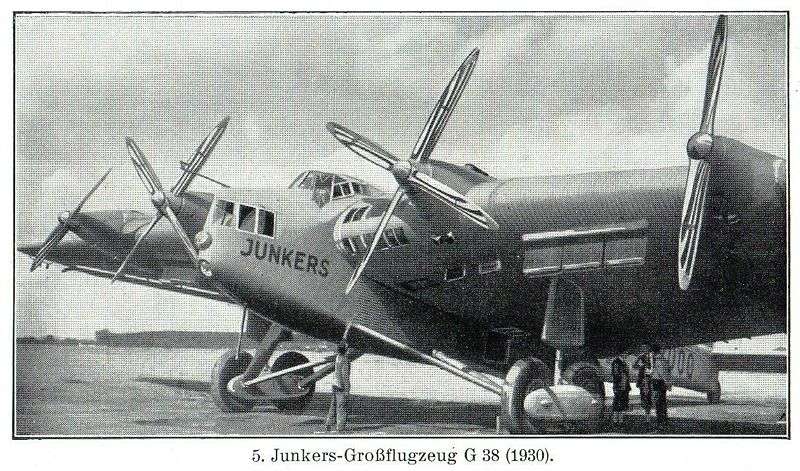
Junkers G-38 - II
This visit was also the last one for this aircraft; when preparing for take-off, it sank axle-deep into the swamp at the end of the runway close to Tapanila. The pride of Germany lay in the bog, and the prophecy of Väinö Bremer had been fulfilled 100 percent for the first time. Finally, after a lot of grunting, digging and pulling, the aircraft was dragged out of the swamp and onto the runway, but the Germans had had it with Tattarisuo for the time being. Out of politeness, the newspapers didn't write much about the incident. For mighty Germany and the City Counsellors of Helsinki such publicity would have been humiliating. With an empty aircraft, Captain Brauer took off in his Hindenburg, probably steaming beads of sweat in his uniform cap and awaiting eagerly the solid concrete surface of Berlin Airport.
The Inauguration of Malmi Airport - 15 May 1938
The day of completion finally dawned, and an exceptionally big opening ceremony was attended by 2,000 invited guests, including among others Prime Minister Cajander, Speaker of Parliament Hakkila, Secretary of State Holsti and other members of the cabinet. General Mannerheim and other representatives of the military high command, almost all of the diplomatic corps, a large group of Members of Parliament and representatives of the City of Helsinki were also all in attendance. A large airshow had been organized by SIPL (the Finnish Air Defense League) and this was watched by 25,000 satisfied viewers. One of the most peculiar specialties was a German autogiro that flew without wings. The autogiro was an early phase in the development of helicopters; rotors replaced the wing and an ordinary airplane propeller maintained airspeed. In those days, industrializing Germany was the leader in aviation, and German aircraft were strongly represented in the programme of the airshow.
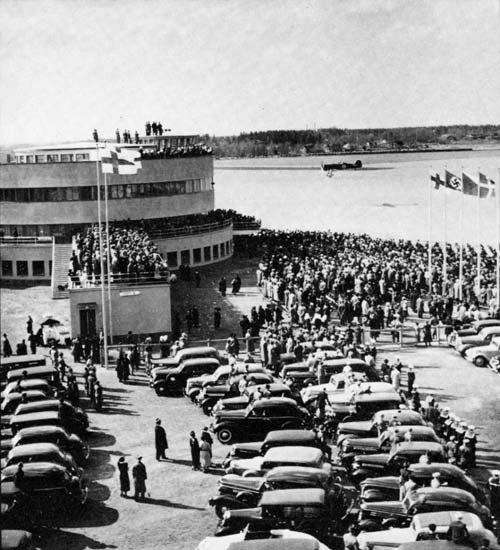
The opening of Helsinki Airport at Malmi, 15 May 1938. Photo: Aarne Pietinen
In this manner, Malmi Airport also claimed its first victims when a Latvian two-seat sportsplane that had participated in the airshow crashed in the fields of Viikki, killing both pilots. One of them was a Finnish student of technology. The prospects of passenger air traffic were promising. Several foreign airlines, with AB Aerotransport, LOT and Lufthansa at the head, opened regular routes to Helsinki. In 1938, the number of air operations increased in cooperation with Deutsche Lufthansa. Scheduled flights to Germany reached all the way to Königsberg and as mentioned, to Berlin. Aero was looking for larger passenger aircraft. The German four-engine Focke-Wulf Condor was found suitable and in anticipation of the 1940 Helsinki Olympics, in early 1938 Aero ordered four German Focke-Wulf Fw 200B (Condor) aircraft, to be delivered in early. Delivered in early 1939, the Condors began to fly two new routes from Malmi - Helsinki-London-New York and Helsinki-Paris-Rome.And with the 1940 Helsinki Olympic Games approaching, the exceptionally stylish and modern airport was completed just in time. It was a handsome showcase of a young, sovereign nation opening its doors to the outside world. In autumn 1939 the north-south runway was already being extended to 4.200 ft with the new large airliners and the lively Olympic traffic in mind and regular flights into Helsinki by KLM and BOAC had begun.
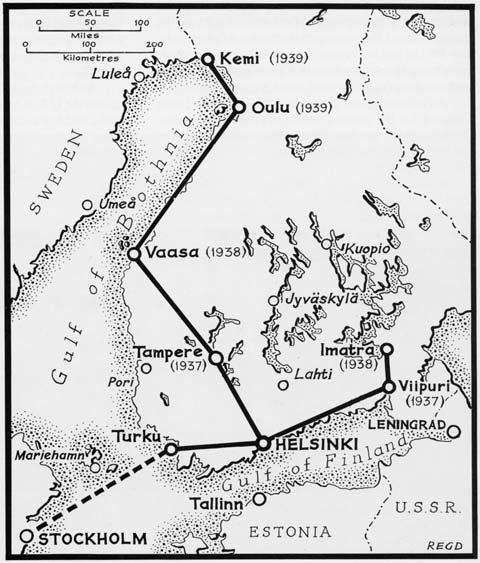
The expansion of Aero’s domestic routes in 1937-1939. Photo: Finnair
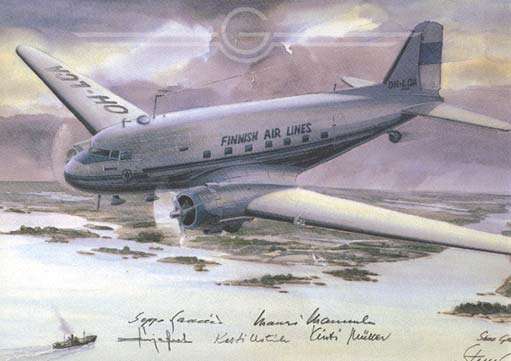
"Sotka" The first DC-3 of Aero Oy (1938). OH-LCA "Sotka" was the first of a series of DC3 aircraft delivered to Finland prior to WW2. They flew as passenger aircraft prior to the Winter War, were mobilized by the Ilmavoimat for the duration of WW2 and post-war, after being refurbished, went back into passenger service with Aero Oy (which was be then renamed Finnish Air Lines). Ten of the DC-3s that survived the war were in operation from 1946 to 1965. The depicted OH-LCA was destroyed in an accident in November 1963. The Print is by Sture Gripenberg, taken from a watercolour (http://personal.eunet.fi/pp/gdes/ENG/21.htm). The proofs are signed by captains Seppo Saario, Mauri Maunola and Börje Hielm, radio operator Kosti Uotila and stewardess Kirsti Müller.
Following its construction, Malmi would go on to become an important base for the Ilmavoimat as it grew in strength in the period leading up to the Winter War and WW2 (as would the other civil airports within Finland). Malmi was also the home of Aero Oy’s maintenance workshops and hangers.
“And then, suddenly, we’re in the midst of radiant sunshine above the fog. And everything calms in the mind: the immense blue of the sky, the blaze of the sun, the endless landscape of clouds underneath make a boundless peace seep into the mind.” …..Mika Waltari, 1937
In the 1920’s, air travel was still in its infancy and passenger air traffic was scarce. The modest route network consisted of both land airports and air harbors. The Nordic countries with their coastlines and lakes were especially suited for seaplane traffic. As a consequence, a perfunctory attitude towards building expensive land airports prevailed in Finland – the land of a thousand lakes with its long coastline was perfect for seaplane traffic, flown already in 1924 by the domestic airline Aero Oy. By the early 1930’s, however, land airports for passenger traffic had already established themselves in continental Europe to a degree that was making air harbors for seaplanes and floatplanes obsolete as elements of the expanding route network. From the point of view of the rest of Europe, Finland resembled an island. Thus it was imperative to keep up with development, and in the early 1930’s the planning of land airports commenced in the major cities of Finland. By the end of the decade, regular traffic was already served by several airports such as Artukainen Field in Turku, Malmi Airport in Helsinki, Oritkari Field in Oulu and the airfields of Vyborg, Imatra, Vaasa and Kemi.
The first-generation passenger airports in Finland were mostly austere and simple, and their modest wooden terminals and hangars did not aim for architectural merit. The international airports, Artukainen in Turku and Malmi in Helsinki, were an exception. Artukainen Field was the first land airport for passenger traffic in Finland. It was ceremoniously inaugurated by President P.E. Svinhufvud in September 1935. The steward’s residence of old Artukainen Manor had been modernized in the functionalist style to serve as the terminal. Artukainen Field was an important gateway for international traffic and an intermediate point on the route from Helsinki to the brand new Bromma Airport in Stockholm, Sweden. The route was opened in late 1936 when the runways of Helsinki-Malmi Airport had been completed. Artukainen Field also served regular domestic traffic to the new land airports in Helsinki and Vaasa.

The opening ceremony of Artukainen Field in Turku on 8 September 1935. Photo: G. Ståhle collection

Smaller Airports had a rather more primitive infrsstructure – The Terminus of the “Lapland Express” - Yläluostari Field (Petsamo)
The Construction of Malmi Airport
Prior to the contrsuction of Malmi Airport, the area of Tattarisuo was a swamp. But elsewhere throughout the world Governments encouraged the building of land airports near the most significant cities. In spite of Finlands thousands of lakes, the era of floatplanes was coming to an end in Finland. Many were still nostalgic and harbored rosy dreams: "Maybe after all... fields should be saved for agriculture". The relatively young Finnish state was looking for a location for its capital's airport. The City Council of Helsinki decided to try and take the easy way out, in 1932 offering the worthless seafront of northern Vanhakaupunki as a location for the new land airport. Thus, the city would get rid of a piece of wasteland and the State would build and pay for the airport needed by Helsinki. Those in charge of the matter did not fall for this and turned the offer down. The next location was found in 1933 far from the city center, on the fields of Tuomarinkylä. The area was prime-quality farmland, and the farmers shed copious tears over the matter. An alternative was sought after, and then someone came up with Tattarisuo by Malmi. In May 1935, the City of Helsinki and the State signed an agreement to build the airport. The City allocated a 55-hectare area in Tattarisuo to the State’s needs for a period of 99 years (The agreement is valid until the year 2034).
The loudest critic of the airport-to-be was the most famous Finnish aviator and expert, Captain Väinö Bremer, who reminded everyone of the dangers and troubles the treacherous swamp would bring along. Nobody believed him. On a worthless swamp (from the City's point of view) the State built an airport with four 800-meter runways, and a 104-meter-long hangar which in the drawing board phase was the biggest in Europe at that time. In addition, an administrative building with a passenger lounge, a restaurant, a meterological station and a control tower, a Customs office and other necessary facilities were to be erected. The airport was equipped with the most modern lighting and communications systems which represented the peak of know-how and technology of the time.

The roof of the hanger being built in 1937
The Difficult Beginning
The swamp didn't surrender to the constructors easily. With the machinery and tools of that time the task had seemed impossible. Horses and carriages were felt to be best suited for the job, and temporary tracks criss-crossed the swaying swamp. A man and a shovel rose n priority as the bottomless swamp came up with all kinds of surprises. The subsurface drainage and sewerage system of the area proved to be the key prerequisite to the whole project. The massive buildings of Malmi Airport were erected not only to serve their purpose but also as monuments of sleek 1930’s functionalist architecture. The airport terminal building was designed by Dag Englund, a well-known young Finnish architect and the airport as a whole was an impressive avant-garde achievement that won international recognition. Malmi Airport was the first airfield in Finland to be designed from scratch, buildings and all, as an international passenger airport. Its 2.400-ft concrete-paved runways, built on difficult ground, as well as the instrument approach systems and other equipment represented the most modern way of airport-building in those days. Traffic began in December 1936, when only the runways had been completed, to save the capital from being left out of the route network as all passenger aircraft were quickly converted from floats to wheels for operation from the land airports in Turku and Stockholm. At that time the terminal and the hangar were still under construction.
The functionalist buildings of Malmi Airport were designed by Dag Englund, Onni Ermala and Vera Rosendahl of the office architect group of the Board of Public Buildings. The shining white, round terminal building with its wings and continuous view balcony was sited in the optimal location towards the runways. The semicircular restaurant offered an excellent view of both the air traffic and the bustle of the departures and arrivals lounge. The stylish 300-ft hangar was, upon its completion in 1937, the second largest in Europe and could accommodate six large Junkers Ju-52 airliners. The hangar was also fully equipped for the maintenance and repairs of aircraft, engines and propellers.

Malmi Airport Terminal Building Post-WW2 but structurally unchanged from it’s pre-War opening
But in the end all obstacles were surmounted and the airport construction was completed. Modest air traffic began on the 16th of December 1936, and in the turn of the year 1936-1937 the air route between Malmi-Turku-Stockholm was opened. The Swedish AB Aerotransport operated the flights and a bit later Aero Oy's aircraft joined in when the Junkers 52/3m aircraft had been stripped of floats and re-equipped with landing gear. In the year 1937 some 15,000 passengers departed from and arrived at Malmi. Compared to the numbers of passengers at present-day Helsinki-Vantaa Airport, this figure seems amusingly small, but so were the aircraft. The Junkers 52, known as "Junnu", could take on 14 passengers and a crew of three. In 1937, the number of passenger seats was increased to sixteen. In the middle of the same year, 14 scheduled flights a day landed at and departed from Malmi to the most important cities in Europe, even to Jerusalem with a connection via Warsaw (The longest air route in Europe, flown by LOT, reached from Helsinki to Jerusalem with the 2,800-mile journey taking a day and a half). A flight to London took 11 hours, to Berlin seven hours, and one could get to Stockholm in just a couple of hours. Among foreign airlines, the Polish LOT and the Swedish ABA were represented, as was Lufthansa.
A Reminder from Tattarisuo Swamp
On Thursday, 29 July 1937 at 5 o'clock in the afternoon the pride of Germany, the giant of the skies, the Junkers G-38 “Generalfeldmarschall von Hindenburg” landed at Malmi Airport. Among others, the Councillers of the City Council of Helsinki had hurried straight from their meeting to witness this wonder. In front of the administrative building stood a huge corrugated-steel four-engined Junkers with four-blade propellers. It had brought the Latvian team to participate in the World Shooting Championship Contest being held in Helsinki. The aircraft had been built as early as 1931, when diesel engines were still believed in as aircraft power plants. It had four 750-horsepower engines, a cabin with two decks and room for 34 passengers, a crew of seven (including on board mechanics who were able to service the engines in flight due to the G.38's blended wing design which provided access to all four power plants) and a fully furnished dining room. The G.38, during its early life, was the largest land plane in the world, the passenger accommodation was sumptuous by today's standards and was meant to rival that found on the competing Zeppelin service offered by DELAG. The plane was unique in that passengers were seated in the wings, which were 1.7 m (5 ft 7 in) thick at the root. There were also two seats in the extreme nose. The leading edge of each wing was fitted with sloping windscreens giving these passengers a forward-facing view usually available only to pilots. There were three 11 seater cabins, plus smoking cabins and wash rooms. The aircraft was also equipped with modern Telefunken radios and radio navigation equipment.

Junkers G-38 - I

Junkers G-38 - II
This visit was also the last one for this aircraft; when preparing for take-off, it sank axle-deep into the swamp at the end of the runway close to Tapanila. The pride of Germany lay in the bog, and the prophecy of Väinö Bremer had been fulfilled 100 percent for the first time. Finally, after a lot of grunting, digging and pulling, the aircraft was dragged out of the swamp and onto the runway, but the Germans had had it with Tattarisuo for the time being. Out of politeness, the newspapers didn't write much about the incident. For mighty Germany and the City Counsellors of Helsinki such publicity would have been humiliating. With an empty aircraft, Captain Brauer took off in his Hindenburg, probably steaming beads of sweat in his uniform cap and awaiting eagerly the solid concrete surface of Berlin Airport.
The Inauguration of Malmi Airport - 15 May 1938
The day of completion finally dawned, and an exceptionally big opening ceremony was attended by 2,000 invited guests, including among others Prime Minister Cajander, Speaker of Parliament Hakkila, Secretary of State Holsti and other members of the cabinet. General Mannerheim and other representatives of the military high command, almost all of the diplomatic corps, a large group of Members of Parliament and representatives of the City of Helsinki were also all in attendance. A large airshow had been organized by SIPL (the Finnish Air Defense League) and this was watched by 25,000 satisfied viewers. One of the most peculiar specialties was a German autogiro that flew without wings. The autogiro was an early phase in the development of helicopters; rotors replaced the wing and an ordinary airplane propeller maintained airspeed. In those days, industrializing Germany was the leader in aviation, and German aircraft were strongly represented in the programme of the airshow.

The opening of Helsinki Airport at Malmi, 15 May 1938. Photo: Aarne Pietinen
In this manner, Malmi Airport also claimed its first victims when a Latvian two-seat sportsplane that had participated in the airshow crashed in the fields of Viikki, killing both pilots. One of them was a Finnish student of technology. The prospects of passenger air traffic were promising. Several foreign airlines, with AB Aerotransport, LOT and Lufthansa at the head, opened regular routes to Helsinki. In 1938, the number of air operations increased in cooperation with Deutsche Lufthansa. Scheduled flights to Germany reached all the way to Königsberg and as mentioned, to Berlin. Aero was looking for larger passenger aircraft. The German four-engine Focke-Wulf Condor was found suitable and in anticipation of the 1940 Helsinki Olympics, in early 1938 Aero ordered four German Focke-Wulf Fw 200B (Condor) aircraft, to be delivered in early. Delivered in early 1939, the Condors began to fly two new routes from Malmi - Helsinki-London-New York and Helsinki-Paris-Rome.And with the 1940 Helsinki Olympic Games approaching, the exceptionally stylish and modern airport was completed just in time. It was a handsome showcase of a young, sovereign nation opening its doors to the outside world. In autumn 1939 the north-south runway was already being extended to 4.200 ft with the new large airliners and the lively Olympic traffic in mind and regular flights into Helsinki by KLM and BOAC had begun.

The expansion of Aero’s domestic routes in 1937-1939. Photo: Finnair

"Sotka" The first DC-3 of Aero Oy (1938). OH-LCA "Sotka" was the first of a series of DC3 aircraft delivered to Finland prior to WW2. They flew as passenger aircraft prior to the Winter War, were mobilized by the Ilmavoimat for the duration of WW2 and post-war, after being refurbished, went back into passenger service with Aero Oy (which was be then renamed Finnish Air Lines). Ten of the DC-3s that survived the war were in operation from 1946 to 1965. The depicted OH-LCA was destroyed in an accident in November 1963. The Print is by Sture Gripenberg, taken from a watercolour (http://personal.eunet.fi/pp/gdes/ENG/21.htm). The proofs are signed by captains Seppo Saario, Mauri Maunola and Börje Hielm, radio operator Kosti Uotila and stewardess Kirsti Müller.
Following its construction, Malmi would go on to become an important base for the Ilmavoimat as it grew in strength in the period leading up to the Winter War and WW2 (as would the other civil airports within Finland). Malmi was also the home of Aero Oy’s maintenance workshops and hangers.
Last edited by CanKiwi2 on 09 Jun 2011, 17:35, edited 1 time in total.
ex Ngāti Tumatauenga ("Tribe of the Maori War God") aka the New Zealand Army
- Juha Tompuri
- Forum Staff
- Posts: 11563
- Joined: 11 Sep 2002, 21:02
- Location: Mylsä
Re: What If - Finland had been prepared for the Winter War?
Very nice work again!
Thank You.
Wonder what were the names of the "missing" two ones? Myllykoski and...
Regards, Juha
Thank You.
Perhaps youalready know, but actually two were ordered (never delivered) with names Petsamo and Karjala.CanKiwi2 wrote:in anticipation of the 1940 Helsinki Olympics, in early 1938 Aero ordered four German Focke-Wulf Fw 200B (Condor) aircraft, to be delivered in early 1939.
Wonder what were the names of the "missing" two ones? Myllykoski and...
Regards, Juha
Re: What If - Finland had been prepared for the Winter War?
Hi JuhaJuha Tompuri wrote:Very nice work again!
Thank You.Perhaps youalready know, but actually two were ordered (never delivered) with names Petsamo and Karjala.CanKiwi2 wrote:in anticipation of the 1940 Helsinki Olympics, in early 1938 Aero ordered four German Focke-Wulf Fw 200B (Condor) aircraft, to be delivered in early 1939.
Wonder what were the names of the "missing" two ones? Myllykoski and...
Regards, Juha
Yes, knew it was actually two ordered but never delivered - didn't know their names. I moved the dates up a bit as well. The names will be useful later on.... Now if you can suggest a 4th name
Kiitos............Nigel
ex Ngāti Tumatauenga ("Tribe of the Maori War God") aka the New Zealand Army
More on Airports and Aircraft Construction in Finland
More on Airports and Aircraft Construction in Finland
Another important field was Härmälä Airport - built in 1936 in Härmälä (a district of Tampere) located some 6 kilometres (3.7 mi) from the centre of Tampere. Härmälä Airport was connected to Helsinki, Vaasa, Oulu and Kemi by Aero O/Y. The first terminal building was built in 1938 as part of the program to develop Finland’s civil aviation infrastructure. While Aero Oy was based from Malmi Field outside Helsinki, Härmälä Airport became the base of Veljekset Karhumäki (the "Karhumäki Brothers") - later to be known as Karhumäki Airways and then as Kar-Air). With the acquisition of the Douglas DC3’s in 1938, Veljekset Karhumäki introduced scheduled routes Tampere-Stockholm, Tampere-Tallinn and Tampere-Copenhagen from the summer of that year, direct flights to Göteborg, Malmö and Luleå in late 1938 and Tampere-Warsaw and Tampere-Berlin in early 1939.. Tampere was an important industrial city, and with Finland’s surging economic growth, Tampere-based companies were doing business across Europe. Based in Tampere as they were, Veljekset Karhumäki capitalised on this growth, enabling business executives and salesmen to fly internationally direct from Tampere rather than via Helsinki.

The Photo shows the old Härmälä Airport Terminal and Control Tower, which was built in 1938 (OTL-1941) and used up to 1979. The old airport area has been redeveloped since the 1980's as a housing area. The old airport terminal has been renovated as an exhibition hall and for sports - Pirkkahalli. All the new street names in the subdivision somehow relate to aviation.
Following its construction in 1936, Härmälä Airport outside Tampere also became the new home of Valtion Lentokonetehdas (the State Aircraft Factory).
Ilmailuvoimien Lentokonetehdas / the Finnish Airforce Aircraft Factory)
Valtion Lentokonetehdas or VL as it was more commonly referred to, started life as IVL (Ilmailuvoimien Lentokonetehdas / the Finnish Airforce Aircraft Factory) founded in 1921. But the starting point had actually been a little earlier – in the Civil War, the Russian military airport near Turku had been captured by the Finnish White Army and in late 1918, repairs to aircraft and aircraft engines belonging to the nacent Ilmavoimat were made there. In the autumn of 1919 the repairshop was transferred to Santahamina military base (in Helsinki) and renamed "Ilmailutelakka" (literally: Aero Dockyard), and was made a unit of the “Ilmailupataljoona” (Aviation Battalion) which was then later renamed “Lentopataljoona” (Flight Battalion). This "dockyard" took care of repairing aircraft and their engines and was, as the name illustrates, a seaplane base.A separate aircraft factory got under way in 1920 amd in May of 1920 Ilmailuvoimien Lentokonetehdas (usually abbreviated to IVL or I.V.L) existed alongside the "Aviation Dockyard."
IVL had begun its production at Suomenlinna and Santahamina in Helsinki, with the Suomenlinna location being used for new aircraft construction and Santahamina being used as the repair base for aircraft and engines. The early aircraft factory did not have an airport, only the sea and sea ice could be used for take-off and landing as most of the aircraft built in Helsinki were seaplanes. The aircraft built were small and much of the final assembly was done outdoors. IVL’s first managing director was Luutnantti (Lt) Asser Järvinen who had studied aircraft building in France, which at that time was one of the best sources of aviation expertise, for a short period.
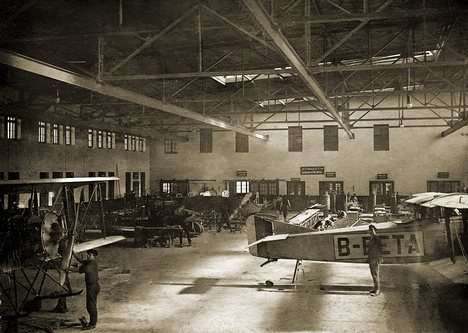
Ilmavoimien Lentokonetehdas, IVL – late 1920’s
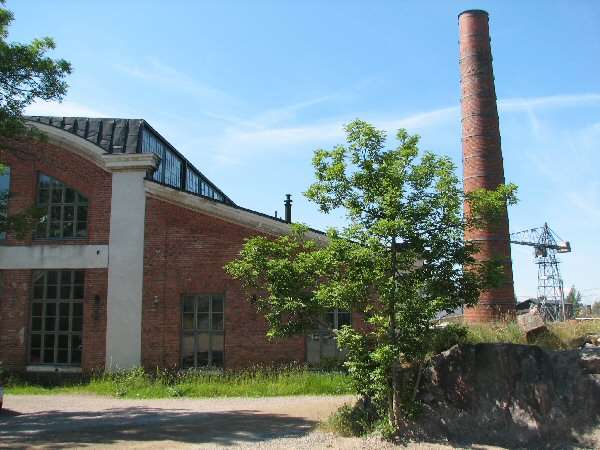
Two photos of the exterior of the old aircraft factory building, this was the factory building of Ilmavoimien Lentokonetehdas from 1921 - 1928 and Valtion Lentokonetehdas from 1928 - 1936. Photos taken by Jarkko in Suomenlinna in 2010 (photo courtesy of www.jaegerplatoon.net).
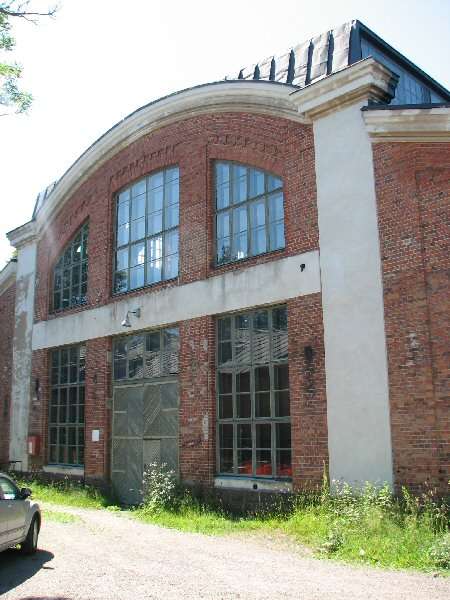
Two photos of the exterior of the old aircraft factory building, this was the factory building of Ilmavoimien Lentokonetehdas from 1921 - 1928 and Valtion Lentokonetehdas from 1928 - 1936. Photos taken by Jarkko in Suomenlinna in 2010 (photo courtesy of www.jaegerplatoon.net).
The first aircraft to be built by IVL were the Hansa-Brandenburg aircraft mentioned in an earlier post on the Ilmavoimat – in 1921 Finland had obtained the manufacturing license for the Hansa-Brandenburg W.33. The first Finnish IVL -built Hansa made its maiden flight on November 4, 1922 and was in Finland was designated the IVL A.22 Hansa. This aircraft was the first industrially manufactured aircraft in Finland and over the following four years a total of 120 of the aircraft were manufactured. This aircraft would become the second most numerous aircraft built in Finland for the Finnish Air Force. With the purchase of the license to build the Hansa-Brandenburgs, six Germans came to work in the Suomenlinna factory, where they were supported by 12 Finnish mechanics and carpenters. G. Semeniuksen managed the factory and G. Jäderholm was the test pilot.
The IVL A.22 Hansa was a Finnish-licensed copy of the German Hansa-Brandenburg W.33, a two-seat, singe-engined low-winged monoplane flying boat. The Hansa-Brandenburg W.33 was designed in 1916 by Ernst Heinkel and entered German service in 1918. Twenty-six aircraft of this design were built in Germany, only six of them before the collapse of Germany. The W.33 proved to be an excellent aircraft, with the Hansa-Brandenburg monoplanes considerably influencing German seaplane design. Several copies appeared in 1918, such as the Friedrichshafen FF.63, the Dornier Cs-I, the Junkers J.11, and the L.F.G. Roland ME 8. After the war a version of the W.29 was also used by Denmark.
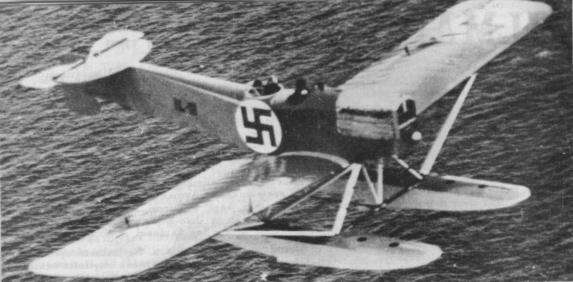
Hansa-Brandenburg. Technical information: Wooden construction, two-seat sea plane. Weight 2124 kg, Max speed 170 km/h (99mph), wingspan 15.85 m, length 11.10 m, endurance 6 hours. Weapons: navigator's twin machine gun, bombs 4x10 kg. It had good flight characteristics, but its gross weight tended to increase with age due to water soaking, which led to problems in calm weather takeoffs.
Of Note: The Finnish Broadcasting Company Yle has been transferring it's archives to the internet and one of the videos is about the Finnish Air Force Airshow in 1926. The plane in the film is 4F66 which was the 66th Hansa build in Finland. It was taken into service in 20th December 1924. To see the video click the link and press "play" below the image and next to "armeijan lentonäytös". If you have enough bandwidth you can choose bigger image by pressing "play" and then select "asetukset" from right hand top corner and then select "1 Mbps tai nopeampi" and "tallenna asetukset".
http://www.yle.fi/elavaarkisto/?s=s&g=1&ag=1&t=&a=47
A new, longer version of this film has also been published. More Hansa’s and a Breguet 14. Use this link.
http://www.yle.fi/elavaarkisto/?s=s&g=1&ag=1&a=2306
The Santahamina factory also built six Caudron G.3 Aircraft under license between 1920 and 1924 (incidentally, construction of the Caudron G.3’s started prior to the Hansa-Brandenburgs ). 12 had been bought from France, six were built in Finland by the newly established Santahaminan Ilmailutelakka and two aircraft and spares were purchased from Flyg Aktiebolaget on April 26, 1923 together with a Caudron G.4 for 100,000 Finnish markka. The Finnish-constructed aircraft had worse flying characteristics than the French machines due to a bad wing profile. The FAF used a total of 19 Caudron G.3 aircraft, which was called Tutankhamon in Finland. The Caudron G.3 was used by the FAF between 1920 and 1924.
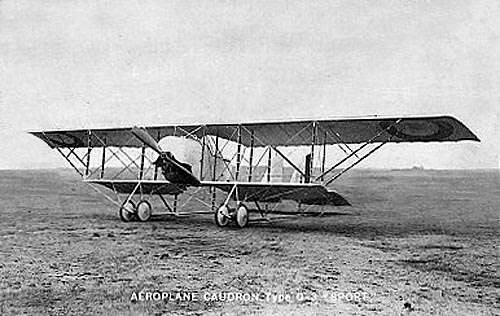
The Caudron G.3 was a single-engined French biplane built by Caudron, widely used in World War I as a reconnaissance aircraft and trainer. It first flew in May 1914 at their Le Crotoy aerodrome. The aircraft had a short crew nacelle, with a single engine in the nose of the nacelle, and twin open tailbooms. It was of sesquiplane layout, and used wing warping for lateral control, although this was replaced by conventional ailerons fitted on the upper wing in late production aircraft. Following the outbreak of the First World War, it was ordered in large quantities. Usually, the G.3 was not equipped with any weapons, although sometimes light, small calibre machine guns and some hand-released small bombs were fitted to it. It continued in use as a trainer after ceasing combat operations until after the end of the war. One aircraft (1E.18) is currently being repaired at the Hallinportti Aviation Museum.
In 1922, the company hired an engineer, K W Berger, who had studied in London. He first designed an improved propeller for the Hansa Brandenburg and then went on to design the C.24 (1924), C.VI.25 (1925) and Haukka I (1927) - only a single prototype of each was built. In 1928 two prototypes of the Haukka II were built. None of these aircraft were mass-produced and only the Haukka could be said to be a successful design. In 1928 a prototype of Berger’s Sääski design was tested and the aircraft was then mass produced as a Trainer. Berger then designed the Kotka – a two-seat, biplane maritime patrol aircraft meant to replace the Blackburn Ripons that were in service with the Finnish Air Force. A prototype made its first flight on September 30, 1930. In 1931 the State Aircraft Factory began producing a series of five aircraft. These were used as liaison aircraft until 1944. Berger also participated in decisions of the Finnish Air Force on the purchases of foreign fighters from Czechoslovakia, Great Britain, the Netherlands, Italy and France in the late 1920s and early 1930s. Berger was dismissed from his position at VL during a company restructuring in 1933.
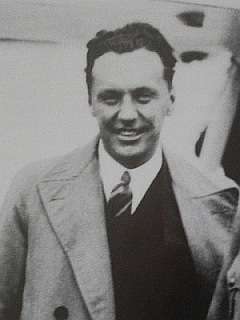
Kurt Volmar Berger (1896–1977) was an aviation engineer and the chief designer at the Finnish aircraft manufacturing company Valtion Lentokonetehtaat for a number of years. K. V. Berger's father, Arnold Berger, was a minister and his mother was Fanny Berger. He became a student at Helsingin Uusi Yhteiskoulu in 1916 and studied as an electrical engineer at the Helsinki University of Technology starting the same autumn, but then volunteered for service with the Jaegers. In 1918 he traveled to Libau in Germany, where he started pilot training on float-equipped aircraft. However, his pilot training was interrupted by the end of World War I and by Germany losing the war. In the end, Berger managed to receive his international civil pilot papers in 1921. In order to continue with his studies, he enrolled at the East London College in 1919 (nowadays called Queen Mary School, University of London), graduating on 5 September 1922.
He was appointed Engineer at the Finnish Air Force Headquarters at Santahamina on 1 November 1923, and later Chief Engineer in 1 March 1924. He was then sent to the Finnish Air Force Aircraft Manufacturing company (Ilmavoimien Lentokonetehdas) where he went on to design the IVL C.24, IVL Haukka I, IVL Haukka II, IVL Sääski and the IVL Kotka aircraft. Berger also participated in decisions of the Finnish Air Force on the purchases of foreign fighters from Czechoslovakia, Great Britain, Italy and France in the late 1920s and early 1930s. Berger was dismissed from his position at VL during a company restructuring in 1933. He continued to work as aircraft inspector at Lentoasema I and Flight Regiment 2. During the Soviet-Finnish Winter War of 1939–40 he supervised the assembly of the Brewster Buffalo fighters in Sweden, as well as served as Chief Engineer of Maintenance and Office Engineer at Finnish Air Force Headquarters. After WW2 he continued in business as a private entrepreneur.
The Ilmavoimat had also purchased 30 Caudron C.60s from France in 1923. A further 34 aircraft were licence built in Finland between 1927 and 1928. These were used as primary trainers until 1936, when they were retired as more modern trainers were brought into service. With a maximum speed of 93mph, a ceiling of 13,120 feet and an endurance of 5 hours, they were a typical biplane trainer of the 1920’s.
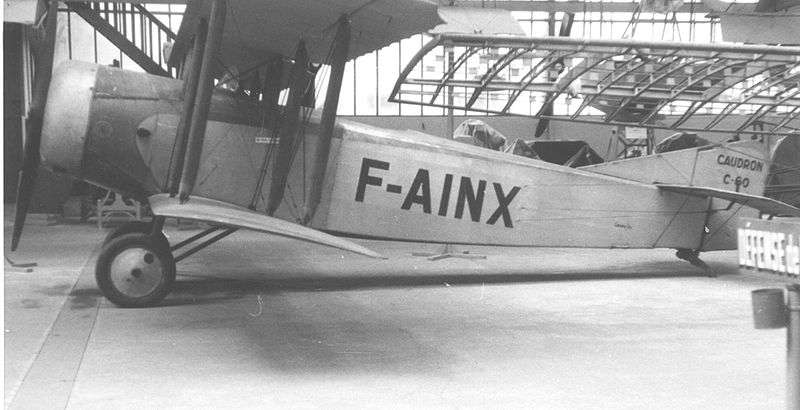
Caudron C.60 Trainer
The Siemens-Schuckert D. VI
In addition to the French fighters, it was decided to manufacture under license was the Siemens-Schuckert D. IV, a late-WW1 Fighter which had a 160 hp Siemens & Halske Sh IIIa Engine. The engines were bought from a surplus warehouse in Copenhagen and at the same time as many as 334 Siemens Schuckertin incomplete drawings were in Finland for 1923. A sample machine was also not available. An attempt to change the License Agreement to specify a newer version of the D-VI was made, but in the summer of 1923 it was advised that the two prototypes of the machine and the design drawings had already been destroyed or damaged in 1919. The attempt to secure a Manufacturing License therefore failed - and it should also be remembered that the acquisition of a German machine was a politically risky thing in the early 1920s
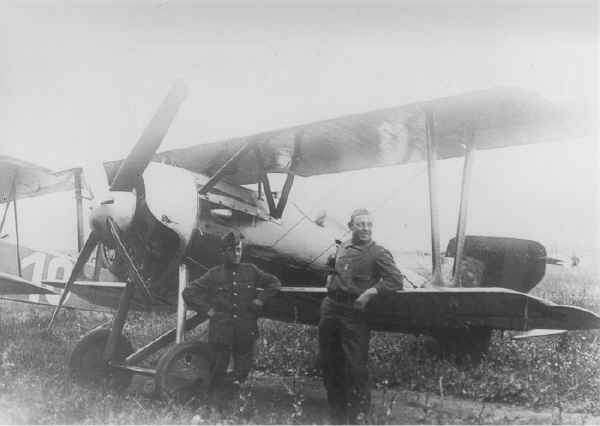
Siemens-Schuckert D. IV
As the license to manufacture the Siemens Schukert D. IV fighter had not eventuated, and the Gourdou Leseurre-GL-21 Fighters had only just been ordered, IVL decided to build a prototype fighter of their own in the interim. This was the Kurt-Berger designed IVL C.24, built in 1924. The IVL C.24 was the first aircraft to be completely designed and built from the ground up in Finland but only one example of the aircraft was manufactured by IVL. The aircraft made its maiden flight on April 16, 1924, piloted by Georg Jäderholm. The aircraft was a single-seater, high-wing monoplane and was designed as a fighter. However, the selected birotary engine (the Siemens & Halske Sh IIIa) was underpowered and unreliable and proved a complete failure, spelling the doom of the project. Worse, flight characteristics were poor and the visibility from the pilot's seat was also very poor. The aircraft was in Finnish Air Force use for a short time as a prototype only.
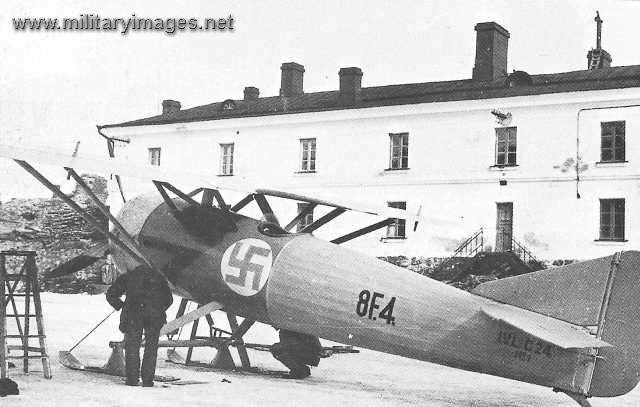
IVL C.24 at Suomenlinna in the Spring of 1924.
A design flaw with the Siemens & Halske Sh IIIa Engine was discovered and the problem was fixed. Berger started the design for a new prototype - the IVL C.VI.25 - a further development of the IVL C.24 on the autumn of 1924. Designed by Berger as a fighter, the aircraft made its maiden flight on June 11, 1925 and was wrecked after a forced landing due to engine trouble on December 17, 1925. Externally it resembled the C.24 closely, but there were large differences in the structure. The C.25 had a thicker and stiffer wing, the airframe was longer and more delicate, better ground clearance and better visibility and the landing gear was new. In testing, the C.25 had better flight characteristics than the Gourdou Fighters, but the aircraft was still under-powered like its predecessor, due to the choice of the same cheap but useless and still unreliable engine as used in its predecessor, power control was poor the test engine failed the 50-hour endurance test dozens of times. The conclusion was that Siemens-Halske Sh IIIa Engine could not power a fighter and it was not considered worthwhile to carry out further development.
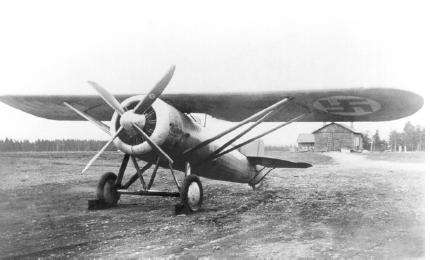
The IVL C.VI.25
In 1926, the Ilmavoimat ordered six Koolhoven F.K.31 two-seat reconnaissance aircraft from the Dutch firm of Koolhoven practically without evaluation and also purchased a manufacturing license. Six Koolhoven’s were built by Ilmailuvoimien Lentokonetehdas. Unfortunately, on taking delivery and testing the aircraft, they were immediately found to be inadequate in all respects and had a weak airframe –simply put, they were dangerous to fly. The Finnish-built aircraft even turned out to be inferior to the Dutch-built examples. Thanks to the exceptionally small number of hours flown and prudent utilization no lives were lost, and by 1932 all 12 Koolhovens had been retired from service.
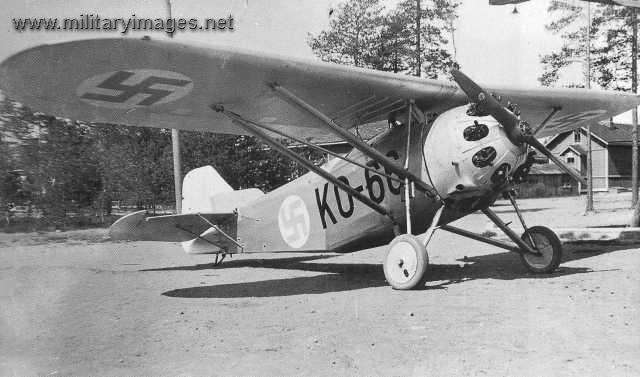
Koolhoven F.K. 31 in summer 1930 at the factory at Suomenlinna
In 1927 Ilmailuvoimien Lentokonetehdas built a prototype of the K.1 Kurki (“Crane”) – designed by Asser Järvinen, this was intended as a four-seated, high-wing trainer aircraft. The prototype was manufactured at the IVL plant at Suomenlinna and made its maiden flight on March 30, 1927. The aircraft was both over weight and too front-heavy. It also had poor flight characteristics. The Finnish Air Force only flew the aircraft 13 hours. No development potential was seen for the overweight "Järvinen's crate", and work on the project was terminated. Only one aircraft was manufactured (the Päijät-Häme Aviation Museum has stored the only Kurki manufactured).

I.V.L K.1 Kurki
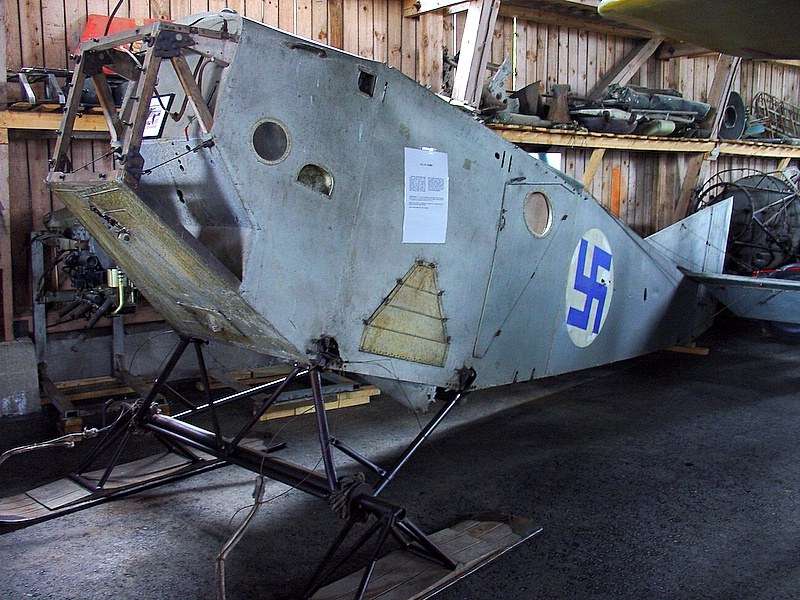
The remains of the only K.1 Kurki in existence - Päijät-Häme Aviation Museum
Overall, aircraft built under the auspices of Ilmailuvoimien Lentokonetehdas included:
Caudron G.3 – 6 built under license
IVL A.22 Hansa-Brandenburg W.33 – 120 built under license
IVL C.24 (protype only)
IVL C.25 (prototype only)
Caudron C.60 – 34 built under license
IVL D.26 Haukka I (prototype only)
IVL K1. Kurki (prototype only)
Valtion Lentokonetehdas or VL as it was more commonly referred to, was founded on 23 February 1928 from I.V.L (the Finnish Airforce Aircraft Factory), at which time the company was transferred from the Ilmavoimat to the Ministry of Defence.
Valtion Lentokonetehdas (the State Aircraft Factory)
Valtion Lentokonetehdas or VL as it was more commonly referred to, was founded on 23 February 1928 from I.V.L (the Finnish Airforce Aircraft Factory), at which time the company was transferred from the Ilmavoimat to the Ministry of Defence. To start with, VL operated from the same locations as IVL.
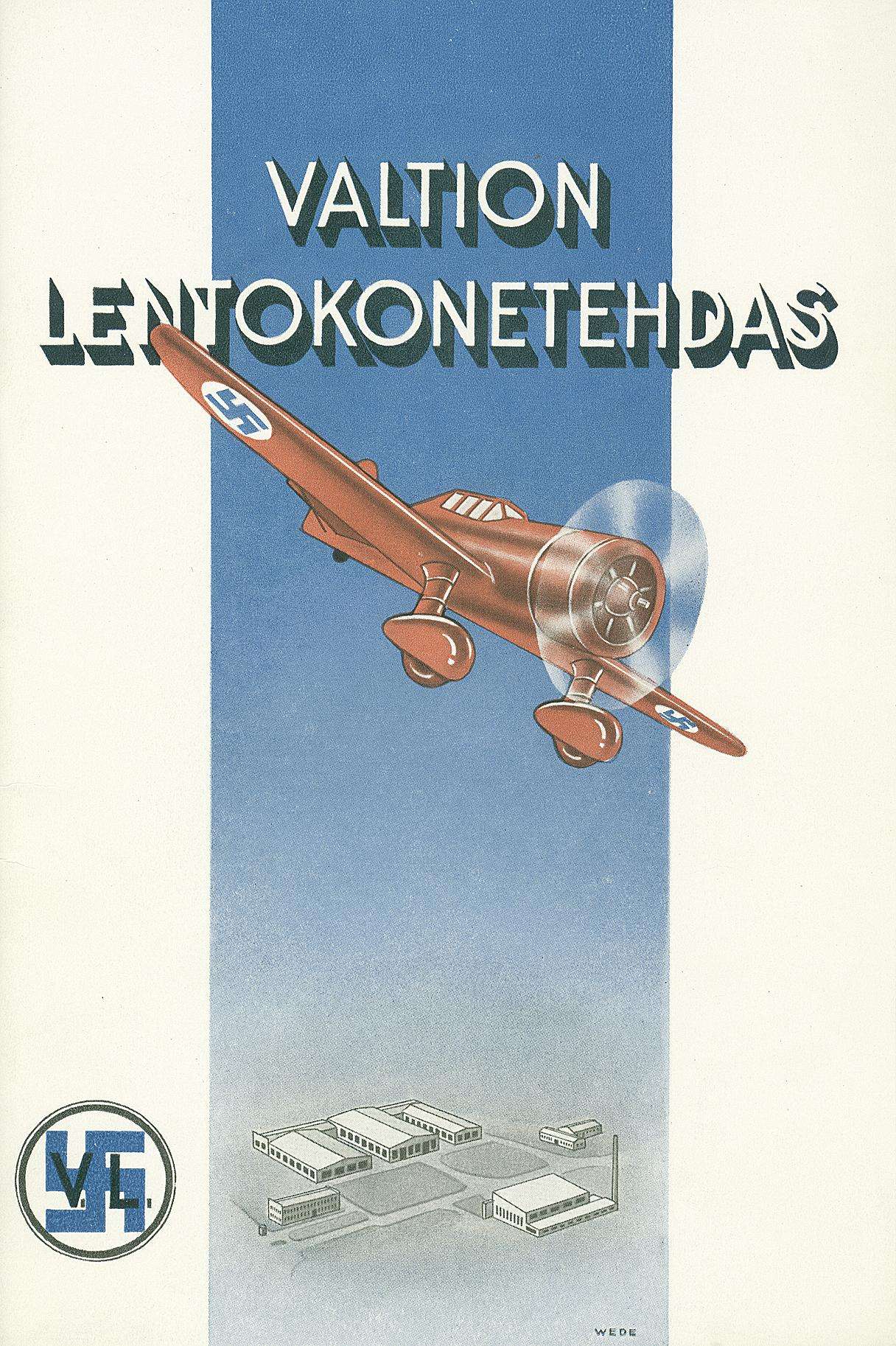
In the early 1930s a decision was made that the manufacturing facilitites needed to be located further away from the Soviet Union. From a strategic point of view, the current factory location on the Helsinki coastline was a strategically poor choice and vulnerable to attack. The Suomenlinna buildins were too small for the assembly or mass-production of larger numbers of aircraft, or for maintenance and repairs to larger numbers of aircraft. Additionally, Suomenlinna was not an airport - it as used as for float-plane assembly and manufacture, but test flights for land-planes had to be made from an airfield on the winter ice.
The location of the new factory was decided in the early 1930s amidst fierce competition among the various municipalities. The location of the new aircraft manufacturing facility needed to be further away from the Soviet border and also needed an airport – these conditions narrowed the choice down to the larger cities or towns in the west of the country. Construction of an airport would create considerable work in a global recession, creating jobs for hundreds of unemployed people (and even with Finland’s ”economic miracle” of the 1930s, the world-wide depression still had an impact). On the other hand, for the Ministry of Defence, the provision of construction employment appropriations and subsidies for the construction of the airfield meant that the costs for the new factory would be lower as the airfield and associated facilities would be constructed at no cost the the Ministry of Defence.
The City of Tampere saw the the airplane factory as a way to create jobs and an opportunity to build the Tampere Airport with government subsidies. Mannerheim objected to the City of Tampere for the reason that as an industrial town, it would almost certainly be bombed in any war. Consequently, Mannerheim pushed for the factory to be located in Vaasa factory. In 1931, the Government made a decision that the airplane factory would be located Parola. While Parola was not significantly further away from the Soviet Union than Helsinki, it admittedly would have allowed the factory buildings to be decentralized and hidden in the surrounding forests as well as enabling better anti-aircraft artillery protection. However, the Ministry of Defence supported the placement of the aircraft factory in Tampere instead of Parola.
Negotiations went on, but eventually in 1933/34 the decision was finally made and construction work on the factory at the site for Härmälä Airport outside Tampere, the biggest industrial city in Finland, began. The winning of the airplane factory for Tampere was good news for those affected by unemployment in the city as the building of the airport and the aircraft factory went on to employ hundreds of people – no bad thing as even with Finland’s rapidly growing ecomony, the depression of the 1930s was still having an impact. Work on the factory buildsings was completed and Valtion Lentokonetehdas made the move into the new buildings in 1936.
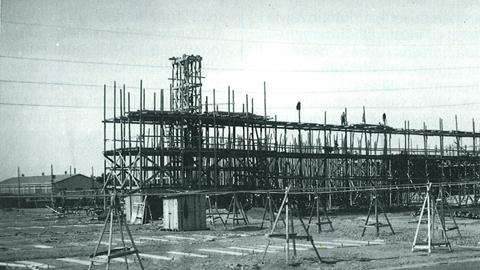
Construction of the State Aircraft Factory building at Härmälä Airport started in 1934
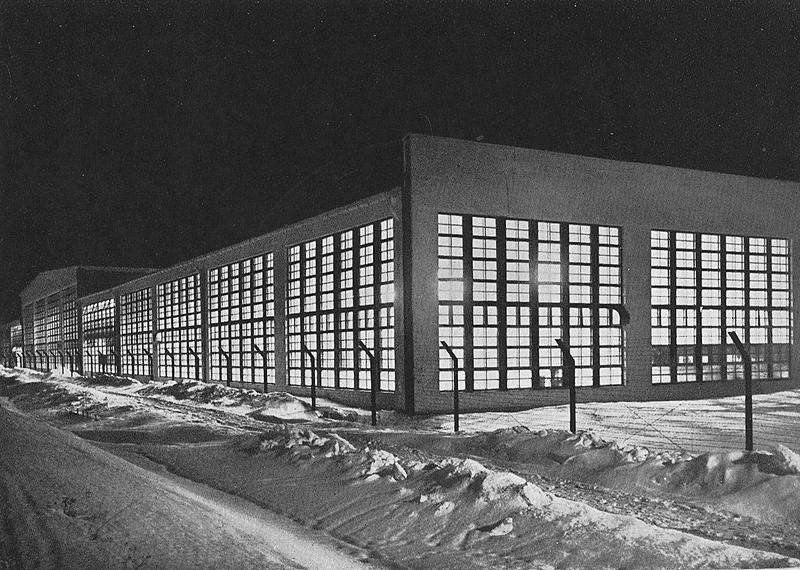
The new factory buildings were modern and well-designed – a vast improvement on the previous facilities at Suomenlinna....
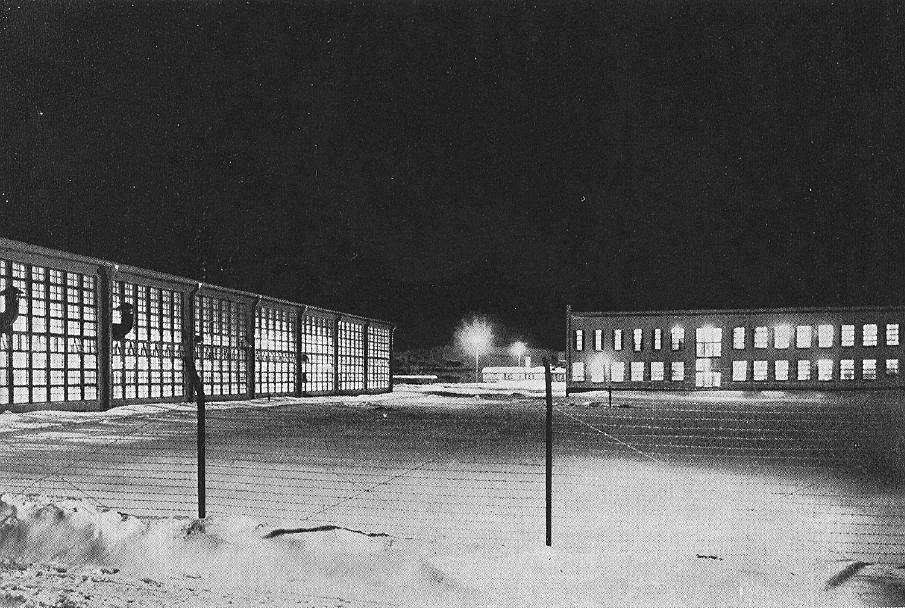
Another photo of the new factory buildings....
More on Valtion Lentokonetehdas soon…….
Another important field was Härmälä Airport - built in 1936 in Härmälä (a district of Tampere) located some 6 kilometres (3.7 mi) from the centre of Tampere. Härmälä Airport was connected to Helsinki, Vaasa, Oulu and Kemi by Aero O/Y. The first terminal building was built in 1938 as part of the program to develop Finland’s civil aviation infrastructure. While Aero Oy was based from Malmi Field outside Helsinki, Härmälä Airport became the base of Veljekset Karhumäki (the "Karhumäki Brothers") - later to be known as Karhumäki Airways and then as Kar-Air). With the acquisition of the Douglas DC3’s in 1938, Veljekset Karhumäki introduced scheduled routes Tampere-Stockholm, Tampere-Tallinn and Tampere-Copenhagen from the summer of that year, direct flights to Göteborg, Malmö and Luleå in late 1938 and Tampere-Warsaw and Tampere-Berlin in early 1939.. Tampere was an important industrial city, and with Finland’s surging economic growth, Tampere-based companies were doing business across Europe. Based in Tampere as they were, Veljekset Karhumäki capitalised on this growth, enabling business executives and salesmen to fly internationally direct from Tampere rather than via Helsinki.

The Photo shows the old Härmälä Airport Terminal and Control Tower, which was built in 1938 (OTL-1941) and used up to 1979. The old airport area has been redeveloped since the 1980's as a housing area. The old airport terminal has been renovated as an exhibition hall and for sports - Pirkkahalli. All the new street names in the subdivision somehow relate to aviation.
Following its construction in 1936, Härmälä Airport outside Tampere also became the new home of Valtion Lentokonetehdas (the State Aircraft Factory).
Ilmailuvoimien Lentokonetehdas / the Finnish Airforce Aircraft Factory)
Valtion Lentokonetehdas or VL as it was more commonly referred to, started life as IVL (Ilmailuvoimien Lentokonetehdas / the Finnish Airforce Aircraft Factory) founded in 1921. But the starting point had actually been a little earlier – in the Civil War, the Russian military airport near Turku had been captured by the Finnish White Army and in late 1918, repairs to aircraft and aircraft engines belonging to the nacent Ilmavoimat were made there. In the autumn of 1919 the repairshop was transferred to Santahamina military base (in Helsinki) and renamed "Ilmailutelakka" (literally: Aero Dockyard), and was made a unit of the “Ilmailupataljoona” (Aviation Battalion) which was then later renamed “Lentopataljoona” (Flight Battalion). This "dockyard" took care of repairing aircraft and their engines and was, as the name illustrates, a seaplane base.A separate aircraft factory got under way in 1920 amd in May of 1920 Ilmailuvoimien Lentokonetehdas (usually abbreviated to IVL or I.V.L) existed alongside the "Aviation Dockyard."
IVL had begun its production at Suomenlinna and Santahamina in Helsinki, with the Suomenlinna location being used for new aircraft construction and Santahamina being used as the repair base for aircraft and engines. The early aircraft factory did not have an airport, only the sea and sea ice could be used for take-off and landing as most of the aircraft built in Helsinki were seaplanes. The aircraft built were small and much of the final assembly was done outdoors. IVL’s first managing director was Luutnantti (Lt) Asser Järvinen who had studied aircraft building in France, which at that time was one of the best sources of aviation expertise, for a short period.

Ilmavoimien Lentokonetehdas, IVL – late 1920’s

Two photos of the exterior of the old aircraft factory building, this was the factory building of Ilmavoimien Lentokonetehdas from 1921 - 1928 and Valtion Lentokonetehdas from 1928 - 1936. Photos taken by Jarkko in Suomenlinna in 2010 (photo courtesy of www.jaegerplatoon.net).

Two photos of the exterior of the old aircraft factory building, this was the factory building of Ilmavoimien Lentokonetehdas from 1921 - 1928 and Valtion Lentokonetehdas from 1928 - 1936. Photos taken by Jarkko in Suomenlinna in 2010 (photo courtesy of www.jaegerplatoon.net).
The first aircraft to be built by IVL were the Hansa-Brandenburg aircraft mentioned in an earlier post on the Ilmavoimat – in 1921 Finland had obtained the manufacturing license for the Hansa-Brandenburg W.33. The first Finnish IVL -built Hansa made its maiden flight on November 4, 1922 and was in Finland was designated the IVL A.22 Hansa. This aircraft was the first industrially manufactured aircraft in Finland and over the following four years a total of 120 of the aircraft were manufactured. This aircraft would become the second most numerous aircraft built in Finland for the Finnish Air Force. With the purchase of the license to build the Hansa-Brandenburgs, six Germans came to work in the Suomenlinna factory, where they were supported by 12 Finnish mechanics and carpenters. G. Semeniuksen managed the factory and G. Jäderholm was the test pilot.
The IVL A.22 Hansa was a Finnish-licensed copy of the German Hansa-Brandenburg W.33, a two-seat, singe-engined low-winged monoplane flying boat. The Hansa-Brandenburg W.33 was designed in 1916 by Ernst Heinkel and entered German service in 1918. Twenty-six aircraft of this design were built in Germany, only six of them before the collapse of Germany. The W.33 proved to be an excellent aircraft, with the Hansa-Brandenburg monoplanes considerably influencing German seaplane design. Several copies appeared in 1918, such as the Friedrichshafen FF.63, the Dornier Cs-I, the Junkers J.11, and the L.F.G. Roland ME 8. After the war a version of the W.29 was also used by Denmark.

Hansa-Brandenburg. Technical information: Wooden construction, two-seat sea plane. Weight 2124 kg, Max speed 170 km/h (99mph), wingspan 15.85 m, length 11.10 m, endurance 6 hours. Weapons: navigator's twin machine gun, bombs 4x10 kg. It had good flight characteristics, but its gross weight tended to increase with age due to water soaking, which led to problems in calm weather takeoffs.
Of Note: The Finnish Broadcasting Company Yle has been transferring it's archives to the internet and one of the videos is about the Finnish Air Force Airshow in 1926. The plane in the film is 4F66 which was the 66th Hansa build in Finland. It was taken into service in 20th December 1924. To see the video click the link and press "play" below the image and next to "armeijan lentonäytös". If you have enough bandwidth you can choose bigger image by pressing "play" and then select "asetukset" from right hand top corner and then select "1 Mbps tai nopeampi" and "tallenna asetukset".
http://www.yle.fi/elavaarkisto/?s=s&g=1&ag=1&t=&a=47
A new, longer version of this film has also been published. More Hansa’s and a Breguet 14. Use this link.
http://www.yle.fi/elavaarkisto/?s=s&g=1&ag=1&a=2306
The Santahamina factory also built six Caudron G.3 Aircraft under license between 1920 and 1924 (incidentally, construction of the Caudron G.3’s started prior to the Hansa-Brandenburgs ). 12 had been bought from France, six were built in Finland by the newly established Santahaminan Ilmailutelakka and two aircraft and spares were purchased from Flyg Aktiebolaget on April 26, 1923 together with a Caudron G.4 for 100,000 Finnish markka. The Finnish-constructed aircraft had worse flying characteristics than the French machines due to a bad wing profile. The FAF used a total of 19 Caudron G.3 aircraft, which was called Tutankhamon in Finland. The Caudron G.3 was used by the FAF between 1920 and 1924.

The Caudron G.3 was a single-engined French biplane built by Caudron, widely used in World War I as a reconnaissance aircraft and trainer. It first flew in May 1914 at their Le Crotoy aerodrome. The aircraft had a short crew nacelle, with a single engine in the nose of the nacelle, and twin open tailbooms. It was of sesquiplane layout, and used wing warping for lateral control, although this was replaced by conventional ailerons fitted on the upper wing in late production aircraft. Following the outbreak of the First World War, it was ordered in large quantities. Usually, the G.3 was not equipped with any weapons, although sometimes light, small calibre machine guns and some hand-released small bombs were fitted to it. It continued in use as a trainer after ceasing combat operations until after the end of the war. One aircraft (1E.18) is currently being repaired at the Hallinportti Aviation Museum.
In 1922, the company hired an engineer, K W Berger, who had studied in London. He first designed an improved propeller for the Hansa Brandenburg and then went on to design the C.24 (1924), C.VI.25 (1925) and Haukka I (1927) - only a single prototype of each was built. In 1928 two prototypes of the Haukka II were built. None of these aircraft were mass-produced and only the Haukka could be said to be a successful design. In 1928 a prototype of Berger’s Sääski design was tested and the aircraft was then mass produced as a Trainer. Berger then designed the Kotka – a two-seat, biplane maritime patrol aircraft meant to replace the Blackburn Ripons that were in service with the Finnish Air Force. A prototype made its first flight on September 30, 1930. In 1931 the State Aircraft Factory began producing a series of five aircraft. These were used as liaison aircraft until 1944. Berger also participated in decisions of the Finnish Air Force on the purchases of foreign fighters from Czechoslovakia, Great Britain, the Netherlands, Italy and France in the late 1920s and early 1930s. Berger was dismissed from his position at VL during a company restructuring in 1933.

Kurt Volmar Berger (1896–1977) was an aviation engineer and the chief designer at the Finnish aircraft manufacturing company Valtion Lentokonetehtaat for a number of years. K. V. Berger's father, Arnold Berger, was a minister and his mother was Fanny Berger. He became a student at Helsingin Uusi Yhteiskoulu in 1916 and studied as an electrical engineer at the Helsinki University of Technology starting the same autumn, but then volunteered for service with the Jaegers. In 1918 he traveled to Libau in Germany, where he started pilot training on float-equipped aircraft. However, his pilot training was interrupted by the end of World War I and by Germany losing the war. In the end, Berger managed to receive his international civil pilot papers in 1921. In order to continue with his studies, he enrolled at the East London College in 1919 (nowadays called Queen Mary School, University of London), graduating on 5 September 1922.
He was appointed Engineer at the Finnish Air Force Headquarters at Santahamina on 1 November 1923, and later Chief Engineer in 1 March 1924. He was then sent to the Finnish Air Force Aircraft Manufacturing company (Ilmavoimien Lentokonetehdas) where he went on to design the IVL C.24, IVL Haukka I, IVL Haukka II, IVL Sääski and the IVL Kotka aircraft. Berger also participated in decisions of the Finnish Air Force on the purchases of foreign fighters from Czechoslovakia, Great Britain, Italy and France in the late 1920s and early 1930s. Berger was dismissed from his position at VL during a company restructuring in 1933. He continued to work as aircraft inspector at Lentoasema I and Flight Regiment 2. During the Soviet-Finnish Winter War of 1939–40 he supervised the assembly of the Brewster Buffalo fighters in Sweden, as well as served as Chief Engineer of Maintenance and Office Engineer at Finnish Air Force Headquarters. After WW2 he continued in business as a private entrepreneur.
The Ilmavoimat had also purchased 30 Caudron C.60s from France in 1923. A further 34 aircraft were licence built in Finland between 1927 and 1928. These were used as primary trainers until 1936, when they were retired as more modern trainers were brought into service. With a maximum speed of 93mph, a ceiling of 13,120 feet and an endurance of 5 hours, they were a typical biplane trainer of the 1920’s.

Caudron C.60 Trainer
The Siemens-Schuckert D. VI
In addition to the French fighters, it was decided to manufacture under license was the Siemens-Schuckert D. IV, a late-WW1 Fighter which had a 160 hp Siemens & Halske Sh IIIa Engine. The engines were bought from a surplus warehouse in Copenhagen and at the same time as many as 334 Siemens Schuckertin incomplete drawings were in Finland for 1923. A sample machine was also not available. An attempt to change the License Agreement to specify a newer version of the D-VI was made, but in the summer of 1923 it was advised that the two prototypes of the machine and the design drawings had already been destroyed or damaged in 1919. The attempt to secure a Manufacturing License therefore failed - and it should also be remembered that the acquisition of a German machine was a politically risky thing in the early 1920s

Siemens-Schuckert D. IV
As the license to manufacture the Siemens Schukert D. IV fighter had not eventuated, and the Gourdou Leseurre-GL-21 Fighters had only just been ordered, IVL decided to build a prototype fighter of their own in the interim. This was the Kurt-Berger designed IVL C.24, built in 1924. The IVL C.24 was the first aircraft to be completely designed and built from the ground up in Finland but only one example of the aircraft was manufactured by IVL. The aircraft made its maiden flight on April 16, 1924, piloted by Georg Jäderholm. The aircraft was a single-seater, high-wing monoplane and was designed as a fighter. However, the selected birotary engine (the Siemens & Halske Sh IIIa) was underpowered and unreliable and proved a complete failure, spelling the doom of the project. Worse, flight characteristics were poor and the visibility from the pilot's seat was also very poor. The aircraft was in Finnish Air Force use for a short time as a prototype only.

IVL C.24 at Suomenlinna in the Spring of 1924.
A design flaw with the Siemens & Halske Sh IIIa Engine was discovered and the problem was fixed. Berger started the design for a new prototype - the IVL C.VI.25 - a further development of the IVL C.24 on the autumn of 1924. Designed by Berger as a fighter, the aircraft made its maiden flight on June 11, 1925 and was wrecked after a forced landing due to engine trouble on December 17, 1925. Externally it resembled the C.24 closely, but there were large differences in the structure. The C.25 had a thicker and stiffer wing, the airframe was longer and more delicate, better ground clearance and better visibility and the landing gear was new. In testing, the C.25 had better flight characteristics than the Gourdou Fighters, but the aircraft was still under-powered like its predecessor, due to the choice of the same cheap but useless and still unreliable engine as used in its predecessor, power control was poor the test engine failed the 50-hour endurance test dozens of times. The conclusion was that Siemens-Halske Sh IIIa Engine could not power a fighter and it was not considered worthwhile to carry out further development.

The IVL C.VI.25
In 1926, the Ilmavoimat ordered six Koolhoven F.K.31 two-seat reconnaissance aircraft from the Dutch firm of Koolhoven practically without evaluation and also purchased a manufacturing license. Six Koolhoven’s were built by Ilmailuvoimien Lentokonetehdas. Unfortunately, on taking delivery and testing the aircraft, they were immediately found to be inadequate in all respects and had a weak airframe –simply put, they were dangerous to fly. The Finnish-built aircraft even turned out to be inferior to the Dutch-built examples. Thanks to the exceptionally small number of hours flown and prudent utilization no lives were lost, and by 1932 all 12 Koolhovens had been retired from service.

Koolhoven F.K. 31 in summer 1930 at the factory at Suomenlinna
In 1927 Ilmailuvoimien Lentokonetehdas built a prototype of the K.1 Kurki (“Crane”) – designed by Asser Järvinen, this was intended as a four-seated, high-wing trainer aircraft. The prototype was manufactured at the IVL plant at Suomenlinna and made its maiden flight on March 30, 1927. The aircraft was both over weight and too front-heavy. It also had poor flight characteristics. The Finnish Air Force only flew the aircraft 13 hours. No development potential was seen for the overweight "Järvinen's crate", and work on the project was terminated. Only one aircraft was manufactured (the Päijät-Häme Aviation Museum has stored the only Kurki manufactured).

I.V.L K.1 Kurki

The remains of the only K.1 Kurki in existence - Päijät-Häme Aviation Museum
Overall, aircraft built under the auspices of Ilmailuvoimien Lentokonetehdas included:
Caudron G.3 – 6 built under license
IVL A.22 Hansa-Brandenburg W.33 – 120 built under license
IVL C.24 (protype only)
IVL C.25 (prototype only)
Caudron C.60 – 34 built under license
IVL D.26 Haukka I (prototype only)
IVL K1. Kurki (prototype only)
Valtion Lentokonetehdas or VL as it was more commonly referred to, was founded on 23 February 1928 from I.V.L (the Finnish Airforce Aircraft Factory), at which time the company was transferred from the Ilmavoimat to the Ministry of Defence.
Valtion Lentokonetehdas (the State Aircraft Factory)
Valtion Lentokonetehdas or VL as it was more commonly referred to, was founded on 23 February 1928 from I.V.L (the Finnish Airforce Aircraft Factory), at which time the company was transferred from the Ilmavoimat to the Ministry of Defence. To start with, VL operated from the same locations as IVL.

In the early 1930s a decision was made that the manufacturing facilitites needed to be located further away from the Soviet Union. From a strategic point of view, the current factory location on the Helsinki coastline was a strategically poor choice and vulnerable to attack. The Suomenlinna buildins were too small for the assembly or mass-production of larger numbers of aircraft, or for maintenance and repairs to larger numbers of aircraft. Additionally, Suomenlinna was not an airport - it as used as for float-plane assembly and manufacture, but test flights for land-planes had to be made from an airfield on the winter ice.
The location of the new factory was decided in the early 1930s amidst fierce competition among the various municipalities. The location of the new aircraft manufacturing facility needed to be further away from the Soviet border and also needed an airport – these conditions narrowed the choice down to the larger cities or towns in the west of the country. Construction of an airport would create considerable work in a global recession, creating jobs for hundreds of unemployed people (and even with Finland’s ”economic miracle” of the 1930s, the world-wide depression still had an impact). On the other hand, for the Ministry of Defence, the provision of construction employment appropriations and subsidies for the construction of the airfield meant that the costs for the new factory would be lower as the airfield and associated facilities would be constructed at no cost the the Ministry of Defence.
The City of Tampere saw the the airplane factory as a way to create jobs and an opportunity to build the Tampere Airport with government subsidies. Mannerheim objected to the City of Tampere for the reason that as an industrial town, it would almost certainly be bombed in any war. Consequently, Mannerheim pushed for the factory to be located in Vaasa factory. In 1931, the Government made a decision that the airplane factory would be located Parola. While Parola was not significantly further away from the Soviet Union than Helsinki, it admittedly would have allowed the factory buildings to be decentralized and hidden in the surrounding forests as well as enabling better anti-aircraft artillery protection. However, the Ministry of Defence supported the placement of the aircraft factory in Tampere instead of Parola.
Negotiations went on, but eventually in 1933/34 the decision was finally made and construction work on the factory at the site for Härmälä Airport outside Tampere, the biggest industrial city in Finland, began. The winning of the airplane factory for Tampere was good news for those affected by unemployment in the city as the building of the airport and the aircraft factory went on to employ hundreds of people – no bad thing as even with Finland’s rapidly growing ecomony, the depression of the 1930s was still having an impact. Work on the factory buildsings was completed and Valtion Lentokonetehdas made the move into the new buildings in 1936.

Construction of the State Aircraft Factory building at Härmälä Airport started in 1934

The new factory buildings were modern and well-designed – a vast improvement on the previous facilities at Suomenlinna....

Another photo of the new factory buildings....
More on Valtion Lentokonetehdas soon…….
ex Ngāti Tumatauenga ("Tribe of the Maori War God") aka the New Zealand Army
Aircraft Engine Manufacturing in Finland
Once more getting a little ahead of myself here, but also looking for suggestions and comments as I winged this one a bit. Consider it a draft and if there's enough feedback and comments for me to work with, I'll re-write it and repost later.
Aircraft Engine Manufacturing in Finland
Prior to the mid-1930’s, all aircraft engines used in Finland were imported, generally with the aircraft that were purchased. One of the many strategic recommendations to come out of the 1931 Defence Review was that in addition to building up Aircraft Manufacturing capability, Finland needed to develop an Aircraft Engine construction facility so as to enable a modicum of self-sufficiency. Developing an engine-design capability was specifically ruled out – Finland did not have the necessary knowledge, infrastructure, financial capital or volume-demand to justify such a proposition. What was recommended was the building up of construction capability to manufacture aircraft engines under license – and these engines would power not just aircraft but also the Fast Torpedo Boats that were also recommended and which were moving ahead as a seperate Defence project under the aegis of the Merivoimat.
In 1933 the Government began to negotiate an agreement between Ab Tampella Oy and the British firm Bristol Aeroplance Company for a manufacturing license for Bristol aircraft engines. The background in part to this was the balance of trade between Finland and Great Britain as well as a very basic requirement for the Government to steer the defence procurement budget towards selected countries of origin given restrictions and limitations on the available foreign currencies. Although representatives of the Ilmavoimat and Defense Council President General Mannerheim objected to the license agreement, Defense Minister Rudolp Walden and Tampella pressured the Government into entering into the license agreement with Bristol – and this was completed and signed in early 1934 and the State Aircraft Factory was set up as a joint venture, with Tampella taking a leading role in setting up the plant. In 1937 a further licensing agreement was concluded with Rolls Royce, to build the Rolls Royce Merlin engine under license. There were a number of difficulties in closing this deal, not least a British reluctance to license the manufacture of the engine but a combination of factors lead to the successful closing of negotiations – not least of which were the increasing exports of Nickel from Petsamo to the UK and the large trade deficit in Finland’s favor due to the rapid growth of Finnish exports to the UK through the 1930’s.
The second aircraft-engine facility set up in Finland was a joint-venture between Tampella and Hispano-Suiza, based on an agreement negotiated over 1935. The Tampella-Hispano-Suiza Aircraft Engine Company was established in 1936 to manufacture the Hispano-Suiza 12Y Aircraft Engine with firm orders guaranteed by the Ministry of Defence and with state-guaranteed loans – partially because the Sate Aircraft Engine Factory was having difficulty building enough Bristol Mercury and Rolls Royce Merlin engines (under license) to meet demand. Benefitting from Hispano-Suiza advice and experts, the new factory building was rapidly constructed adjacent to the almost-completed Valtion Lentokonetehdas plant at Härmälä Airport outside Tampere whilst orders for the necessary machinery were placed. The plant was completed in early 1937, personnel were trained by Hispano-Suiza engineers and the first Hispano-Suiza 12Y engine was completed shortly thereafter.
Developed from the earlier, and somewhat smaller, 12X, the Hispano-Suiza 12Y became the primary 1,000 hp (750 kW) class engine and was used in a number of famous aircraft, including the Morane-Saulnier M.S.406 and Dewoitine D.520. The design was also widely used in other countries. The engine was produced in Russia as the Klimov M-100 and formed the basis for licensed production of a number of designs, most notably the Soviet Klimov VK-105 series. The Finnish plant first manufactured the 12Y-31, with the lower 5.8:1 compression ratio and producing 850 hp (630 kW). Subsequently, in late 1938, the Finnish plant switched to the 12Y-45, which used the S-39-H3 supercharger co-designed by André Planiol and Polish engineer Joseph Szydlowski and incorporated some design changes to cope with the colder winter weather of Finland.
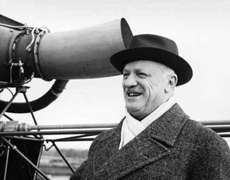
Polish engineer Joseph Szydlowski
The Szydlowski-Planiol device was larger, but much more efficient than the indifferent Hispano-Suiza models. This allowed the compression ratio to be raised to that of the -21's 7:1, boosting power to 900 hp (670 kW), although requiring the use of 100 octane fuel. Combined with the fully-adjustable Ratier propeller, this substantially increased performance. Another improvement in supercharging led to the 12Y-49, whose performance improved from 850 hp (630 kW) at sea level to 920 hp (690 kW) at just over 10,000 ft (3,000 m). This improvement in power with altitude was a common feature of many early engines, the result of the supercharger "robbing" power at low altitudes to provide boost that then had to be dumped to avoid overboosting the engine.
The final major version was the 1,085 hp (809 kW) 12Y-51, the Finnish plant switched to in late 1940, after the Winter War had ended. The -51 was the first version that came close to the performance limits of the engine. It was perhaps coincidental that the USSR version of the HS12Y was one of the major Soviet fighter engines of WW2. By a stroke of good fortune for Finland, the Polish engineer Joseph Szydlowski (who worked for Hispano-Suiza as one of their leading designers) and who was instrumental in some of the major 12Y improvements, was in Finland assisting with changes to the Finnish manufacturing plant when France fell to the Germans. Szydlowski remained in Finland for the duration of both the Winter War and the remainder of WW2 and was a key figure in a number of important military-related engineering projects for Finland, as we will see. (Once the war was over he returned to France where he developed small turbine engines for helicopters – incidentally, this was in no small part based on his experiences in Finland where he played a large part in the ongoing improvements to the capabilities of the engines fitted to the Ilamvoimats Dragonfly and Flettner helicopters - his post-war company, Turbomeca, went on to become a major supplier of helicopter turboshaft engines, providing 30% of the non-USA market according to the company).
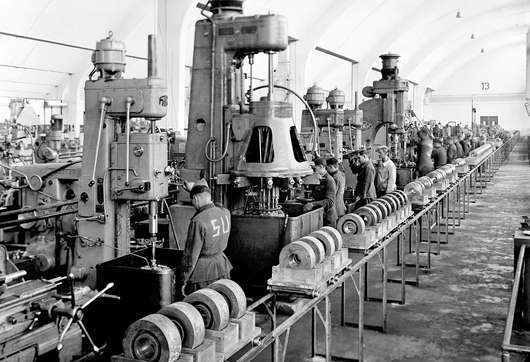
Aircraft Engine – component manufacturing, State Aircraft Factory, Tampere
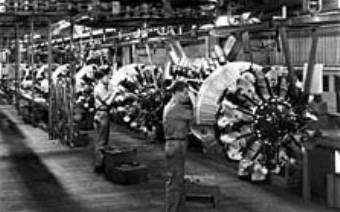
Aircraft Engine assembly – State Aircraft Factory, Tampere
An Article from Helsingin Sanomat – 12 February 1939
Through the night the long windows of the Tampella-Hispano-Suiza aircraft engine plant glow with an eerie, blue-green light. Through the streets of the workers houses surrounding the plant, freight trucks lumber along the road to and from the Railway Yards. The air of the whole neighborhood palpitates with the muffled thunder of aircraft engines on test stands in the factory buildings. And every six seconds the white finger of the airport beacon flicks over the fleshening skeleton of a huge new factory extension growing from the main plant. Last week the Manager of the Joint Venture company could have been expected to look twice as he looked over the production report of his engine factory. Ab Tampella-Hispano-Suiza Aircraft Engine Oy has hit the high point of its production history, with above 35 engines a month completed in January, more than double its average monthly production for 1938. This production will be doubled again when the new plant reaches its capacity next spring following completion of the new factory extension.
Not the least remarkable part of this increase in production is the new plant. It will double Ab Tampella-Hispano-Suiza Aircraft Engine Oy’s floor space, and the building will cost the company not a markka. To speed up deliveries on orders for warplane engines, the Government has already advanced the money needed to erect the new factory. The cost will be defrayed by Ab Tampella-Hispano-Suiza Aircraft Engine Oy gradually by a small charge on each engine delivered until the advance is used up. The new factory will belong to the Joint Venture with no strings attached. To Finland this is a necessary extravagance as our armed forces need the engines and Tampella does not have the capital to construct on its own all the additional facilities that are being asked for as we equip our Defence Forces to defend our country if necessary.
Just as extraordinary is what is now going on within Ab Tampella-Hispano-Suiza Aircraft Engine Oy’s existing plant. Workmen and women are being hired at the rate of 50 a day. Soon there will be two men (or women) at every job—one working, one watching — throughout the 2,000-job plant. This also is a necessary extravagance. For one man at each job is a learner. When the new plant is opened, a trained staff will be ready to march in and begin production at full speed. Before the snow is off the ground, Ab Tampella-Hispano-Suiza Aircraft Engine Oy expects to have its factory-on-a-silver-platter turning out as many high-powered motors as are now being shipped out from the loading room of its old plant to the adjacent Valtion Lentokonetehdas plant, and sees no trouble ahead in filling the requirements of the Ilmavoimat or the Merivoimat, plus still other orders from our neighbours in Sweden.
In Tampere, at the works of the other big aircraft engine builder, the State Aircraft Factory, another plant extension is springing up under the watering of another Government grant. The State Aircraft Factory expansion is being financed to meet a large Ilmavoimat order for Bristol Mercury and Rolls Royce Merlin engines, which will nearly double its capacity to about 50 aircraft engines a month. And some of this production of high-powered aircraft engines will be going, not into aircraft but into the new Merivoimat Torpedo Boats that are rapidly coming off the slips. By the middle of the summer the production of the two plants in military aircraft engines may well hit a total of close to 150 a month, ending fears that the General Staff entertained that aircraft engine production might become a bottleneck to Finnish defensive rearmament.

As Finnish military-industrial manufacturing capacity grew rapidly over 1938 and 1939, more and more women were hired into manufacturing jobs. This was partially the result of a mandate from the Minister of Defence, Rudolph Walden, that 50% of the manufactiring positions in critical defence industried be filled by women so that in the event that war broke out, industry would not be crippled by emergency call-ups of all military-aged men.
The establishment of Suomen Hispano-Suiza Oy
The steady growth of the Ilmavoimat, and the increase in the number of aircraft being built in Finland led to a demand for aircraft guns. With the Tampella-Hispano-Suiza aircraft engine joint venture agreed in 1935, when thoughts turned in the direction of aircraft armament, it seemed logical to turn to a company with both a presence in Finland and established and proven experience in the field of aircraft armaments. Hispano-Suiza had started as a Spanish luxury automotive and engineering firm, best known for their cars, their engines (including world famous aviation engines) and their weapons designs in the pre-World War II period. In 1923 the French subsidiary had become an autonomous partnership (though not totally independent from the parent company) and it was this French subsidiary that in turn had established the aircraft engine joint venture in Finland.
In an early discussion on the subject, Hispano-Suiza indicated that if the Ilmavoimat contracted to buy 400 cannon per year, they would establish a factory at their own cost to produce them in Finland. Progress was rapid, the Ilmavoimat enthusiastically supported the proposal and so did Tampella after a further joint venture was proposed. Suomen Hispano-Suiza Oy was established in 1936 as a second joint venture with Tampella, with a firm order placed by the Ilmavoimat to buy Hispano-Suiza Cannon for fighter aircraft. Construction of the factory began almost immediately in Spring 1936, with the first Hispano-Suiza HS.404 cannon rolling of the production line in July 1937. Thereafter this cannon became the standard armament for all Finnish fighter aircraft wherever possible (and was often retrofitted into earlier machinegun-equipped fighters that the Ilmavoimat had purchased).
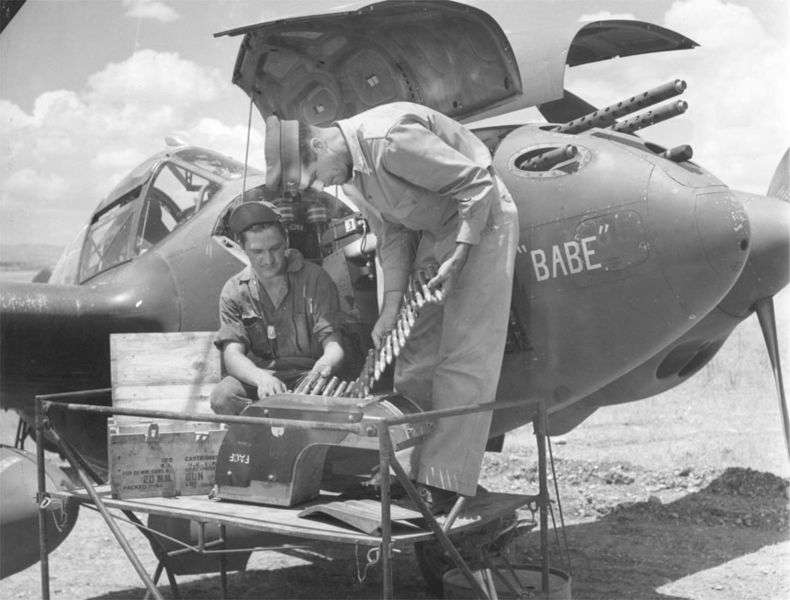
Ilmavoimat Pilot Juha Makkinen examining Hispano-Suiza cannon ammunition for his Fokker G1 Fighter “Babe” (the Jazz decade had its influences in Finland too): Eastern Karelia, Summer of 1940.
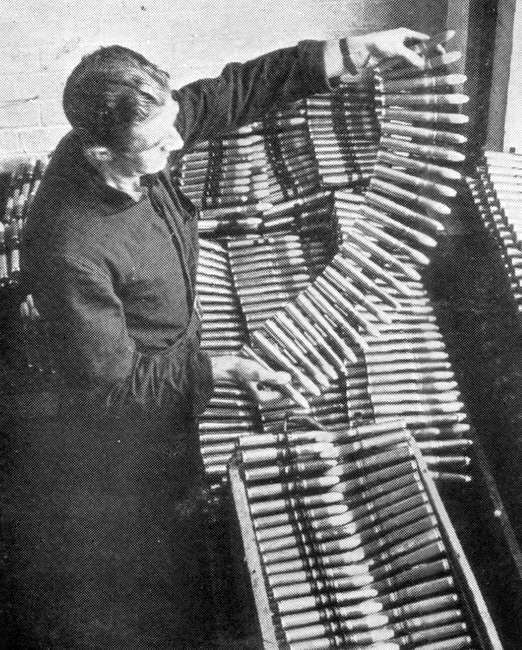
HS.404 Cannon Shells being inspected before being loaded into fighter aircraft.
The new HS.404 auto-cannon was not only considered the best aircraft cannon of its kind, but on evaluation also turned out to be suited to the anti-aircraft role. While the Oerlikon auto-cannon that the Navy had contracted for was rather heavy (the movement of the heavy bolt made it best suited in static and maritime anti-aircraft defence), the HS.404 turned out to be well suited to mounting on vehicles, and this, the Suomen Maavoimat promptly proceeded to do in the late 1930’s. Factory production was ramped up urgently to fulfill Maavoimat orders, which far exceeded orders from the Ilmavoimat in volume.
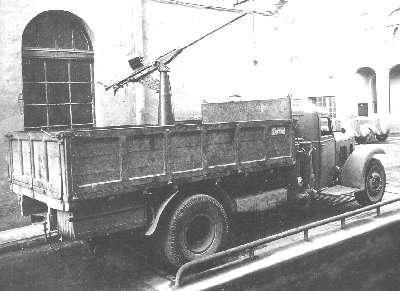
Truck mounted HS.404: Late 1939, a Sisu Construction Truck mobilized for Maavoimat transport use and fitted with an HS.404 cannon as an improvised anti-aircraft defence.
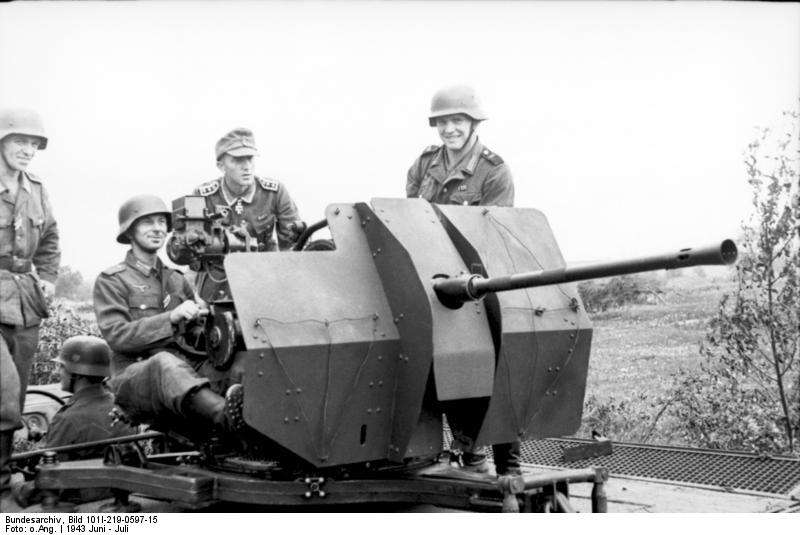
Maavoimat HS.404 AA Gun modeled on the German FlaK 30 design (in fact, virtually identical). This was the light AA Gun that equipped almost all Maavoimat Infantry Battalions by the outbreak of the Winter War. Mobile, relatively easy to transport and with an adequate rate of fire, at the time of the Winter War it was an effective AA Gun.
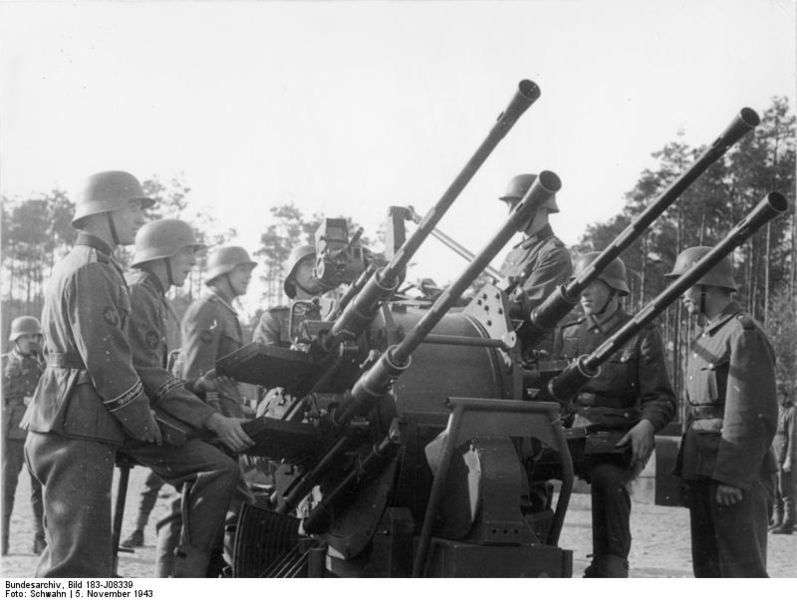
The single-barrelled 20mm AA Gun, while reasonably effective in the Winter War, was rapidly becoming less so given the ever-increasing speeds of low-altitude fighter-bombers and attack aircraft. In mid-1941, VKT came up with the quad-barreled 20mm AA Gun, this time closely modeled on the German 2cm FlaK38.
VKT had surreptitiously sourced a single 2cm FlaK38 from Germany in mid-1940 through the auspices of Josef Veltjens, a Germans arms dealer who had assisted Finland during the Winter War and, as he had for the earlier 20mm AA Gun, Antti Lahti reverse-engineered the design and at the same time improved it somewhat. The weapon consisted of quad-mounted 20mm HS.404 guns with collapsing seats, folding handles, and ammunition racks. The mount had a triangular base with a jack at each leg for leveling the gun. The tracker traversed and elevated the mount manually using two handwheels. The gun was fired by a set of two footpedals—each of which fired two diametrically opposite Flak 38s—and could be operated either automatically or semi-automatically.
Each of the four mounted guns fired from a 20-round magazine at a maximum combined rate of fire of 1,400 rounds per minute (reduced to 800 rounds per minute for combat use). The guns could be fired in pairs (diagonally opposite) or simultaneously, in either semi-automatic or fully automatic mode. Its effective vertical range was 2200 meters. It was also used just as effectively against ground targets as it was against low-flying aircraft. The gun was normally transported on a trailer, and could be towed behind a variety of trucks. It was also mounted onto tank bodies to produce a mobile anti-aircraft vehicle. In Merivoimat use, it was fitted to destroyers, corvettes and torpedo boats to provide short-range anti-aircraft defense, and was also employed in fixed installations around ports, harbors and other strategic naval targets.
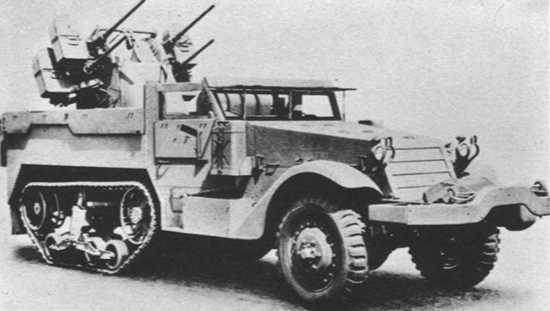
Later in World War 2, as American Lend-Lease equipment began to arrive in large quantities, augmenting Finnish-manufactured equipment, Finnish-manufactured HS.404 cannon were fitted on quad mounts on American-supplied half-tracks in an anti-aircraft role.
In 1941, after the Peace Treaty with the USSR had been signed and the Finnish Army’s combat losses (such as they were) had been replaced, Finland began exporting HS.404’s to the UK via the Arctic sea route as well as to Sweden and to the Norwegian Armed Forces (while Norway was once more neutral, her politicians no longer took their neutrality as a guarantee that they would not be attacked and Norway’s defence spending reflected this). At this stage, the British were concerned that their production for their own Armed Forces was inadequate and the US supplied versions were proving unreliable. The Finnish manufactured versions proved to be both high in quality and extremely reliable, Britain bought as many as Finland cared to sell – a market that turned out to be lucrative for the Finns through the remainder of the Second World War.
Aircraft Engine Manufacturing in Finland
Prior to the mid-1930’s, all aircraft engines used in Finland were imported, generally with the aircraft that were purchased. One of the many strategic recommendations to come out of the 1931 Defence Review was that in addition to building up Aircraft Manufacturing capability, Finland needed to develop an Aircraft Engine construction facility so as to enable a modicum of self-sufficiency. Developing an engine-design capability was specifically ruled out – Finland did not have the necessary knowledge, infrastructure, financial capital or volume-demand to justify such a proposition. What was recommended was the building up of construction capability to manufacture aircraft engines under license – and these engines would power not just aircraft but also the Fast Torpedo Boats that were also recommended and which were moving ahead as a seperate Defence project under the aegis of the Merivoimat.
In 1933 the Government began to negotiate an agreement between Ab Tampella Oy and the British firm Bristol Aeroplance Company for a manufacturing license for Bristol aircraft engines. The background in part to this was the balance of trade between Finland and Great Britain as well as a very basic requirement for the Government to steer the defence procurement budget towards selected countries of origin given restrictions and limitations on the available foreign currencies. Although representatives of the Ilmavoimat and Defense Council President General Mannerheim objected to the license agreement, Defense Minister Rudolp Walden and Tampella pressured the Government into entering into the license agreement with Bristol – and this was completed and signed in early 1934 and the State Aircraft Factory was set up as a joint venture, with Tampella taking a leading role in setting up the plant. In 1937 a further licensing agreement was concluded with Rolls Royce, to build the Rolls Royce Merlin engine under license. There were a number of difficulties in closing this deal, not least a British reluctance to license the manufacture of the engine but a combination of factors lead to the successful closing of negotiations – not least of which were the increasing exports of Nickel from Petsamo to the UK and the large trade deficit in Finland’s favor due to the rapid growth of Finnish exports to the UK through the 1930’s.
The second aircraft-engine facility set up in Finland was a joint-venture between Tampella and Hispano-Suiza, based on an agreement negotiated over 1935. The Tampella-Hispano-Suiza Aircraft Engine Company was established in 1936 to manufacture the Hispano-Suiza 12Y Aircraft Engine with firm orders guaranteed by the Ministry of Defence and with state-guaranteed loans – partially because the Sate Aircraft Engine Factory was having difficulty building enough Bristol Mercury and Rolls Royce Merlin engines (under license) to meet demand. Benefitting from Hispano-Suiza advice and experts, the new factory building was rapidly constructed adjacent to the almost-completed Valtion Lentokonetehdas plant at Härmälä Airport outside Tampere whilst orders for the necessary machinery were placed. The plant was completed in early 1937, personnel were trained by Hispano-Suiza engineers and the first Hispano-Suiza 12Y engine was completed shortly thereafter.
Developed from the earlier, and somewhat smaller, 12X, the Hispano-Suiza 12Y became the primary 1,000 hp (750 kW) class engine and was used in a number of famous aircraft, including the Morane-Saulnier M.S.406 and Dewoitine D.520. The design was also widely used in other countries. The engine was produced in Russia as the Klimov M-100 and formed the basis for licensed production of a number of designs, most notably the Soviet Klimov VK-105 series. The Finnish plant first manufactured the 12Y-31, with the lower 5.8:1 compression ratio and producing 850 hp (630 kW). Subsequently, in late 1938, the Finnish plant switched to the 12Y-45, which used the S-39-H3 supercharger co-designed by André Planiol and Polish engineer Joseph Szydlowski and incorporated some design changes to cope with the colder winter weather of Finland.

Polish engineer Joseph Szydlowski
The Szydlowski-Planiol device was larger, but much more efficient than the indifferent Hispano-Suiza models. This allowed the compression ratio to be raised to that of the -21's 7:1, boosting power to 900 hp (670 kW), although requiring the use of 100 octane fuel. Combined with the fully-adjustable Ratier propeller, this substantially increased performance. Another improvement in supercharging led to the 12Y-49, whose performance improved from 850 hp (630 kW) at sea level to 920 hp (690 kW) at just over 10,000 ft (3,000 m). This improvement in power with altitude was a common feature of many early engines, the result of the supercharger "robbing" power at low altitudes to provide boost that then had to be dumped to avoid overboosting the engine.
The final major version was the 1,085 hp (809 kW) 12Y-51, the Finnish plant switched to in late 1940, after the Winter War had ended. The -51 was the first version that came close to the performance limits of the engine. It was perhaps coincidental that the USSR version of the HS12Y was one of the major Soviet fighter engines of WW2. By a stroke of good fortune for Finland, the Polish engineer Joseph Szydlowski (who worked for Hispano-Suiza as one of their leading designers) and who was instrumental in some of the major 12Y improvements, was in Finland assisting with changes to the Finnish manufacturing plant when France fell to the Germans. Szydlowski remained in Finland for the duration of both the Winter War and the remainder of WW2 and was a key figure in a number of important military-related engineering projects for Finland, as we will see. (Once the war was over he returned to France where he developed small turbine engines for helicopters – incidentally, this was in no small part based on his experiences in Finland where he played a large part in the ongoing improvements to the capabilities of the engines fitted to the Ilamvoimats Dragonfly and Flettner helicopters - his post-war company, Turbomeca, went on to become a major supplier of helicopter turboshaft engines, providing 30% of the non-USA market according to the company).

Aircraft Engine – component manufacturing, State Aircraft Factory, Tampere

Aircraft Engine assembly – State Aircraft Factory, Tampere
An Article from Helsingin Sanomat – 12 February 1939
Through the night the long windows of the Tampella-Hispano-Suiza aircraft engine plant glow with an eerie, blue-green light. Through the streets of the workers houses surrounding the plant, freight trucks lumber along the road to and from the Railway Yards. The air of the whole neighborhood palpitates with the muffled thunder of aircraft engines on test stands in the factory buildings. And every six seconds the white finger of the airport beacon flicks over the fleshening skeleton of a huge new factory extension growing from the main plant. Last week the Manager of the Joint Venture company could have been expected to look twice as he looked over the production report of his engine factory. Ab Tampella-Hispano-Suiza Aircraft Engine Oy has hit the high point of its production history, with above 35 engines a month completed in January, more than double its average monthly production for 1938. This production will be doubled again when the new plant reaches its capacity next spring following completion of the new factory extension.
Not the least remarkable part of this increase in production is the new plant. It will double Ab Tampella-Hispano-Suiza Aircraft Engine Oy’s floor space, and the building will cost the company not a markka. To speed up deliveries on orders for warplane engines, the Government has already advanced the money needed to erect the new factory. The cost will be defrayed by Ab Tampella-Hispano-Suiza Aircraft Engine Oy gradually by a small charge on each engine delivered until the advance is used up. The new factory will belong to the Joint Venture with no strings attached. To Finland this is a necessary extravagance as our armed forces need the engines and Tampella does not have the capital to construct on its own all the additional facilities that are being asked for as we equip our Defence Forces to defend our country if necessary.
Just as extraordinary is what is now going on within Ab Tampella-Hispano-Suiza Aircraft Engine Oy’s existing plant. Workmen and women are being hired at the rate of 50 a day. Soon there will be two men (or women) at every job—one working, one watching — throughout the 2,000-job plant. This also is a necessary extravagance. For one man at each job is a learner. When the new plant is opened, a trained staff will be ready to march in and begin production at full speed. Before the snow is off the ground, Ab Tampella-Hispano-Suiza Aircraft Engine Oy expects to have its factory-on-a-silver-platter turning out as many high-powered motors as are now being shipped out from the loading room of its old plant to the adjacent Valtion Lentokonetehdas plant, and sees no trouble ahead in filling the requirements of the Ilmavoimat or the Merivoimat, plus still other orders from our neighbours in Sweden.
In Tampere, at the works of the other big aircraft engine builder, the State Aircraft Factory, another plant extension is springing up under the watering of another Government grant. The State Aircraft Factory expansion is being financed to meet a large Ilmavoimat order for Bristol Mercury and Rolls Royce Merlin engines, which will nearly double its capacity to about 50 aircraft engines a month. And some of this production of high-powered aircraft engines will be going, not into aircraft but into the new Merivoimat Torpedo Boats that are rapidly coming off the slips. By the middle of the summer the production of the two plants in military aircraft engines may well hit a total of close to 150 a month, ending fears that the General Staff entertained that aircraft engine production might become a bottleneck to Finnish defensive rearmament.

As Finnish military-industrial manufacturing capacity grew rapidly over 1938 and 1939, more and more women were hired into manufacturing jobs. This was partially the result of a mandate from the Minister of Defence, Rudolph Walden, that 50% of the manufactiring positions in critical defence industried be filled by women so that in the event that war broke out, industry would not be crippled by emergency call-ups of all military-aged men.
The establishment of Suomen Hispano-Suiza Oy
The steady growth of the Ilmavoimat, and the increase in the number of aircraft being built in Finland led to a demand for aircraft guns. With the Tampella-Hispano-Suiza aircraft engine joint venture agreed in 1935, when thoughts turned in the direction of aircraft armament, it seemed logical to turn to a company with both a presence in Finland and established and proven experience in the field of aircraft armaments. Hispano-Suiza had started as a Spanish luxury automotive and engineering firm, best known for their cars, their engines (including world famous aviation engines) and their weapons designs in the pre-World War II period. In 1923 the French subsidiary had become an autonomous partnership (though not totally independent from the parent company) and it was this French subsidiary that in turn had established the aircraft engine joint venture in Finland.
In an early discussion on the subject, Hispano-Suiza indicated that if the Ilmavoimat contracted to buy 400 cannon per year, they would establish a factory at their own cost to produce them in Finland. Progress was rapid, the Ilmavoimat enthusiastically supported the proposal and so did Tampella after a further joint venture was proposed. Suomen Hispano-Suiza Oy was established in 1936 as a second joint venture with Tampella, with a firm order placed by the Ilmavoimat to buy Hispano-Suiza Cannon for fighter aircraft. Construction of the factory began almost immediately in Spring 1936, with the first Hispano-Suiza HS.404 cannon rolling of the production line in July 1937. Thereafter this cannon became the standard armament for all Finnish fighter aircraft wherever possible (and was often retrofitted into earlier machinegun-equipped fighters that the Ilmavoimat had purchased).

Ilmavoimat Pilot Juha Makkinen examining Hispano-Suiza cannon ammunition for his Fokker G1 Fighter “Babe” (the Jazz decade had its influences in Finland too): Eastern Karelia, Summer of 1940.

HS.404 Cannon Shells being inspected before being loaded into fighter aircraft.
The new HS.404 auto-cannon was not only considered the best aircraft cannon of its kind, but on evaluation also turned out to be suited to the anti-aircraft role. While the Oerlikon auto-cannon that the Navy had contracted for was rather heavy (the movement of the heavy bolt made it best suited in static and maritime anti-aircraft defence), the HS.404 turned out to be well suited to mounting on vehicles, and this, the Suomen Maavoimat promptly proceeded to do in the late 1930’s. Factory production was ramped up urgently to fulfill Maavoimat orders, which far exceeded orders from the Ilmavoimat in volume.

Truck mounted HS.404: Late 1939, a Sisu Construction Truck mobilized for Maavoimat transport use and fitted with an HS.404 cannon as an improvised anti-aircraft defence.

Maavoimat HS.404 AA Gun modeled on the German FlaK 30 design (in fact, virtually identical). This was the light AA Gun that equipped almost all Maavoimat Infantry Battalions by the outbreak of the Winter War. Mobile, relatively easy to transport and with an adequate rate of fire, at the time of the Winter War it was an effective AA Gun.

The single-barrelled 20mm AA Gun, while reasonably effective in the Winter War, was rapidly becoming less so given the ever-increasing speeds of low-altitude fighter-bombers and attack aircraft. In mid-1941, VKT came up with the quad-barreled 20mm AA Gun, this time closely modeled on the German 2cm FlaK38.
VKT had surreptitiously sourced a single 2cm FlaK38 from Germany in mid-1940 through the auspices of Josef Veltjens, a Germans arms dealer who had assisted Finland during the Winter War and, as he had for the earlier 20mm AA Gun, Antti Lahti reverse-engineered the design and at the same time improved it somewhat. The weapon consisted of quad-mounted 20mm HS.404 guns with collapsing seats, folding handles, and ammunition racks. The mount had a triangular base with a jack at each leg for leveling the gun. The tracker traversed and elevated the mount manually using two handwheels. The gun was fired by a set of two footpedals—each of which fired two diametrically opposite Flak 38s—and could be operated either automatically or semi-automatically.
Each of the four mounted guns fired from a 20-round magazine at a maximum combined rate of fire of 1,400 rounds per minute (reduced to 800 rounds per minute for combat use). The guns could be fired in pairs (diagonally opposite) or simultaneously, in either semi-automatic or fully automatic mode. Its effective vertical range was 2200 meters. It was also used just as effectively against ground targets as it was against low-flying aircraft. The gun was normally transported on a trailer, and could be towed behind a variety of trucks. It was also mounted onto tank bodies to produce a mobile anti-aircraft vehicle. In Merivoimat use, it was fitted to destroyers, corvettes and torpedo boats to provide short-range anti-aircraft defense, and was also employed in fixed installations around ports, harbors and other strategic naval targets.

Later in World War 2, as American Lend-Lease equipment began to arrive in large quantities, augmenting Finnish-manufactured equipment, Finnish-manufactured HS.404 cannon were fitted on quad mounts on American-supplied half-tracks in an anti-aircraft role.
In 1941, after the Peace Treaty with the USSR had been signed and the Finnish Army’s combat losses (such as they were) had been replaced, Finland began exporting HS.404’s to the UK via the Arctic sea route as well as to Sweden and to the Norwegian Armed Forces (while Norway was once more neutral, her politicians no longer took their neutrality as a guarantee that they would not be attacked and Norway’s defence spending reflected this). At this stage, the British were concerned that their production for their own Armed Forces was inadequate and the US supplied versions were proving unreliable. The Finnish manufactured versions proved to be both high in quality and extremely reliable, Britain bought as many as Finland cared to sell – a market that turned out to be lucrative for the Finns through the remainder of the Second World War.
ex Ngāti Tumatauenga ("Tribe of the Maori War God") aka the New Zealand Army
- John Hilly
- Member
- Posts: 2618
- Joined: 26 Jan 2010, 10:33
- Location: Tampere, Finland, EU
Re: What If - Finland had been prepared for the Winter War?
CanKiwi2 wrote:in anticipation of the 1940 Helsinki Olympics, in early 1938 Aero ordered four German Focke-Wulf Fw 200B (Condor) aircraft, to be delivered in early 1939.
Myllykoski! Well, well, well. I see a bit of a homeward pull...Juha Tompuri wrote:Perhaps youalready know, but actually two were ordered (never delivered) with names Petsamo and Karjala.
Wonder what were the names of the "missing" two ones? Myllykoski and...
Maybe Häme and Uusimaa?
Greets
Juha-Pekka
"Die Blechtrommel trommelt noch!"